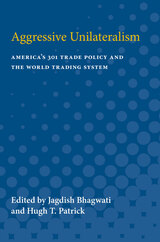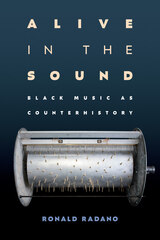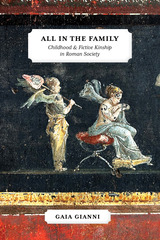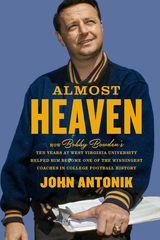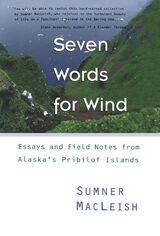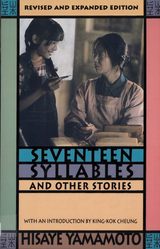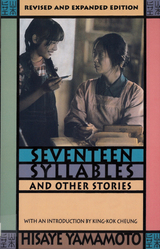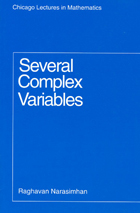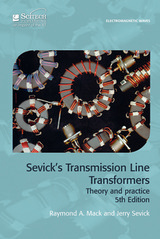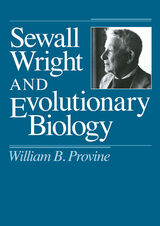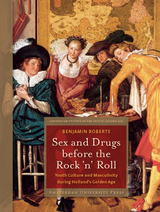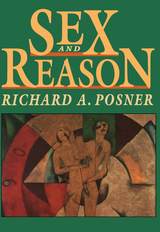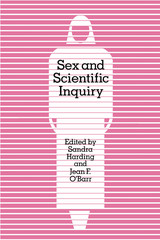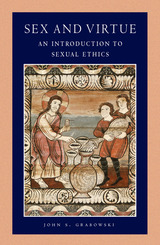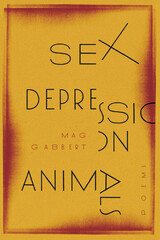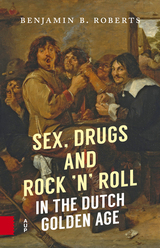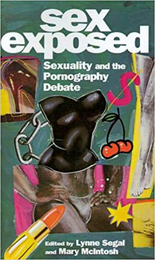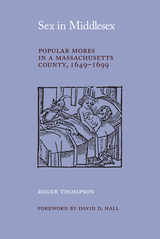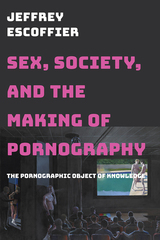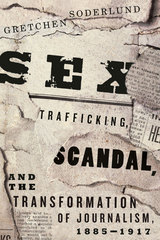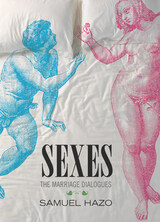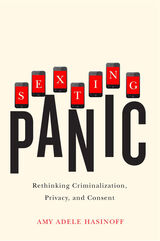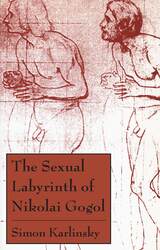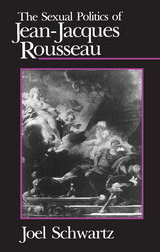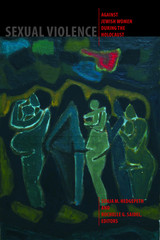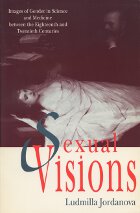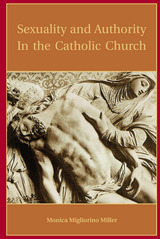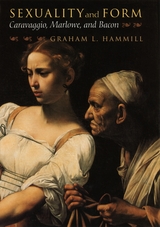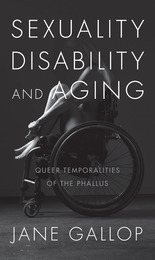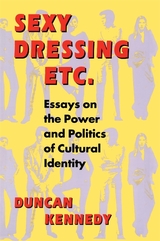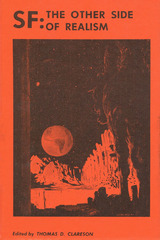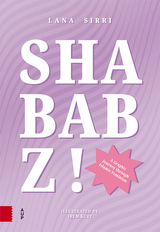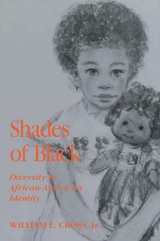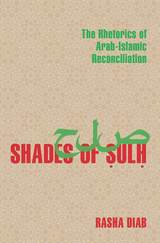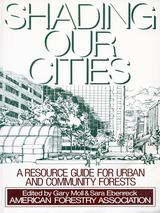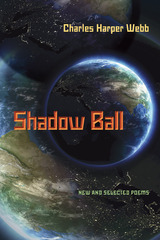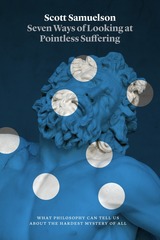 Seven Ways of Looking at Pointless Suffering: What Philosophy Can Tell Us about the Hardest Mystery of All
Scott Samuelson
University of Chicago Press, 2018 A reflection on the role of suffering in human existence.
It’s right there in the Book of Job: “Man is born unto trouble as the sparks fly upward.” Suffering is an inescapable part of the human condition—which leads to a question that has proved just as inescapable throughout the centuries: Why? Why do we suffer? Why do people die young? Is there any point to our pain, physical or emotional? Do horrors like hurricanes have meaning?
In Seven Ways of Looking at Pointless Suffering, Scott Samuelson tackles that hardest question of all. To do so, he travels through the history of philosophy and religion, but he also attends closely to the real world we live in. While always taking the question of suffering seriously, Samuelson is just as likely to draw lessons from Bugs Bunny as from Confucius, from his time teaching philosophy to prisoners as from Hannah Arendt’s attempts to come to terms with the Holocaust. He guides us through the arguments people have offered to answer this fundamental question, explores the many ways that we have tried to minimize or eliminate suffering, and examines people’s attempts to find ways to live with pointless suffering. Ultimately, Samuelson shows, to be fully human means to acknowledge a mysterious paradox: we must simultaneously accept suffering and oppose it. And understanding that is itself a step towards acceptance.
Wholly accessible, and thoroughly thought-provoking, Seven Ways of Looking at Pointless Suffering is a masterpiece of philosophy, returning the field to its roots—helping us see new ways to understand, explain, and live in our world, fully alive to both its light and its darkness.
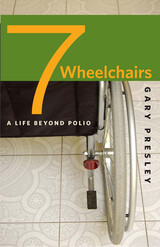 Seven Wheelchairs: A Life beyond Polio
Gary Presley
University of Iowa Press, 2008 In 1959, seventeen-year-old Gary Presley was standing in line, wearing his favorite cowboy boots and waiting for his final inoculation of Salk vaccine. Seven days later, a bad headache caused him to skip basketball practice, tell his dad that he was too ill to feed the calves, and walk from barn to bed with shaky, dizzying steps. He never walked again. By the next day, burning with the fever of polio, he was fastened into the claustrophobic cocoon of the iron lung that would be his home for the next three months. Set among the hardscrabble world of the Missouri Ozarks, sizzling with sarcasm and acerbic wit, his memoir tells the story of his journey from the iron lung to life in a wheelchair.
Presley is no wheelchair hero, no inspiring figure preaching patience and gratitude. An army brat turned farm kid, newly arrived in a conservative rural community, he was immobilized before he could take the next step toward adulthood. Prevented, literally, from taking that next step, he became cranky and crabby, anxious and alienated, a rolling responsibility crippled not just by polio but by anger and depression, “a crip all over, starting with the brain.” Slowly, however, despite the limitations of navigating in a world before the Americans with Disabilities Act, he builds an independent life.
Now, almost fifty years later, having worn out wheelchair after wheelchair, survived post-polio syndrome, and married the woman of his dreams, Gary has redefined himself as Gimp, more ready to act out than to speak up, ironic, perceptive, still cranky and intolerant but more accepting, more able to find joy in his family and his newfound religion. Despite the fact that he detests pity, can spot condescension from miles away, and refuses to play the role of noble victim, he writes in a way that elicits sympathy and understanding and laughter. By giving his readers the unromantic truth about life in a wheelchair, he escapes stereotypes about people with disabilities and moves toward a place where every individual is irreplaceable.
 Seven Wise Men of Colonial America
Richard M. Gummere
Harvard University Press Richard M. Gummere, writing with characteristic warmth and humor, explores the attitudes toward the classics of seven prominent colonial Americans--Hugh Jones, Robert Calef, Michael Wigglesworth, Samuel Davies, Henry Melhior Muhlenberg, Benjamin Rush, and Thomas Paine.
A companion volume to the author's The American Colonial Mind and the Classical Tradition, this book provides separate, absorbing biographies of these "seven wise men." Each of them was essentially pragmatic and judged the value of the classics not only on the basis of their intrinsic worth but also for their relevance to contemporary problems.
Hugh Jones--who advocated a practical training for the youth of Colonial Virginia--and Benjamin Rush questioned particularly the value of the classics as a requisite part of the school curriculum, although granting their importance for college admission and professional careers. Thomas Paine, openly skeptical about the wisdom of studying Greek and Latin in the original, scattered references in translation throughout his writings, so that he often seems to be "a classicist malgré lui."
Higglesworth, Davies, and Muhlenberg regarded the ancient languages as aids tothe understanding of Christian theology and as basic preparation for both the minister and the layman. Wigglesworth, at home in both ancient and modern literature, peppered his sermons with Latin quotations, but took care to keep his interpolations strictly subservient to the Gospel.
Some academicians and religious leaders adapted or even misinterpreted the classics in order to find in them support for various moralistic positions. Robert Calef opposed this disingenuousness and debated vigorously with Cotton Mather the evils of the Salem witch trial convictions, whose virtue Mather sought to prove by citing classical myths and legends. Calef raised a seemingly lone voice in his plea for a Christian policy of forbearance and understanding.
Seven Words for Wind: Essays and Field Notes from Alaska's Pribilof Islands
Sumner MacLeish
University of Alaska Press, 2008 Far off the coast of mainland Alaska lie the remote Pribilof Islands—a fiercely isolated wilderness surrounded by a wild, rich sea. The largest island, St. Paul, is just fourteen miles long and eight wide; despite its small size and relative self-enclosure, Sumner MacLeish lived and worked on the island, coming to love its rugged weather, abundant wildlife, and 600 native Aleuts. Her spare, imagistic prose illuminates the unforgiving darkness and unimaginable beauty of this subarctic landscape, and the pieces in Seven Words for Wind relate her own experience with attentive, open curiosity that finds light, humor, and companionship where it might least be expected.
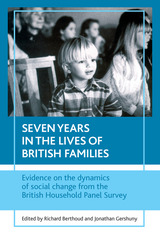 Seven years in the lives of British families: Evidence on the dynamics of social change from the British Household Panel Survey
Edited by Richard Berthoud and Jonathan Gershuny
Bristol University Press, 2000 'The family' is a subject of enormous academic, political and popular interest. It is a central feature of most people's lives, the framework within which other relationships, activities and events take place. This unique study provides important new insights into the dynamics of Britain's social and economic life - in family structures and relationships; in employment and household incomes; in housing, health and political affiliations. Most previous research has been limited to measuring an individual or family's position only at the time of the interview. This book presents a clearer picture by following the important events in people's lives, such as starting work, getting married, or falling into poverty. It reviews existing findings and presents new analyses of data from the British Household Panel Survey. The same 10,000 adults (in 5,000 households) have been interviewed every year between 1991 and 1997. Seven years in the lives of British families is a collaboration between members of the University of Essex's Institute for Social and Economic Research. Each of the authors is an expert in the field, but the work has been presented in an easy-to-read style to make these important research findings widely accessible. The book will be read by policy makers and all with an interest in the dynamics of modern society, as well as by academic sociologists, economists and demographers.
Seventeen Syllables and Other Stories
Yamamoto, Hisaye
Rutgers University Press, 2001 Seventeen Syllables and Other Stories brings together nineteen stories that span Hisaye Yamamoto's forty-year career. It was her first book to be published in the United States. Yamamoto's themes include the cultural conflicts between the first generation, the Issei, and their children, the Nisei; coping with prejudice; and the World War II internment of Japanese Americans.
In addition to the contents of the original volume, this edition brings back into print the following works:
- Death Rides the Rails to Poston
- Eucalyptus
- A Fire in Fontana
- Florentine Gardens
Seventeen Syllables and Other Stories
Yamamoto, Hisaye
Rutgers University Press, 2001 Seventeen Syllables and Other Stories brings together fifteen stories that span Hisaye Yamamoto's forty-year career. It was her first book to be published in the United States. Yamamoto's themes include the cultural conflicts between the first generation, the Issei and their children, the Nisei; coping with prejudice; and the World War II internment of Japanese Americans.
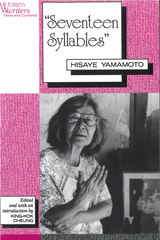 'Seventeen Syllables': Hisaye Yamamoto
Edited by King-Kok Cheung
Rutgers University Press, 1994 Hisaye Yamamoto's often reprinted tale of a naive American daughter and her Japanese mother captures the essence the cultural and generational conflicts so common among immigrants and their American-born children. On the surface, "Seventeen Syllables" is the story of Rosie and her preoccupation with adolescent life. Between the lines, however, lurks the tragedy of her mother, who is trapped in a marriage of desperation. Tome's deep absorption in writing haiku causes a rift with her husband, which escalates to a tragic event that changes Rosie's life forever.
Yamamoto's disarming style matches the verbal economy of haiku, in which all meaning is contained within seventeen syllables. Her deft characterizations and her delineations of sexuality create a haunting story of a young girl's transformation from innocence to adulthood.
This casebook includes an introduction and an essay by the editor, an interview with the author, a chronology, authoritative texts of "Seventeen Syllables" (1949) and "Yoneko's Earthquake" (1951), critical essays, and a bibliography. The contributors are Charles L. Crow, Donald C. Goellnicht, Elaine H. Kim, Dorothy Ritsuko McDonald, Zenobia Baxter Mistri, Katharine Newman, Robert M. Payne, Robert T. Rolf, and Stan Yogi.
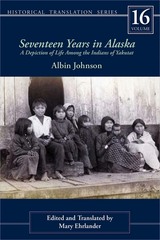 Seventeen Years in Alaska: A Depiction of Life Among the Indians of Yakutat
Albin Johnson
University of Alaska Press, 2014 Swedish missionary Albin Johnson arrived in Alaska just before the turn of the twentieth century, thousands of miles from home and with just two weeks’ worth of English classes under his belt. While he intended to work among the Tlingit tribes of Yakutat, he found himself in a wave of foreign arrivals as migrants poured into Alaska seeking economic opportunities and the chance at a different life. While Johnson came with pious intentions, others imposed Western values and vices, leaving disease and devastation in their wake.
Seventeen Years in Alaska is Johnson’s eyewitness account of this tumultuous time. It is a captivating narrative of an ancient people facing rapid change and of the missionaries working to stem a corrupting tide. His journals offer a candid look at the beliefs and lives of missionaries, and they ultimately reveal the profound effect that he and other missionaries had on the Tlingit. Tracing nearly two decades of spiritual hopes and earthbound failures, Johnson’s memoir is a fascinating portrait of a rapidly changing world in one of the most far-flung areas of the globe.
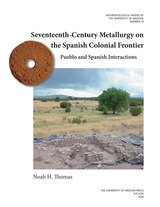 Seventeenth-Century Metallurgy on the Spanish Colonial Frontier: Pueblo and Spanish Interactions
Noah H. Thomas
University of Arizona Press, 2018 A unique contribution to the archaeological literature on the Southwest, Seventeenth-Century Metallurgy on the Spanish Colonial Frontier introduces a wealth of data from one of the few known colonial metal production sites in the Southwest. Archaeologist Noah H. Thomas draws on and summarizes ten seasons of excavation from the Pueblo of Paa-ko to provide a critical analysis of archaeological features and materials related to metal production during the early colonial period (AD 1598–1680). Extrapolating from the data, Thomas provides a theoretical interpretation of these data that is grounded in theories of agency, practice, and notions of value shaped in culture. In addition to the critical analysis of archaeological features and materials, this work brings to light a little-known aspect of the colonial experience: the production of metal by indigenous Pueblo people.
Using the ethnography of Pueblo peoples and seventh-century European manuals of metallurgy, Thomas addresses how the situated agency of indigenous practitioners incorporated within colonial industries shaped the metallurgy industry in the Spanish colonial period. The resulting analysis investigates how economic, technical, and social knowledge was communicated, contested, and transformed across the social and cultural boundaries present in early colonial communities. Viewing these transformations through an ethnohistorical lens, Thomas builds a social and historical context within which to understand the decisions made by colonial actors at the time.
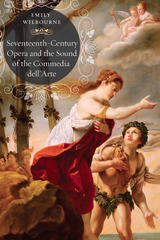 Seventeenth-Century Opera and the Sound of the Commedia dell’Arte
Emily Wilbourne
University of Chicago Press, 2016 In this book, Emily Wilbourne boldly traces the roots of early opera back to the sounds of the commedia dell’arte. Along the way, she forges a new history of Italian opera, from the court pieces of the early seventeenth century to the public stages of Venice more than fifty years later.
Wilbourne considers a series of case studies structured around the most important and widely explored operas of the period: Monteverdi’s lost L’Arianna, as well as his Il Ritorno d’Ulisse and L’incoronazione di Poppea; Mazzochi and Marazzoli’s L’Egisto, ovvero Chi soffre speri; and Cavalli’s L’Ormindo and L’Artemisia. As she demonstrates, the sound-in-performance aspect of commedia dell’arte theater—specifically, the use of dialect and verbal play—produced an audience that was accustomed to listening to sonic content rather than simply the literal meaning of spoken words. This, Wilbourne suggests, shaped the musical vocabularies of early opera and facilitated a musicalization of Italian theater.
Highlighting productive ties between the two worlds, from the audiences and venues to the actors and singers, this work brilliantly shows how the sound of commedia performance ultimately underwrote the success of opera as a genre.
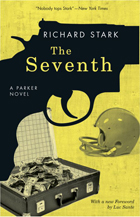 The Seventh: A Parker Novel
Richard Stark
University of Chicago Press, 2009 An action-packed crime novel starring Parker, the heister starring in the forthcoming Shane Black film Play Dirty!
Richard Stark's Parker novels are the hardest of hard-boiled, classic crime novels where the heists are huge, the body counts are high, and the bad guys usually win.
The Parker novels have been a huge influence on countless writers and filmmakers, including Quentin Tarantino, Stephen King, George Pelecanos, Colson Whitehead, Lucy Sante, John Banville, and many more. Their stripped-down language and hard-as-nails amorality create an unforgettable world where the next score could be the big one, but your next mistake could also be your last. There's nothing else like them.
The robbery was a piece of cake. The getaway was clean. The only thing left to do is split the cash—then it all goes wrong. In The Seventh, the heist of a college football game turns sour and the take is stolen from right under Parker’s nose. With the cops on his tail, Parker must figure out who crossed him—and how he can pay the culprit back.
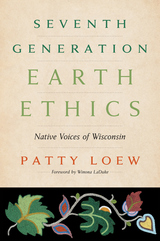 Seventh Generation Earth Ethics: Native Voices of Wisconsin
Patty Loew
Wisconsin Historical Society Press, 2025 Indigenous perspectives on sustainability, culture, and community
In this collection of twelve biographies, one from each of the Native nations in Wisconsin, author Patty Loew (Bad River Ojibwe) introduces readers to prominent figures in Native sustainability—people whose life’s work reflects the traditional ecological knowledge and cultural values of their people. Born out of Loew’s thirty years as a journalist and historian, Seventh Generation Earth Ethics highlights individuals who helped to sustain and nurture their nations. Walter Bresette, Red Cliff Ojibwe, community activist Hilary Waukau, Menominee, environmental warrior Frances Van Zile, Mole Lake (Sokaogon) Ojibwe, keeper of the water James Schlender, Lac Courte Oreilles Ojibwe, treaty rights guardian Jose Rose, Bad River Ojibwe, elder, environmentalist, and scholar Dorothy Davids, Stockbridge-Munsee Community Band of Mohican Indians, educator William Gollnick, Oneida, culture keeper Thomas St. Germaine, Lac du Flambeau Ojibwe, attorney Truman Lowe, Ho-Chunk, organic sculpture artist Jenny and Mary Thunder, Forest County Potawatomi, medicine women Wanda McFaggen, St. Croix Ojibwe, Tribal Historic Preservationist Caroline Andler, Brothertown Indian Nation, genealogist The indigenous people whose lives are depicted in Seventh Generation Earth Ethics understood the cultural gravity that kept their people rooted to their ancestral lands and acted in ways that ensured the growth and success of future generations.
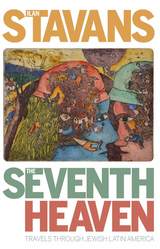 The Seventh Heaven: Travels Through Jewish Latin America
Ilan Stavans
University of Pittsburgh Press, 2019
2020 Natan Notable Book
Winner, 2020 Latino Book Awards Best Travel Book
Internationally renowned essayist and cultural commentator Ilan Stavans spent five years traveling from across a dozen countries in Latin America, in search of what defines the Jewish communities in the region, whose roots date back to Christopher Columbus’s arrival. In the tradition of V.S. Naipaul’s explorations of India, the Caribbean, and the Arab World, he came back with an extraordinarily vivid travelogue. Stavans talks to families of the desaparecidos in Buenos Aires, to “Indian Jews,” and to people affiliated with neo-Nazi groups in Patagonia. He also visits Spain to understand the long-term effects of the Inquisition, the American Southwest habitat of “secret Jews,” and Israel, where immigrants from Latin America have reshaped the Jewish state. Along the way, he looks for the proverbial “seventh heaven,” which, according to the Talmud, out of proximity with the divine, the meaning of life in general, and Jewish life in particular, becomes clearer. The Seventh Heaven is a masterful work in Stavans’s ongoing quest to find a convergence between the personal and the historical.
The Seventh Hero: Thomas Carlyle and the Theory of Radical Activism
Philip Rosenberg
Harvard University Press, 1974 Lionel Trilling has called The Seventh Hero “the best book that has yet been written about Thomas Carlyle.” In this provocative study, Philip Rosenberg dramatically reverses the standard interpretation of Carlyle. Concentrating on the fifteen-year period in Carlyle's career which culminated with the publication of The French Revolution, Chartism, and Past and Present, Rosenberg explores for the first time the radical dimension of Carlyle's works. He demonstrates that Carlyle's writings can be of considerable value in formulating a theory of radical activism. Indeed this study, which draws heavily on major political theorists from Hobbes through Hegel to Marx and Weber, is as much a contribution to political theory as it is to literary criticism.
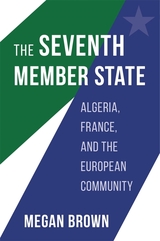 The Seventh Member State: Algeria, France, and the European Community
Megan Brown
Harvard University Press, 2022 The surprising story of how Algeria joined and then left the postwar European Economic Community and what its past inclusion means for extracontinental membership in today’s European Union.
On their face, the mid-1950s negotiations over European integration were aimed at securing unity in order to prevent violent conflict and boost economies emerging from the disaster of World War II. But French diplomats had other motives, too. From Africa to Southeast Asia, France’s empire was unraveling. France insisted that Algeria—the crown jewel of the empire and home to a nationalist movement then pleading its case to the United Nations—be included in the Treaty of Rome, which established the European Economic Community. The French hoped that Algeria’s involvement in the EEC would quell colonial unrest and confirm international agreement that Algeria was indeed French.
French authorities harnessed Algeria’s legal status as an official département within the empire to claim that European trade regulations and labor rights should traverse the Mediterranean. Belgium, Italy, Luxembourg, the Netherlands, and West Germany conceded in order to move forward with the treaty, and Algeria entered a rights regime that allowed free movement of labor and guaranteed security for the families of migrant workers. Even after independence in 1962, Algeria remained part of the community, although its ongoing inclusion was a matter of debate. Still, Algeria’s membership continued until 1976, when a formal treaty removed it from the European community.
The Seventh Member State combats understandings of Europe’s “natural” borders by emphasizing the extracontinental contours of the early union. The unification vision was never spatially limited, suggesting that contemporary arguments for geographic boundaries excluding Turkey and areas of Eastern Europe from the European Union must be seen as ahistorical.
 Seventh-day Adventism in Crisis: Gender and Sectarian Change in an Emerging Religion
Laura L. Vance
University of Illinois Press, 1999 As a "remnant of the remnant," Seventh-day Adventism's early years were distinguished by the leadership of women, most prominently the visionary and prophet Ellen White. However, after 1915 the number of Adventist women in leadership began a dramatic and uninterrupted decline that was not challenged until the 1980s.
Tracing the views of the church through its official and unofficial publications and through interviews with dozens of Adventist informants, Laura Vance reveals a significant shift around the turn of the century in women's roles advocated by the church: from active participation in the functioning, spiritual leadership, teaching, and evangelism of Adventism to an insistence on homemaking as a woman's sole proper vocation. These changes in attitude, Vance maintains, are inextricably linked to Adventism's shift from sect to church: in effect, to its maturation as a denomination.
Vance suggests that the reemergence of women in positions of influence within the church in recent decades should be viewed not as a concession to secular feminist developments but rather as a return to Adventism's earlier conception of gender roles. By examining changes in the movement's relationship with the world and with its own history, Seventh-day Adventism in Crisis offers a probing examination of how a sect founded on the leadership of women came to define women's roles in ways that excluded them from active public participation and leadership in the church.
 The Seventies Now: Culture as Surveillance
Stephen Paul Miller
Duke University Press, 1999 Most would agree that American culture changed dramatically from the 1960s to the 1980s. Yet the 1970s, the decade “in between,” is still somehow thought of as a cultural wasteland. In The Seventies Now Stephen Paul Miller debunks this notion by examining a wide range of political and cultural phenomena—from the long shadow cast by Richard Nixon and the Watergate scandal to Andy Warhol and the disco scene—identifying in these phenomena a pivotal yet previously unidentified social trend, the movement from institutionalized external surveillance to the widespread internalization of such practices.
The concept of surveillance and its attendant social ramifications have been powerful agents in U.S. culture for many decades, but in describing how during the 1970s Americans learned to “survey” themselves, Miller shines surprising new light on such subjects as the women’s movement, voting rights enforcement, the Ford presidency, and environmental legislation. He illuminates the significance of what he terms “microperiods” and analyzes relevant themes in many of the decade’s major films—such as The Deer Hunter, Network, Jaws, Star Wars, and Apocalypse Now—and in the literature of writers including John Ashbery, Toni Morrison, Adrienne Rich, and Sam Shepard. In discussing the reverberations of the 1969 Stonewall riots, technological innovations, the philosophy of Michel Foucault, and a host of documents and incidents, Miller shows how the 1970s marked an important period of transition, indeed a time of many transitions, to the world we confront at the end of the millennium.
The Seventies Now will interest students and scholars of cultural studies, American history, theories of technology, film and literature, visual arts, and gay and lesbian studies.
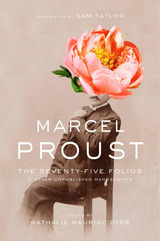 The Seventy-Five Folios and Other Unpublished Manuscripts
Marcel Proust
Harvard University Press, 2023 Presented for the first time in English, the recently discovered early manuscripts of the twentieth century’s most towering literary figure offer uncanny glimpses of his emerging genius and the creation of his masterpiece.
One of the most significant literary events of the century, the discovery of manuscript pages containing early drafts of Marcel Proust’s In Search of Lost Time put an end to a decades-long search for the Proustian grail. The Paris publisher Bernard de Fallois claimed to have viewed the folios, but doubts about their existence emerged when none appeared in the Proust manuscripts bequeathed to the Bibliothèque Nationale in 1962. The texts had in fact been hidden among Fallois’s private papers, where they were found upon his death in 2018. The Seventy-Five Folios and Other Unpublished Manuscripts presents these folios here for the first time in English, along with seventeen other brief unpublished texts. Extensive commentary and notes by the Proust scholar Nathalie Mauriac Dyer offer insightful critical analysis.
Characterized by Fallois as the “precious guide” to understanding Proust’s masterpiece, the folios contain early versions of six episodes included in the novel. Readers glimpse what Proust’s biographer Jean-Yves Tadié describes as the “sacred moment” when the great work burst forth for the first time. The folios reveal the autobiographical extent of Proust’s writing, with traces of his family life scattered throughout. Before the existence of Charles Swann, for example, we find a narrator named Marcel, a testament to what one scholar has called “the gradual transformation of lived experience into (auto)fiction in Proust’s elaboration of the novel.”
Like a painter’s sketches and a composer’s holographs, Proust’s folios tell a story of artistic evolution. A “dream of a book, a book of a dream,” Fallois called them. Here is a literary magnum opus finding its final form.
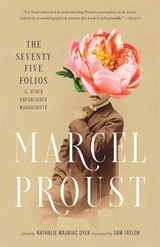 The Seventy-Five Folios and Other Unpublished Manuscripts
Marcel Proust
Harvard University Press A Washington Post Book That Shouldn’t Be Overlooked
“Fascinating…In these drafts, we see the emerging elements of the Recherche as through a glass darkly.” —The Telegraph
“If you delight in flickering recollections, glimpses and mirrors, hints and foreshadowings, this is, urgently, the book for you.” —Literary Review
“The fascinating, handwritten early drafts of Marcel Proust’s cycle In Search of Lost Time, discovered in 2018, come to life in Taylor’s resplendent translation…This is a magnificent addition to Proust’s oeuvre.” —Publishers Weekly
The discovery, in 2018, of manuscript pages containing early drafts of Marcel Proust’s In Search of Lost Time was one of the most significant literary events in living memory. The Seventy-Five Folios and Other Unpublished Manuscripts presents these fragments for the first time in English, along with seventeen other brief unpublished texts. Extensive commentary and notes by Proust scholar Nathalie Mauriac Dyer provide insightful critical analysis.
A precious guide to understanding Proust’s masterpiece, the folios include early versions of six episodes appearing in the novel. Readers also glimpse the autobiographical extent of Proust’s writing, with traces of his family life scattered throughout. Before the existence of Charles Swann, we find a narrator named Marcel, a testament to what one scholar has called “the gradual transformation of lived experience into (auto)fiction in Proust’s elaboration of the novel.”
Like a painter’s sketches and a composer’s holographs, Proust’s folios tell a story of artistic evolution. Here is a literary magnum opus finding its final form.
Several Complex Variables
Raghavan Narasimhan
University of Chicago Press, 1974 Drawn from lectures given by Raghavan Narasimhan at the University of Geneva and the University of Chicago, this book presents the part of the theory of several complex variables pertaining to unramified domains over C . Topics discussed are Hartogs' theory, domains in holomorphy, and automorphism of bounded domains.
Severalty: Poems
Laura Da'
University of Arizona Press, 2025 Severalty begins in a garden and moves through ancestral and contemporary hometowns that shimmer between wholeness and severing. In these poems, river currents tick with the intrusion of the clock’s lavish precincts. From powerfully compressed lyrical fragments to pulsing narrative sequences, Severalty shifts perspectives to examine devastation and healing, transience and seasonality, loss and resurrection.
With clear roots in her first two books of poetry, Tributaries and Instruments of the True Measure, this volume joins the author’s poetic trilogy with a deeply personal accounting of history, community, and selfhood.
Weaving the past and present into a stunning tapestry, this collection is a powerful testament to Indigenous endurance and creativity, offering readers a deeply insightful and necessary work.
Severance Songs
Joshua Corey
Tupelo Press, 2011 In his third full-length book of poems, Joshua Corey puts the sonnet to the test with this sequence of fractured, ventilated, and unrhymed poems written in the aftermath of 9/11 while Corey was living at a pastoral remove from war and terror in upstate New York. The tension between idyllic personal circumstances and horrific world-historical events led Corey to produce this series of layered poems, variously sardonic and sincere in tone.
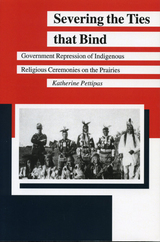 Severing the Ties that Bind: Government Repression of Indigenous Religious Ceremonies on the Prairies
Katherine Pettipas
University of Manitoba Press, 1994 Religious ceremonies were an inseparable part of Aboriginal traditional life, reinforcing social, economic, and political values. However, missionaries and government officials with ethnocentric attitudes of cultural superiority decreed that Native dances and ceremonies were immoral or un-Christian and an impediment to the integration of the Native population into Canadian society. Beginning in 1885, the Department of Indian Affairs implemented a series of amendments to the Canadian Indian Act, designed to eliminate traditional forms of religious expression and customs, such as the Sun Dance, the Midewiwin, the Sweat Lodge, and giveaway ceremonies.However, the amendments were only partially effective. Aboriginal resistance to the laws took many forms; community leaders challenged the legitimacy of the terms and the manner in which the regulations were implemented, and they altered their ceremonies, the times and locations, the practices, in an attempt both to avoid detection and to placate the agents who enforced the law.Katherine Pettipas views the amendments as part of official support for the destruction of indigenous cultural systems. She presents a critical analysis of the administrative policies and considers the effects of government suppression of traditional religious activities on the whole spectrum of Aboriginal life, focussing on the experiences of the Plains Cree from the mid-1880s to 1951, when the regulations pertaining to religious practices were removed from the Act. She shows how the destructive effects of the legislation are still felt in Aboriginal communities today, and offers insight into current issues of Aboriginal spirituality, including access to and use of religious objects held in museum repositories, protection of sacred lands and sites, and the right to indigenous religious practices in prison.
Sevick's Transmission Line Transformers: Theory and practice
Raymond A. Mack
The Institution of Engineering and Technology, 2014 The long awaited revision of the classic book Transmission Line Transformers, by Jerry Sevick, is now in its fifth edition and has been updated and reorganised by Raymond Mack to provide communication engineers with a clear technical presentation of both the theory and practical applications of the transmission of radio communication.
Seviyye Talip
Halide Edib Adivar
University of Texas Press, 2024 From the most acclaimed Turkish woman writer of the twentieth century comes a novel of violent political uprisings, opera, adultery, polygamy, modernity, liberty, and exile in the final years of the Ottoman Empire. Set in the early twentieth century, the novel follows Fahir, a philosopher, idealist, and reformist who graduates from Oxford University and returns to Istanbul after a voluntary (but possibly compulsory) exile. In the midst of political turmoil and social upheaval, Fahir finds himself embroiled in a love triangle with Macide, a traditional Muslim Turkish woman, and Seviyye, a rebellious Turkish soprano who defies social and religious norms. A bestseller in Turkey in 1910, the novel features the first-ever Turkish soprano protagonist and is interwoven with operatic references and landscapes from turn-of-the-century Istanbul and Cairo.
Sewall Wright and Evolutionary Biology
William B. Provine
University of Chicago Press, 1986 "Provine's thorough and thoroughly admirable examination of Wright's life and influence, which is accompanied by a very useful collection of Wright's papers on evolution, is the best we have for any recent figure in evolutionary biology."—Joe Felsenstein, Nature
"In Sewall Wright and Evolutionary Biology . . . Provine has produced an intellectual biography which serves to chart in considerable detail both the life and work of one man and the history of evolutionary theory in the middle half of this century. Provine is admirably suited to his task. . . . The resulting book is clearly a labour of love which will be of great interest to those who have a mature interest in the history of evolutionary theory."-John Durant, ;ITimes Higher Education Supplement;X
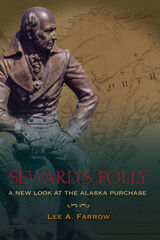 Seward's Folly: A New Look at the Alaska Purchase
Lee A. Farrow
University of Alaska Press, 2016 The Alaska Purchase—denounced at the time as “Seward’s Folly” but now seen as a masterstroke—is well known in American history. But few know the rest of the story.
This book aims to correct that. Lee Farrow offers here a detailed account of just what the Alaska Purchase was, how it came about, its impact at the time, and more. Farrow shows why both America and Russia had plenty of good reasons to want the sale to occur, including Russia’s desire to let go of an unprofitable, hard-to-manage colony and the belief in the United States that securing Alaska could help the nation gain control of British Columbia and generate closer trade ties with Asia . Farrow also delves into the implications of the deal for foreign policy and international diplomacy far beyond Russia and the United States at a moment when the global balance of power was in question.
A thorough, readable retelling of a story we only think we know, Seward’s Folly will become the standard book on the Alaska Purchase.
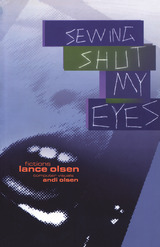 Sewing Shut My Eyes
Lance Olsen
University of Alabama Press, 2000 A tour-de-force avant-pop anti-spectacle Sewing Shut My Eyes is a tour-de-force avant-pop anti-spectacle—nine darkly satiric out-takes of America tubing. Visions of mid-air synchronicities, robotic cockroaches, cyborg poets and one monstrous HDTV, all rendered in a hypo-manic style of electrified clauses and full-throttle patter. Here's Mona Sausalito, self-proclaimed "fricking gorgeous" bad-little-girl for Escort a la Mode and, on the side, Neogoth lyricist in the band of her boyfriend Mosh ("His real name is Marvin Goldstein"). Mona wants to be a poet. "I write about human sacrifices, cannibalism, vampires, and stuff. Mosh loves my work. He says we're all going to be famous some day. Only right now we're not, which bites, cuz I've been writing for like almost ten months. These things take time, I guess." Olsen hallucinates a turned-on, channel-surfing nation where pain has become home theater and given enough channels, watching would beat sex. A nameless agent of the ultimate phantom bureaucracy holds his Yeltsin-70 at the ready and recalls O.J. on trial, supermodels and styrofoam landscapes, America screening fast and addictive. In the title story, Kerwin Penumbro wakes on his birthday to the ultimate tv, the renowned Mitsubishi Stealth, and at a point thirty-three thousand feet above the triangulation of Iron Lightning, Faith, and Thunder Butte, SD, Itty Snibb, supremely confident dwarf and prosperous entrepreneur, prepares to meet God. These are fictions for minds lit with cathode-ray tubes, hands pixilated with static, for bodies that have become switching stations for the Society of the Spectacle. The only thing left to do is start sewing shut our eyes.
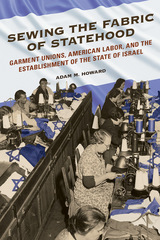 Sewing the Fabric of Statehood: Garment Unions, American Labor, and the Establishment of the State of Israel
Adam Howard
University of Illinois Press, 2017 Long a bastion of Jewish labor power, garment unions provided financial and political aid essential to founding and building the nation of Israel. Throughout the project, Jewish labor often operated outside of official channels as non-governmental organizations. Adam Howard explores the untold story of how three influential garment unions worked alone and with other Jewish labor organizations in support of a new Jewish state. Sewing the Fabric of Statehood reveals a coalition at work on multiple fronts. Sustained efforts convinced the AFL and CIO to support Jewish development in Palestine through land purchases for Jewish workers and encouraged the construction of trade schools and cultural centers. Other activists, meanwhile, directed massive economic aid to Histadrut, the General Federation of Jewish Workers in Palestine, or pressured the British and American governments to recognize Israel's independence. What emerges is a powerful account of the motivations and ideals that led American labor to forge its own foreign policy and reshape both the postwar world and Jewish history.
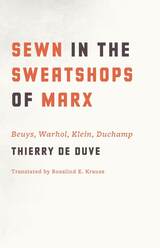 Sewn in the Sweatshops of Marx: Beuys, Warhol, Klein, Duchamp
Thierry de Duve
University of Chicago Press, 2012 Joseph Beuys, Andy Warhol, Yves Klein, and Marcel Duchamp form an unlikely quartet, but they each played a singular role in shaping a new avant-garde for the 1960s and beyond. Each of them staged brash, even shocking, events and produced works that challenged the way the mainstream art world operated and thought about itself. Distinguished philosopher Thierry de Duve binds these artists through another connection: the mapping of the aesthetic field onto political economy. Karl Marx provides the red thread tying together these four beautifully written essays in which de Duve treats each artist as a distinct, characteristic figure in that mapping. He sees in Beuys, who imagined a new economic system where creativity, not money, was the true capital, the incarnation of the last of the proletarians; he carries forward Warhol’s desire to be a machine of mass production and draws the consequences for aesthetic theory; he calls Klein, who staked a claim on pictorial space as if it were a commodity, “The dead dealer”; and he reads Duchamp as the witty financier who holds the secret of artistic exchange value. Throughout, de Duve expresses his view that the mapping of the aesthetic field onto political economy is a phenomenon that should be seen as central to modernity in art. Even more, de Duve shows that Marx—though perhaps no longer the “Marxist” Marx of yore—can still help us resist the current disenchantment with modernity’s many unmet promises. An intriguing look at these four influential artists, Sewn in the Sweatshops of Marx is an absorbing investigation into the many intertwined relationships between the economic and artistic realms.
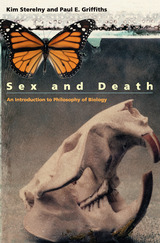 Sex and Death: An Introduction to Philosophy of Biology
Kim Sterelny and Paul E. Griffiths
University of Chicago Press, 1999 Is the history of life a series of accidents or a drama scripted by selfish genes? Is there an "essential" human nature, determined at birth or in a distant evolutionary past? What should we conserve—species, ecosystems, or something else?
Informed answers to questions like these, critical to our understanding of ourselves and the world around us, require both a knowledge of biology and a philosophical framework within which to make sense of its findings. In this accessible introduction to philosophy of biology, Kim Sterelny and Paul E. Griffiths present both the science and the philosophical context necessary for a critical understanding of the most exciting debates shaping biology today. The authors, both of whom have published extensively in this field, describe the range of competing views—including their own—on these fascinating topics.
With its clear explanations of both biological and philosophical concepts, Sex and Death will appeal not only to undergraduates, but also to the many general readers eager to think critically about the science of life.
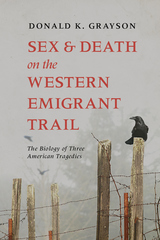 Sex and Death on the Western Emigrant Trail: The Biology of Three American Tragedies
Donald K. Grayson
University of Utah Press, 2018 During the winter of 1846–1847, members of the Donner Party found themselves stuck in the snows of the Sierra Nevada on their journey to California, losing many in their group to severe cold and starvation. Those who survived did so by cannibalizing their dead comrades. Today the Donner Party may be the most famous of American overland emigrant groups, but it was not the only one to face extreme conditions. Ten years after the Donner Party, two groups sponsored by the Mormon Church, the Willie and Martin handcart companies ran into similar difficulties. Unlike the Donner Party, however, these people were following a well-traveled path, but they were doing it in a novel way—pushing and pulling their goods and children in handcarts some 1,300 miles from Iowa to Utah. Caught in early winter storms in Wyoming, 200 members of these two companies died along the trail.
The plights of these emigrant groups have been addressed by different historians in different ways; this book is the first to examine the tragedies in terms of biology. Grayson shows that who lived or died can largely be explained by age, sex, and family ties. His investigation reveals what happens when our cultural mechanisms for dealing with famine and extreme cold are reduced to only what our bodies can provide within structured social contexts. His results are surprising and not always intuitive as he investigates who survived in these life threatening situations.
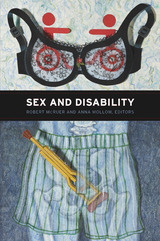 Sex and Disability
Robert McRuer and Anna Mollow, eds.
Duke University Press, 2012 The title of this collection of essays, Sex and Disability, unites two terms that the popular imagination often regards as incongruous. The major texts in sexuality studies, including queer theory, rarely mention disability, and foundational texts in disability studies do not discuss sex in much detail. What if "sex" and "disability" were understood as intimately related concepts? And what if disabled people were seen as both subjects and objects of a range of erotic desires and practices? These are among the questions that this collection's contributors engage. From multiple perspectives—including literary analysis, ethnography, and autobiography—they consider how sex and disability come together and how disabled people negotiate sex and sexual identities in ableist and heteronormative culture. Queering disability studies, while also expanding the purview of queer and sexuality studies, these essays shake up notions about who and what is sexy and sexualizable, what counts as sex, and what desire is. At the same time, they challenge conceptions of disability in the dominant culture, queer studies, and disability studies.
Contributors. Chris Bell, Michael Davidson, Lennard J. Davis, Michel Desjardins, Lezlie Frye, Rachael Groner, Kristen Harmon, Michelle Jarman, Alison Kafer, Riva Lehrer, Nicole Markotić, Robert McRuer, Anna Mollow, Rachel O’Connell, Russell Shuttleworth, David Serlin, Tobin Siebers, Abby L. Wilkerson
Sex and Drugs before Rock 'n' Roll: Youth Culture and Masculinity during Holland's Golden Age
Benjamin B. Roberts
Amsterdam University Press, 2012
Sex and Drugs Before the Rock ’n’ Roll is a fascinating volume that presents an engaging overview of what it was like to be young and male in the Dutch Golden Age. Here, well-known cohorts of Rembrandt are examined for the ways in which they expressed themselves by defying conservative values and norms. This study reveals how these young men rebelled, breaking from previous generations: letting their hair grow long, wearing colorful clothing, drinking excessively, challenging city guards, being promiscuous, smoking, and singing lewd songs.
Cogently argued, this study paints a compelling portrait of the youth culture of the Dutch Golden Age, at a time when the rising popularity of print made dissemination of new cultural ideas possible, while rising incomes and liberal attitudes created a generation of men behaving badly.
 Sex and Friendship in Baboons
Barbara B. Smuts
Harvard University Press, 1999 When it first appeared in the mid-1980s, this book transcended the traditional ethological focus on sexual interactions by analyzing male-female relationships outside the context of mating in a troop of wild baboons. Barbara Smuts used long-term friendships between males and females, documented over a two-year period, to show how social interactions between members of friendly pairs differed from those of other troop mates. Her findings, now enhanced with data from another fifteen years of field studies, suggest that the evolution of male reproductive strategies in baboons can only be understood by considering the relationship between sex and friendship: female baboons prefer to mate with males who have previously engaged in friendly interaction with them and their offspring. Smuts suggests that female choice may promote male investment in other species, and she explores the relevance of her findings for the evolution of male-female relationships in humans.
 Sex and Gender: Christian Ethical Reflections
Mary Jo Iozzio and Patricia Beattie Jung, Editors
Georgetown University Press Sex and Gender: Christian Ethical Reflections contains some of the subject’s most important analyses in recent decades. The collection covers a wide range of topics: same-sex marriage, sexual minorities and biblical interpretation, sex and power, sexual harassment and sexual abuse, HIV/AIDS and prevention strategy, the military and masculinities, mobile porn and sexting, human trafficking, moral discernment, and more. Contributors represent various theological traditions and draw on scriptural texts as well as such disciplines as philosophy, sociology, psychology, and the life sciences. Each essay is followed by a set of discussion questions—for the classroom or for students to use as an assignment outline—and suggestions for further reading and research. Teachers and students of Christian ethics will appreciate this multidisciplinary approach to one of the most divisive and controversial issues in contemporary culture.
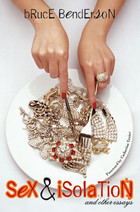 Sex and Isolation: And Other Essays
Bruce Benderson; Foreword by Catherine Texier
University of Wisconsin Press, 2007 Winner of France’s 2004 Prix de Flore for his memoir The Romanian: Story of an Obsession, Bruce Benderson has gained international respect for his controversial opinions and original take on contemporary society. In this collection of essays, Benderson directs his exceptional powers of observation toward some of the most debated, as well as some of the most neglected, issues of our day.
In Sex and Isolation, readers will encounter eccentric street people, Latin American literary geniuses, a French cabaret owner, a transvestite performer, and many other unusual characters; they’ll visit subcultures rarely described in writing and be treated to Benderson’s iconoclastic opinions about culture in former and contemporary urban society. Whether proposing new theories about the relationship between art, entertainment, and sex, analyzing the rise of the Internet and the disappearance of public space, or considering how religion and sexual identity interact, each essay demonstrates sharp wit, surprising insight and some startling intellectual positions.
This is the first American volume of Benderson’s collected essays, featuring both new work and some of his best-known writings, including his famous essay “Toward the New Degeneracy.” Outstanding University Press Book selection, Foreword Magazine
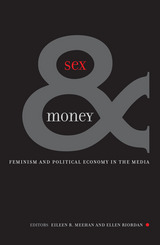 Sex And Money: Feminism and Political Economy in the Media
Eileen R. Meehan
University of Minnesota Press, 2001 A revelatory look at the ways that gender, power, and the media are intertwined. It all comes down to sex and money: how the media are organized, how they work, what they say, who gets to say it and to whom. That is the message this book delivers—and then parses for its meaning to society and culture. Forcefully and persuasively, this groundbreaking volume uses the media to show how questions of gender and economics are inextricably linked to issues of power in Western capitalist societies. Integrating political economy and feminism, it offers a new understanding of communication at the personal, experiential, institutional, and structural levels-and exposes all the subtle and complex ways in which sex and money are sutured into individuals’ daily lives. Contributors: Robin Andersen, Fordham U; Ellen Balka, Simon Fraser U; Amy Beer; Carolyn M. Byerly, Ithaca College; Ramona Curry, U of Illinois; Fred Fejes, Florida Atlantic U; Nancy Hauserman, U of Iowa; Michèle Martin, Carleton U, Canada; Stana Martin, Central Missouri State U; Lisa McLaughlin, Miami U, Ohio; Roopali Mukherjee, Indiana U; Angela R. Record; Karen Ross, Coventry U; H. Leslie Steeves, U of Oregon; Angharad N. Valdivia, U of Illinois; Janet Wasko, U of Oregon; and Justin Wyatt.
Sex and Reason
Richard A. Posner
Harvard University Press, 1992 Sexual drives are rooted in biology, but we don’t act on them blindly. Indeed, as the eminently readable judge and legal scholar Richard Posner shows, we make quite rational choices about sex, based on the costs and benefits perceived.
Drawing on the fields of biology, law, history, religion, and economics, this sweeping study examines societies from ancient Greece to today’s Sweden and issues from masturbation, incest taboos, date rape, and gay marriage to Baby M. The first comprehensive approach to sexuality and its social controls, Posner’s rational choice theory surprises, explains, predicts, and totally absorbs.
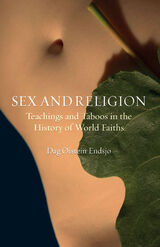 Sex and Religion: Teachings and Taboos in the History of World Faiths
Dag Ølstein Endsjø
Reaktion Books, 2011 Sex and religion are inevitably and intricately linked. There are few realms of human experience other than sex in which religion has greater reach and influence. The role of religion, of any faith, to prohibit, regulate, condemn, and reward, is unavoidably prominent in questions of sex—namely with whom, when, how, and why. In Sex and Religion, Dag Øistein Endsjø examines the myriad and complex religious attitudes towards sex in cultures throughout the world. Endsjø reflects on some of the most significantly problematic areas in the relationship between sex and religion—from sex before or outside of marriage to homosexuality. Through many examples from world religions, he outlines what people mean by sex in a religious context, with whom it’s permissible to have sex, how sex can be a directly religious experience, and what consequences there are for deviance, for both the individual and society. As Endsjø explains, while Buddhist monks call attention to gay sex as a holy mystery, the Christian church questions a homosexual’s place in the church. Some religions may believe that promiscuity leads to hurricanes and nuclear war, and in others God condemns interracial marriage. Sex and Religion reveals there is nothing natural or self-evident about the ways in which various religions prescribe or proscribe and bless or condemn different types of sexuality. Whether sex becomes sacred or abhorrent depends entirely on how a religion defines it. Sex and Religion is a fascinating investigation of mores, meanings, rituals, and rules in many faiths around the globe, and will be of interest to anyone curious about the intersection of these fundamental aspects of human history and experience.
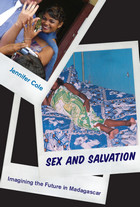 Sex and Salvation: Imagining the Future in Madagascar
Jennifer Cole
University of Chicago Press, 2010 Sex and Salvation chronicles the coming of age of a generation of women in Tamatave in the years that followed Madagascar’s economic liberalization. Eager to forge a viable future amid poverty and rising consumerism, many young women have entered the sexual economy in hope of finding a European husband. Just as many Westerners believe that young people break with the past as they enter adulthood, Malagasy citizens fear that these women have severed the connection to their history and culture.
Jennifer Cole’s elegant analysis shows how this notion of generational change is both wrong and consequential. It obscures the ways young people draw on long-standing ideas of gender and sexuality, it ignores how urbanites relate to their rural counterparts, and it neglects the relationship between these husband-seeking women and their elders who join Pentecostal churches. And yet, as talk about the women circulates through the city’s neighborhoods, bars, Internet cafes, and churches, it teaches others new ways of being.
Cole’s sophisticated depiction of how a generation’s coming of age contributes to social change eschews a narrow focus on crisis. Instead, she reveals how fantasies of rupture and conceptions of the changing life course shape the everyday ways that people create the future.
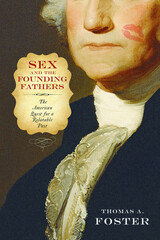 Sex and the Founding Fathers: The American Quest for a Relatable Past
Thomas A. Foster
Temple University Press, 2016 Biographers, journalists, and satirists have long used the subject of sex to define the masculine character and political authority of America's Founding Fathers. Tracing these commentaries on the Revolutionary Era's major political figures in Sex and the Founding Fathers, Thomas Foster shows how continual attempts to reveal the true character of these men instead exposes much more about Americans and American culture than about the Founders themselves. Sex and the Founding Fathers examines the remarkable and varied assessments of the intimate lives of George Washington, Thomas Jefferson, John Adams, Benjamin Franklin, Alexander Hamilton, and Gouverneur Morris from their own time to ours. Interpretations can change radically; consider how Jefferson has been variously idealized as a chaste widower, condemned as a child molester, and recently celebrated as a multicultural hero. Foster considers the public and private images of these generally romanticized leaders to show how each generation uses them to reshape and reinforce American civic and national identity.
 Sex and the Gender Revolution, Volume 1: Heterosexuality and the Third Gender in Enlightenment London
Randolph Trumbach
University of Chicago Press, 1998 A revolution in gender relations occurred in London around 1700, resulting in a sexual system that endured in many aspects until the sexual revolution of the 1960s. For the first time in European history, there emerged three genders: men, women, and a third gender of adult effeminate sodomites, or homosexuals. This third gender had radical consequences for the sexual lives of most men and women since it promoted an opposing ideal of exclusive heterosexuality.
In Sex and the Gender Revolution, Randolph Trumbach reconstructs the worlds of eighteenth-century prostitution, illegitimacy, sexual violence, and adultery. In those worlds the majority of men became heterosexuals by avoiding sodomy and sodomite behavior.
As men defined themselves more and more as heterosexuals, women generally experienced the new male heterosexuality as its victims. But women—as prostitutes, seduced servants, remarrying widows, and adulterous wives— also pursued passion. The seamy sexual underworld of extramarital behavior was central not only to the sexual lives of men and women, but to the very existence of marriage, the family, domesticity, and romantic love. London emerges as not only a geographical site but as an actor in its own right, mapping out domains where patriarchy, heterosexuality, domesticity, and female resistance take vivid form in our imaginations and senses.
As comprehensive and authoritative as it is eloquent and provocative, this book will become an indispensable study for social and cultural historians and delightful reading for anyone interested in taking a close look at sex and gender in eighteenth-century London.
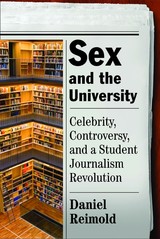 Sex and the University: Celebrity, Controversy, and a Student Journalism Revolution
Reimold, Daniel
Rutgers University Press, 2010 Who would think that Monday morning's page-turning sports scores could be trumped by Sex on Tuesday? But, during the last decade or so, college newspaper sex columns and campus sex magazines have revolutionized student journalism and helped define a new sexual generation. They are the ultimate authorities on student social interaction, relationships, and sex at a time when sexual activity, sexual dangers, and sexual ignorance are prevalent and sex has become the wallpaper of students' lives.
Daniel Reimold gives readers of all generations an inside look at this phenomenon. Student sex columnists and sex magazine editors are both celebrities on their home campuses. One columnist, echoing the sentiments of many, said he became an overnight rock star golden child of journalism. But, with celebrity comes controversy. These columns and magazines have sparked contentious and far-reaching legal, religious, and intergenerational debates about sex, the student press, and the place of both within higher education. They are also the most prominent modern student press combatants in the fight for free speech. And they have blurred journalistic boundaries between what is considered public and private, art and pornography, and gossip and news.
Sex and the University explores the celebrity status that student sex columnists and magazine editors have received, the controversies they have caused, and the sexual generation and student journalism revolution they represent. Complete with a sexicon of slang, this book also dives into the columns and magazines themselves, sharing for the first time what modern students are saying about their sex and love lives, in their own words.
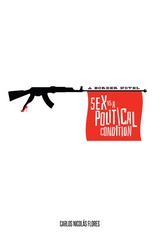 Sex as a Political Condition: A Border Novel
Carlos Nicolás Flores
Texas Tech University Press, 2015 Sex as a Political Condition: A Border Novel is a raucous, hilarious journey through political dangers that come in all shapes, cup sizes, and sexual identities, a trip into the wild, sometimes outrageous world of the Texas-Mexico border and all geographical and anatomical points south.
Honoré del Castillo runs the family curio shop in the backwater border town of Escandón, Texas, and fears dying in front of his TV like some six-pack José in his barrio. Encouraged by his friend Trotsky, he becomes politically active—smuggling refugees, airlifting guns to Mexican revolutionaries, negotiating with radical Chicana lesbians—but the naked truths he faces are more often naked than true and constantly threaten to unman him. When a convoy loaded with humanitarian aid bound for Nicaragua pulls into Escandón, his journey to becoming a true revolutionary hero begins, first on Escandón’s international bridge and then on the highways of Mexico. But not until both the convoy and Honoré’s mortality and manhood are threatened in Guatemala does he finally confront the complications of his love for his wife and daughter, his political principles, the stench of human fear, and ultimately what it means to be a principled man in a screwed-up world.
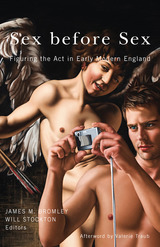 Sex before Sex: Figuring the Act in Early Modern England
James M. Bromley
University of Minnesota Press, 2013
What is sex exactly? Does everyone agree on a definition? And does that definition hold when considering literary production in other times and places? Sex before Sex makes clear that we cannot simply transfer our contemporary notions of what constitutes a sex act into the past and expect them to be true for the people who were then reading literature and watching plays. The contributors confront how our current critical assumptions about definitions of sex restrict our understanding of representations of sexuality in early modern England.
Drawing attention to overlooked forms of sexual activity in early modern culture, from anilingus and interspecies sex to “chin-chucking” and convivial drinking, Sex before Sex offers a multifaceted view of what sex looked like before the term entered history. Through incisive interpretations of a wide range of literary texts, including Romeo and Juliet, The Comedy of Errors, Paradise Lost, the figure of Lucretia, and pornographic poetry, this collection queries what might constitute sex in the absence of a widely accepted definition and how a historicized concept of sex affects the kinds of arguments that can be made about early modern sexualities. Contributors: Holly Dugan, George Washington U; Will Fisher, CUNY–Lehman College; Stephen Guy-Bray, U of British Columbia; Melissa J. Jones, Eastern Michigan U; Thomas H. Luxon, Dartmouth College; Nicholas F. Radel, Furman U; Kathryn Schwarz, Vanderbilt U; Christine Varnado, U of Buffalo–SUNY.
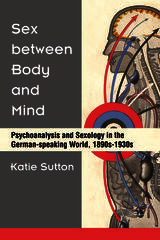 Sex between Body and Mind: Psychoanalysis and Sexology in the German-speaking World, 1890s-1930s
Katie Sutton
University of Michigan Press, 2019 Ideas about human sexuality and sexual development changed dramatically across the first half of the 20th century. As scholars such as Magnus Hirschfeld, Iwan Bloch, Albert Moll, and Karen Horney in Berlin and Sigmund Freud, Wilhelm Stekel, and Helene Deutsch in Vienna were recognized as leaders in their fields, the German-speaking world quickly became the international center of medical-scientific sex research—and the birthplace of two new and distinct professional disciplines, sexology and psychoanalysis.
This is the first book to closely examine vital encounters among this era’s German-speaking researchers across their emerging professional and disciplinary boundaries. Although psychoanalysis was often considered part of a broader “sexual science,” sexologists increasingly distanced themselves from its mysterious concepts and clinical methods. Instead, they turned to more pragmatic, interventionist therapies—in particular, to the burgeoning field of hormone research, which they saw as crucial to establishing their own professional relevance. As sexology and psychoanalysis diverged, heated debates arose around concerns such as the sexual life of the child, the origins and treatment of homosexuality and transgender phenomena, and female frigidity. This new story of the emergence of two separate approaches to the study of sex demonstrates that the distinctions between them were always part of a dialogic and competitive process. It fundamentally revises our understanding of the production of modern sexual subjects.
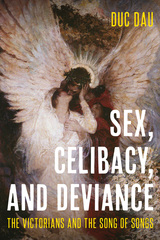 Sex, Celibacy, and Deviance: The Victorians and the Song of Songs
Duc Dau
Ohio State University Press, 2024 Sex, Celibacy, and Deviance is the first major study to explore the Song of Songs (or Song of Solomon) in Victorian literature and art. As the Bible’s only erotic poem, the Song of Songs is the canonical Judeo-Christian book about love, furnishing the Victorians with an authoritative and literary language for love, marriage, sex, mourning, and religious celibacy.
Duc Dau adopts a queer and feminist lens to consider how Victorians employed and interpreted the Song of Songs in their work. How did writers and artists fashion and, most importantly, challenge the norms of gender, romantic love, and marriage? Spanning the early Victorian era through the first two decades of the twentieth century, Sex, Celibacy, and Deviance considers the works of Charlotte Brontë, Thomas Hardy, Christina Rossetti, John Gray, Michael Field, Edward Burne-Jones, and Simeon Solomon alongside two lesser-known figures: Irish-born Scottish artist Phoebe Anna Traquair and the Catholic religious leader Augusta Theodosia Drane. By addressing the relevance of the Song of Songs in light of shifting and conflicting religious and social contexts, Dau provides a fresh perspective on Victorian literature, religion, and culture.
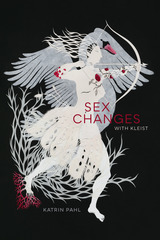 Sex Changes with Kleist
Katrin Pahl
Northwestern University Press, 2019 Sex Changes with Kleist analyzes how the dramatist and poet Heinrich von Kleist (1777–1811) responded to the change in the conception of sex and gender that occurred in the eighteenth century. Specifically, Katrin Pahl shows that Kleist resisted the shift from a one-sex to the two-sex and complementary gender system that is still prevalent today. With creative close readings engaging all eight of his plays, Pahl probes Kleist’s appreciation for incoherence, his experimentation with alternative symbolic orders, his provocative understanding of emotion, and his camp humor. Pahl demonstrates that rather than preparing modern homosexuality, Kleist puts an end to modern gender norms even before they take hold and refuses the oppositional organization of sexual desire into homosexual and heterosexual that sprouts from these norms.
Focusing on the theatricality of Kleist’s interventions in the performance of gender, sexuality, and emotion and examining how his dramatic texts unhinge major tenets of classical European theater, Sex Changes with Kleist is vital reading for anyone interested in queer studies, feminist studies, performance studies, literary studies, or emotion studies. This book changes our understanding of Kleist and breathes new life into queer thought.
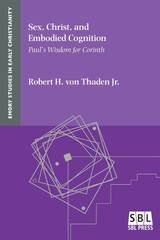 Sex, Christ, and Embodied Cognition: Paul's Wisdom for Corinth
Robert H. von Thaden Jr.
SBL Press, 2017 A sociorhetorical analysis of First Corinthians Robert H. von Thaden Jr.'s sociorhetorical analysis examines Paul's construction of sexual Christian bodies in First Corinthians by utilizing new insights from conceptual integration (blending) theory about the embodied processes of meaning making. Paul's teaching about proper sexual behavior in this letter is best viewed as an example of early Christian wisdom discourse. This discourse draws upon apocalyptic and priestly cognitive frames to increase the rhetorical force of the argument. Reading Paul's argument through the lens of rhetorical invention, von Thaden demonstrates that Paul first attempts to show the Corinthians why sexual immorality is the worst of all bodily sins before shifting rhetorical focus to explain to them how they can best avoid this infraction against the body of Christ. Features: - A programmatic application of conceptual integration theory using a sociorhetorical mode of interpretation
- A vivid account of key aspects of conceptual integration theory and how they function in sociorhetorical interpretation
- A detailed application of these strategies to interpret 1 Corinthians 1-4; 6:12-7:7
 Sex, Contraception, and Motherhood in Jamaica
Eugene B. Brody
Harvard University Press, 1981 This book is the first to offer a combined social science and psychoanalytic perspective on reproductive behavior. The author emphasizes the personal histories of his subjects within their cultural environment, and takes into account the setting of the interview and the subjective responses of both interviewee and interviewer. The study reveals how Jamaicans, particularly women, relate to their own parents, learn about sex, experience sexual maturity and first intercourse, and perceive their relations with subsequent partners. Other themes examined are the significance of pregnancy, childbirth, and parenthood and the folk context of Jamaican beliefs about reproduction and contraception.
All of these are aspects of what the author terms a “culture of motherhood.” His unique approach illuminates the many complex factors that influence this population's use or nonuse of contraceptive methods. In his concluding chapter, Eugene Brody offers suggestions for reconciling the private needs of individuals and the public goals of Jamaican population policy. Although his research centers on one Caribbean island, his ideas are applicable to other developing countries. In Sex, Contraception, and Motherhood in Jamaica, family planning professionals, psychologists, psychiatrists, and social scientists will find an intriguing new approach to reproductive policy.
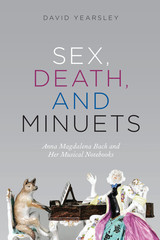 Sex, Death, and Minuets: Anna Magdalena Bach and Her Musical Notebooks
David Yearsley
University of Chicago Press, 2019 At one time a star in her own right as a singer, Anna Magdalena (1701–60) would go on to become, through her marriage to the older Johann Sebastian Bach, history’s most famous musical wife and mother. The two musical notebooks belonging to her continue to live on, beloved by millions of pianists young and old. Yet the pedagogical utility of this music—long associated with the sound of children practicing and mothers listening—has encouraged a rosy and one-sided view of Anna Magdalena as a model of German feminine domesticity.
Sex, Death, and Minuets offers the first in-depth study of these notebooks and their owner, reanimating Anna Magdalena as a multifaceted historical subject—at once pious and bawdy, spirited and tragic. In these pages, we follow Magdalena from young and flamboyant performer to bereft and impoverished widow—and visit along the way the coffee house, the raucous wedding feast, and the family home. David Yearsley explores the notebooks’ more idiosyncratic entries—like its charming ditties on illicit love and searching ruminations on mortality—against the backdrop of the social practices and concerns that women shared in eighteenth-century Lutheran Germany, from status in marriage and widowhood, to fulfilling professional and domestic roles, money, fashion, intimacy and sex, and the ever-present sickness and death of children and spouses. What emerges is a humane portrait of a musician who embraced the sensuality of song and the uplift of the keyboard, a sometimes ribald wife and oft-bereaved mother who used her cherished musical notebooks for piety and play, humor and devotion—for living and for dying.
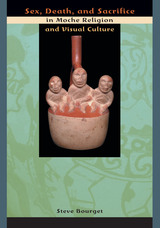 Sex, Death, and Sacrifice in Moche Religion and Visual Culture
By Steve Bourget
University of Texas Press, 2006 The Moche people who inhabited the north coast of Peru between approximately 100 and 800 AD were perhaps the first ancient Andean society to attain state-level social complexity. Although they had no written language, the Moche created the most elaborate system of iconographic representation of any ancient Peruvian culture. Amazingly realistic figures of humans, animals, and beings with supernatural attributes adorn Moche pottery, metal and wooden objects, textiles, and murals. These actors, which may have represented both living individuals and mythological beings, appear in scenes depicting ritual warfare, human sacrifice, the partaking of human blood, funerary rites, and explicit sexual activities. In this pathfinding book, Steve Bourget raises the analysis of Moche iconography to a new level through an in-depth study of visual representations of rituals involving sex, death, and sacrifice. He begins by drawing connections between the scenes and individuals depicted on Moche pottery and other objects and the archaeological remains of human sacrifice and burial rituals. He then builds a convincing case for Moche iconography recording both actual ritual activities and Moche religious beliefs regarding the worlds of the living, the dead, and the afterlife. Offering a pioneering interpretation of the Moche worldview, Bourget argues that the use of symbolic dualities linking life and death, humans and beings with supernatural attributes, and fertility and social reproduction allowed the Moche to create a complex system of reciprocity between the world of the living and the afterworld. He concludes with an innovative model of how Moche cosmological beliefs played out in the realms of rulership and political authority.
Sex Depression Animals: Poems
Mag Gabbert
Ohio State University Press, 2023 In SEX DEPRESSION ANIMALS,Mag Gabbert redefines the bestiary in fiery, insistent, and resistant terms. These poems recast the traumas of her adolescence while charting new paths toward linguistic and bodily autonomy as an adult. Using dreamlike, shimmering imagery, she pieces together a fractured portrait of femininity—one that electrifies the confessional mode with its formal play and rich curiosity. Gabbert examines the origin of shame, the role of inheritance, and what counts as a myth, asking, “What’s the opposite of a man? / A woman? A wound? The devil’s image?”
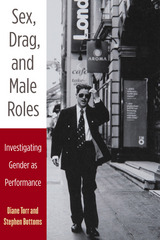 Sex, Drag, and Male Roles: Investigating Gender as Performance
Diane Torr and Stephen Bottoms
University of Michigan Press, 2010 "Few books blend the critical and creative approaches to drag performance this provocatively and engagingly, and none provides both the historical and the personal perspectives so effectively. Torr and Bottoms fundamentally challenge many long-standing ideas about drag kings and the performance of masculinity."
---Sarah Bay-Cheng, University at Buffalo "This book brings the reader inside an artist's creative imagination and intellect, showing us Diane Torr's work in a detailed, thoughtful, and engaging way. We discover how Torr uses different physical disciplines to explore how gender is constructed, interpreted, and expressed. Along the way---by taking us into various venues in which she performed---she evokes the lively, dynamic scene in New York in the '80s and '90s."
---Alisa Solomon, Columbia University Why would women want to perform as men? Why is gender crossing so compelling, whether it happens onstage or in everyday life? What can drag performance teach, and what aesthetic, political, and personal questions does it raise? Performance artist Diane Torr has been experimenting with the performance of gender for thirty years---exploring everything from feminist go-go dancing to masculine power play. One of the key pioneers of "drag king" performance, Torr has been celebrated internationally for her gender transformation workshops, in which she has taught hundreds of ordinary women how to pass as men on city streets around the world. This cultural subterfuge appeals to participants for many different reasons: personal confidence-building, sexual frisson, gender subversion, trans-curiosity, or simply the appeal of disguise and role play. Sex, Drag, and Male Roles documents the evolution of Torr's work by blending first-person memoir and commentary from Torr with critical reflections and contextualization from leading performance critic Stephen J. Bottoms. The book includes a consideration of the long cultural history of female-to-male cross-dressing and concludes with Torr's "Do-It-Yourself" guide to becoming a "Man for a Day." Diane Torr developed her cross-disciplinary art in the downtown New York art scene from 1976 to 2002. Now living in Scotland, Torr has earned an international reputation for her performances and gender transformation workshops (featured on HBO, BBC, and This American Life on NPR, among others). Her work is the focus of a feature film, Man for a Day. Stephen J. Bottoms is Wole Soyinka Professor of Drama and Theatre Studies at the University of Leeds. His books include Playing Underground: A Critical History of the 1960s Off-Off-Broadway Movement and Small Acts of Repair: Performance, Ecology, and Goat Island. Cover: Diane Torr walks the streets of London, 1995. Photo by Debbie Humphreys.
 Sex, Drugs and Rock ’n’ Roll in Rembrandt’s Time
Benjamin Roberts
Amsterdam University Press, 2024 Sex, Drugs and Rock 'n' Roll in Rembrandt’s Time focuses on the generation of rich young men that grew up in the seventeenth century in the Dutch Republic. These men had more money to spend on clothes, music, and recreation than the generation before them. This fascinating account of male adolescence in the Dutch Republic reveals how young men including Rembrandt van Rijn disregarded conservative values and rebelled against the older generation, and consequently created a new youth culture that was similar to the one of the 1960s. They had long hair, wore colorful and extravagant clothing, and started taking drugs. Theirs was the first generation in European history to smoke tobacco. Moreover, they defied conventional norms and values with their promiscuity and by singing lewd songs in their free time.
With his engaging storytelling-style filled with humorous anecdotes, Roberts convincingly shows how deviant male youth behavior is a feature of all ages, especially in periods when youngsters have too much free time and money.
Sex, Drugs and Rock 'n' Roll in the Dutch Golden Age
Benjamin B. Roberts
Amsterdam University Press, 2018 Binge drinking and illicit sex were just as common in the Dutch Golden Age as they are today, if not more so. Sex, Drugs and Rock 'n' Roll in the Dutch Golden Age is a compelling narrative about the generation of young men that came of age in the Dutch Republic during the economic boom of the early seventeenth century. Contrary to their parents' wishes, the younger generation grew up in luxury and wore extravagant clothing, grew their hair long, and squandered their time drinking and smoking. They created a new youth culture with many excesses; one that we today associate with the counterculture generation of the 1960s.
With his engaging storytelling style and humorous anecdotes, Roberts convincingly reveals that deviant male youth behavior is common to all times, especially periods when youngsters have too much money and too much free time on their hands.
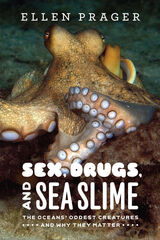 Sex, Drugs, and Sea Slime: The Oceans' Oddest Creatures and Why They Matter
Ellen Prager
University of Chicago Press, 2011 When viewed from a quiet beach, the ocean, with its rolling waves and vast expanse, can seem calm, even serene. But hidden beneath the sea’s waves are a staggering abundance and variety of active creatures, engaged in the never-ending struggles of life—to reproduce, to eat, and to avoid being eaten.
With Sex, Drugs, and Sea Slime, marine scientist Ellen Prager takes us deep into the sea to introduce an astonishing cast of fascinating and bizarre creatures that make the salty depths their home. From the tiny but voracious arrow worms whose rapacious ways may lead to death by overeating, to the lobsters that battle rivals or seduce mates with their urine, to the sea’s masters of disguise, the octopuses, Prager not only brings to life the ocean’s strange creatures, but also reveals the ways they interact as predators, prey, or potential mates. And while these animals make for some jaw-dropping stories—witness the sea cucumber, which ejects its own intestines to confuse predators, or the hagfish that ties itself into a knot to keep from suffocating in its own slime—there’s far more to Prager’s account than her ever-entertaining anecdotes: again and again, she illustrates the crucial connections between life in the ocean and humankind, in everything from our food supply to our economy, and in drug discovery, biomedical research, and popular culture.
Written with a diver’s love of the ocean, a novelist’s skill at storytelling, and a scientist’s deep knowledge, Sex, Drugs, and Sea Slime enchants as it educates, enthralling us with the wealth of life in the sea—and reminding us of the need to protect it.
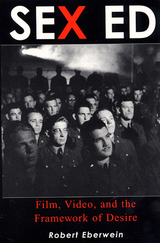 Sex Ed: Film, Video, and the Framework of Desire
Eberwein, Robert
Rutgers University Press, 1999 In a 1914 movie, Damaged Goods, a doctor shows a character the horrific effects of venereal disease. In contrast, many of today's sex ed videos encourage viewers to realize their sexuality more fully as a source of pleasure. In Sex Ed, Robert Eberwein demonstrates how films and videos used for sex education have provided a complex ideological framework in which questions of sexuality, gender, and race are compellingly foregrounded.
Eberwein starts his investigation in the silent and early sound eras with educational films used both to warn audiences about venereal disease and to provide basic contraception information. World War II movies, he states, waged their own war against venereal disease-in the armed services and at home. Newer works deal with birth control and focus in particular on AIDS.
Sex Ed also highlights the classroom. Eberwein draws connections between the earliest and most recent examples of educational films as he analyzes their ideological complexity. He concludes by examining marriage-manual films of the early 1970s and very recent videos for couples and individuals seeking instruction in sexual techniques to increase pleasure.
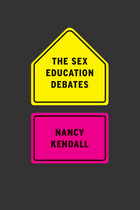 The Sex Education Debates
Nancy Kendall
University of Chicago Press, 2012 Educating children and adolescents in public schools about sex is a deeply inflammatory act in the United States. Since the 1980s, intense political and cultural battles have been waged between believers in abstinence until marriage and advocates for comprehensive sex education. In The Sex Education Debates, Nancy Kendall upends conventional thinking about these battles by bringing the school and community realities of sex education to life through the diverse voices of students, teachers, administrators, and activists. Drawing on ethnographic research in five states, Kendall reveals important differences and surprising commonalities shared by purported antagonists in the sex education wars, and she illuminates the unintended consequences these protracted battles have, especially on teachers and students. Showing that the lessons that most students, teachers, and parents take away from these battles are antithetical to the long-term health of American democracy, she argues for shifting the measure of sex education success away from pregnancy and sexually transmitted infection rates. Instead, she argues, the debates should focus on a broader set of social and democratic consequences, such as what students learn about themselves as sexual beings and civic actors, and how sex education programming affects school-community relations.
Sex Exposed: Sexuality and the Pornography Debate
McIntosh, Mary
Rutgers University Press, 1993 Over the past twenty years debates about pornography have raged within feminism and beyond. Throughout the 1970s feminists increasingly addressed the problem of men's sexual violence against women, and many women reduced the politics of men's power to questions about sexuality. By the 1980s these questions had become more and more focused on the issue of pornography--now a metaphor for the menace of male power. Collapsing feminist politics into sexuality and sexuality into pornography has not only caused some of the deepest splits between feminists, but made it harder to think clearly about either sexuality or pornography--indeed, about feminist politics more generally. This provocative collection, by well-known feminists, surveys these arguments, and in particular asks why recent feminist debates about sexuality keep reducing to questions of pornography.
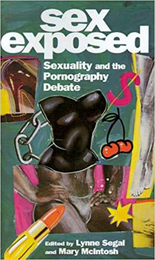 Sex Exposed: Sexuality and the Pornography Debate
McIntosh, Mary
Rutgers University Press, 1993 Over the past twenty years debates about pornography have raged within feminism and beyond. Throughout the 1970s feminists increasingly addressed the problem of men's sexual violence against women, and many women reduced the politics of men's power over women to questions about sexuality. By the 1980s these questions had become more and more focused on the issue of pornography––now a metaphor for the menace of male power. Collapsing feminist politics into sexuality and sexuality into pornography has not only caused some of the deepest splits between feminists, but made it harder to think clearly about either sexuality or pornography––indeed, about feminist politics more generally. This provocative collection, by well-known feminists on both sides of the Atlantic, surveys these arguments, and in particular asks why recent feminist debates about sexuality keep reducing to questions of pornography. The authors open up the debate by looking at such topics as the improbable alliance between the right and pro-censorship feminists, the displacement of heterosexual desire and its discontents onto pornography, Andrea Dworkin's novel Mercy, psychoanalytic reflections on fantasy, censorship in relation to AIDS work, the new lesbian and bisexual pornography, the controversy over Robert Mapplethorpe's supposed racism in his photos of black nudes, Mae West as sexual icon and her brushes with the law, and the female nude in "high" art. In addition to the editors, the contributors are Elizabeth Cowie, Harriett Gilbert, Robin Gorna, Marybeth Hamilton, Loretta Loach, Anne McClintock, Kobena Mercer, Jane Mills, Mandy Merck, Lynda Nead, Gillian Rodgerson, Carol Smart, Carole S. Vance, Linda Williams, and Elizabeth Wilson.
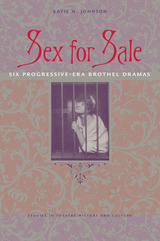 Sex for Sale: Six Progressive-Era Brothel Dramas
Katie N. Johnson
University of Iowa Press, 2015 In early twentieth-century U.S. culture, sex sold. While known mainly for its social reforms, the Progressive Era was also obsessed with prostitution, sexuality, and the staging of women’s changing roles in the modern era. By the 1910s, plays about prostitution (or “brothel dramas”) had inundated Broadway, where they sometimes became long-running hits and other times sparked fiery obscenity debates. In Sex for Sale, Katie N. Johnson recovers six of these plays, presenting them with astute cultural analysis, photographs, and production histories. The result is a new history of U.S. theatre that reveals the brothel drama’s crucial role in shaping attitudes toward sexuality, birth control, immigration, urbanization, and women’s work.
The volume includes the work of major figures including Eugene O’Neill, John Reed, Rachel Crothers, and Elizabeth Robins. Now largely forgotten and some previously unpublished, these plays were among the most celebrated and debated productions of their day. Together, their portrayals of commercialized vice, drug addiction, poverty, white slavery, and interracial desire reveal the Progressive Era’s fascination with the underworld and the theatre’s power to regulate sexuality. Additional plays, commentary, and teaching materials are available at brotheldrama.lib.miamioh.edu.
Plays included:
Ourselves (1913) by Rachel Crothers
The Web (1913) by Eugene O’Neill
My Little Sister (1913) by Elizabeth Robins
Moondown (1915) by John Reed
Cocaine (1916) by Pendleton King
A Shanghai Cinderella (renamed East is West, 1918) by Samuel Shipman and John B. Hymer
Sex, France, and Arab Men, 1962–1979
Todd Shepard
University of Chicago Press, 2017 The aftermath of Algeria’s revolutionary war for independence coincided with the sexual revolution in France, and in this book Todd Shepard argues that these two movements are inextricably linked.
Sex, France, and Arab Men is a history of how and why—from the upheavals of French Algeria in 1962 through the 1970s—highly sexualized claims about Arabs were omnipresent in important public French discussions, both those that dealt with sex and those that spoke of Arabs. Shepard explores how the so-called sexual revolution took shape in a France profoundly influenced by the ongoing effects of the Algerian revolution. Shepard’s analysis of both events alongside one another provides a frame that renders visible the ways that the fight for sexual liberation, usually explained as an American and European invention, developed out of the worldwide anticolonial movement of the mid-twentieth century.
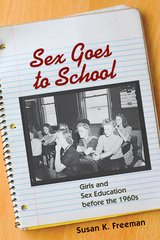 Sex Goes to School: Girls and Sex Education before the 1960s
Susan K. Freeman
University of Illinois Press, 2007 When seeking approaches for sex education, few look to the past for guidance. But Susan K. Freeman's investigation of the classrooms of the 1940s and 1950s offers numerous insights into the potential for sex education to address adolescent challenges, particularly for girls. From rural Toms River, New Jersey, to urban San Diego and many places in between, the use of discussion-based classes fostered an environment that focused less on strictly biological matters of human reproduction and more on the social dimensions of the gendered and sexual worlds that the students inhabited. Although the classes reinforced normative heterosexual gender roles that could prove repressive, the discussion-based approach also emphasized a potentially liberating sense of personal choice and responsibility in young women's relationship decisions. In addition to the biological and psychological underpinnings of normative sexuality, teachers presented girls' sex lives and gendered behavior as critical to the success of American families and, by extension, the entire way of life of American democracy. The approaches of teachers and students were sometimes predictable and other times surprising, yet almost wholly without controversy in the two decades before the so-called Sexual Revolution of the 1960s. Sex Goes to School illuminates the tensions between and among adults and youth attempting to make sense of sex in a society that was then, as much as today, both sex-phobic and sex-saturated.
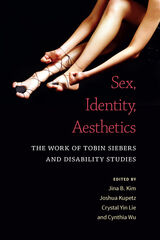 Sex, Identity, Aesthetics: The Work of Tobin Siebers and Disability Studies
Jina B. Kim, Joshua Kupetz, Crystal Yin Lie, and Cynthia Wu, Editors
University of Michigan Press, 2021 The late Tobin Siebers was a pioneer of, and one of the most prominent thinkers in, the field of disability studies. His scholarship on sexual and intimate affiliations, the connections between structural location and coalitional politics, and the creative arts has shaped disability studies and continues to be widely cited. Sex, Identity, Aesthetics: The Work of Tobin Siebers and Disability Studies uses Siebers’ work as a launchpad for thinking about contemporary disability studies. The editors provide an overview of Siebers’ research to show how it has contributed to humanistic understandings of ability and disability along three key axes: sex, identity, and aesthetics. The first section of the book explores how disability provides a way for scholars to theorize a wider range of intimacies and relationalities, arguing that disabled people seek sexual access and revolution in ways that transgress heteronormative dictates on sexual propriety. The second part of the book works outward from Siebers’ work to looks at how disability broadens our concepts of social location and political affiliations. The final section examines how disability challenges traditional notions of artistic beauty and agency. Rather than being a strictly commemorative collection meant to mark the end of a major scholar’s career, this collection shows how Siebers’ foundational work in disability studies remains central to and continues to inspire scholars in the field today.
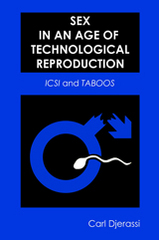 Sex in an Age of Technological Reproduction: ICSI and Taboos
Carl Djerassi
University of Wisconsin Press, 2008 Carl Djerassi is one of “the fathers of the Pill”—he was awarded the National Medal of Science for the first synthesis of a steroid oral contraceptive—and has had a prolific additional career as a writer of fiction, plays, and dialogues about science. In these two plays, ICSI and Taboos, he dramatizes the social transformations and contested viewpoints created by advances in reproductive science and technology. Two of the most startling developments in contemporary science have radically disrupted the historical connection between sex and reproduction: in vitro fertilization and intracytoplasmic sperm injection (ICSI)—an assisted reproductive technique that directly injects a single sperm into an egg. The word play ICSI—designed for classroom readings—presents, in the format of a contentious talk-show dialogue, the science of direct-injection fertilization and the ethical issues connected with it. A DVD included in the book provides video of the ICSI injection process as viewed through a microscope, to be used in performances of the ICSI one-act dialogue. Taboos, a full-length play,turns the screws on characters that reflect a polarized America. Two couples—lesbian partners and a conservative husband and wife struggling with infertility—must make choices in a drama that examines the disjunction of sexual reproduction and the physical act of sex.
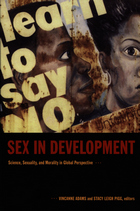 Sex in Development: Science, Sexuality, and Morality in Global Perspective
Vincanne Adams and Stacy Leigh Pigg, eds.
Duke University Press, 2005 Sex in Development examines how development projects around the world intended to promote population management, disease prevention, and maternal and child health intentionally and unintentionally shape ideas about what constitutes “normal” sexual practices and identities. From sex education in Uganda to aids prevention in India to family planning in Greece, various sites of development work related to sex, sexuality, and reproduction are examined in the rich, ethnographically grounded essays in this volume. These essays demonstrate that ideas related to morality are repeatedly enacted in ostensibly value-neutral efforts to put into practice a “global” agenda reflecting the latest medical science. Sex in Development combines the cultural analysis of sexuality, critiques of global development, and science and technology studies. Whether considering the resistance encountered by representatives of an American pharmaceutical company attempting to teach Russian doctors a “value free” way to offer patients birth control or the tension between Tibetan Buddhist ideas of fertility and the modernization schemes of the Chinese government, these essays show that attempts to make sex a universal moral object to be managed and controlled leave a host of moral ambiguities in their wake as they are engaged, resisted, and reinvented in different ways throughout the world. Contributors. Vincanne Adams, Leslie Butt, Lawrence Cohen, Heather Dell, Vinh-Kim Nguyen, Shanti Parikh, Heather Paxson, Stacy Leigh Pigg, Michele Rivkin-Fish
Sex in Middlesex: Popular Mores in a Massachusetts County, 1649-1699
Roger Thompson
University of Massachusetts Press, 1986 "Thompson analyzes the court records of 17th century Middlesex County, searching for such sexually related crimes as fornication, breach of promise, sexual deviancy, and adultery. His findings help shatter the traditional historical caricature of New England Puritans as patriarchal, dour wife-beaters and child-abusers, a myth eloquently created by Perry Miller and most recently reinforced by Lawrence Stone. In the court records Thompson discovers Puritans who exhibited 'tolerance, mutual regard, affection, and prudent common sense' within the context of a popular Puritan piety. A well-written social history that places Puritanism in a human rather than an intellectual framework, Sex in Middlesex is recommended for all students of American history and the American family."—Library Journal
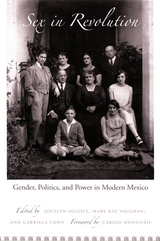 Sex in Revolution: Gender, Politics, and Power in Modern Mexico
Jocelyn Olcott, Mary Kay Vaughan, and Gabriela Cano, eds.
Duke University Press, 2006 Sex in Revolution challenges the prevailing narratives of the Mexican Revolution and postrevolutionary state formation by placing women at center stage. Bringing to bear decades of feminist scholarship and cultural approaches to Mexican history, the essays in this book demonstrate how women seized opportunities created by modernization efforts and revolutionary upheaval to challenge conventions of sexuality, work, family life, religious practices, and civil rights. Concentrating on episodes and phenomena that occurred between 1915 and 1950, the contributors deftly render experiences ranging from those of a transgendered Zapatista soldier to upright damas católicas and Mexico City’s chicas modernas pilloried by the press and male students. Women refashioned their lives by seeking relief from bad marriages through divorce courts and preparing for new employment opportunities through vocational education. Activists ranging from Catholics to Communists mobilized for political and social rights. Although forced to compromise in the face of fierce opposition, these women made an indelible imprint on postrevolutionary society. These essays illuminate emerging practices of femininity and masculinity, stressing the formation of subjectivity through civil-society mobilizations, spectatorship and entertainment, and locales such as workplaces, schools, churches, and homes. The volume’s epilogue examines how second-wave feminism catalyzed this revolutionary legacy, sparking widespread, more radically egalitarian rural women’s organizing in the wake of late-twentieth-century democratization campaigns. The conclusion considers the Mexican experience alongside those of other postrevolutionary societies, offering a critical comparative perspective. Contributors. Ann S. Blum, Kristina A. Boylan, Gabriela Cano, María Teresa Fernández Aceves, Heather Fowler-Salamini, Susan Gauss, Temma Kaplan, Carlos Monsiváis, Jocelyn Olcott, Anne Rubenstein, Patience Schell, Stephanie Smith, Lynn Stephen, Julia Tuñón, Mary Kay Vaughan
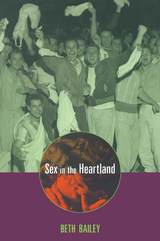 Sex in the Heartland
Beth Bailey
Harvard University Press, 2002 Sex in the Heartland is the story of the sexual revolution in a small university town in the quintessential heartland state of Kansas. Bypassing the oft-told tales of radicals and revolutionaries on either coast, Beth Bailey argues that the revolution was forged in towns and cities alike, as "ordinary" people struggled over the boundaries of public and private sexual behavior in postwar America.
Bailey fundamentally challenges contemporary perceptions of the revolution as simply a triumph of free love and gay lib. Rather, she explores the long-term and mainstream changes in American society, beginning in the economic and social dislocations of World War II and the explosion of mass media and communication, which aided and abetted the sexual upheaval of the 1960s. Focusing on Lawrence, Kansas, we discover the intricacies and depth of a transformation that was nurtured at the grass roots.
Americans used the concept of revolution to make sense of social and sexual changes as they lived through them. Everything from the birth control pill and counterculture to Civil Rights, was conflated into "the revolution," an accessible but deceptive simplification, too easy to both glorify and vilify. Bailey untangles the radically different origins, intentions, and outcomes of these events to help us understand their roles and meanings for sex in contemporary America. She argues that the sexual revolution challenged and partially overturned a system of sexual controls based on oppression, inequality, and exploitation, and created new models of sex and gender relations that have shaped our society in powerful and positive ways.
Sex in the Middle East and North Africa
L. L. Wynn
Vanderbilt University Press, 2022 Sex in the Middle East and North Africa examines the sexual practices, politics, and complexities of the modern Arab world. Short chapters feature a variety of experts in anthropology, sociology, health science, and cultural studies. Many of the chapters are based on original ethnographic and interview work with subjects involved in these practices and include their voices.
The book is organized into three sections: Single and Dating, Engaged and Married, and It's Complicated. The allusion to categories of relationship status on social media is at once a nod to the compulsion to categorize, recognition of the many ways that categorization is rarely straightforward, and acknowledgment that much of the intimate lives described by the contributors is mediated by online technologies.
 Sex Isn't Real: The Invention of an Incoherent Binary
Beans Velocci
Duke University Press, 2026 In Sex Isn’t Real, Beans Velocci traces the history of current high stakes attempts to define sex and to create a world devoid of trans life. Drawing on lab notes, family genealogies, medical case studies, and more, Velocci follows scientists and clinicians from the mid-nineteenth through the mid-twentieth century and across five disciplines—zoology, eugenics, gynecology, statistical sexology, and transsexual medicine—as their ideas and practices created a definitional tangle. They demonstrate how the sorting of bodies into male and female persists not despite but because of sex’s incoherence: the defining features of these categories shift to contain various understandings of anatomy and physiology, theories of race, developments in research and medical methodologies, and bodies that cannot be accounted for in a binary framework. Exposing the endless work required to produce a world in which most people have a binary gender identity that neatly fits their binarily sexed body, Velocci demonstrates that it is not cis people who fit the categories; it’s the categories that flex to make them fit.
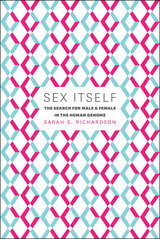 Sex Itself: The Search for Male and Female in the Human Genome
Sarah S. Richardson
University of Chicago Press, 2013 Human genomes are 99.9 percent identical—with one prominent exception. Instead of a matching pair of X chromosomes, men carry a single X, coupled with a tiny chromosome called the Y. Tracking the emergence of a new and distinctive way of thinking about sex represented by the unalterable, simple, and visually compelling binary of the X and Y chromosomes, Sex Itself examines the interaction between cultural gender norms and genetic theories of sex from the beginning of the twentieth century to the present, postgenomic age. Using methods from history, philosophy, and gender studies of science, Sarah S. Richardson uncovers how gender has helped to shape the research practices, questions asked, theories and models, and descriptive language used in sex chromosome research. From the earliest theories of chromosomal sex determination, to the mid-century hypothesis of the aggressive XYY supermale, to the debate about Y chromosome degeneration, to the recent claim that male and female genomes are more different than those of humans and chimpanzees, Richardson shows how cultural gender conceptions influence the genetic science of sex. Richardson shows how sexual science of the past continues to resonate, in ways both subtle and explicit, in contemporary research on the genetics of sex and gender. With the completion of the Human Genome Project, genes and chromosomes are moving to the center of the biology of sex. Sex Itself offers a compelling argument for the importance of ongoing critical dialogue on how cultural conceptions of gender operate within the science of sex.
 Sex, Love, and Health in America: Private Choices and Public Policies
Edited by Edward O. Laumann and Robert T. Michael
University of Chicago Press, 2000 In 1994, the University of Chicago Press published the landmark study The Social Organization of Sexuality, "the most important survey since the Kinsey report," according to Time magazine. Based on data collected from the National Health and Social Life Survey, this heralded book answered hundreds of questions about the state of sex in America: how widespread is extramarital sex? how do women's sexual lives differ from men's? how do social factors such as education, race, and religion affect sexual conduct? While amazingly comprehensive, this earlier volume was devoted primarily to establishing baseline statistics and information. Two authors of that study, Edward O. Laumann and Robert T. Michael, now bring together the result of deeper research into and analysis of the information presented in the 1994 volume. The result, Sex, Love, and Health in America, is a companion to The Social Organization of Sexuality and furthers our understanding of Americans' sexual practices.
Sixteen researchers have contributed essays to this collection that explore controversial topics, including teenage sexuality, sexual contact between children and adults, abortion, the role of cohabitation in the sexual satisfaction of couples, and how sexual behavior has changed in response to AIDS, as well as a widely heralded examination of circumcision, reported in the New York Times, which discusses the effects of the procedure on disease transmission and the preference for certain sexual practices. In its analysis, policy recommendations, and revelations about private practices, Sex, Love, and Health in America will, like the earlier volume, have a major role in shaping the discussion about American sexual behavior.
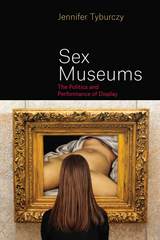 Sex Museums: The Politics and Performance of Display
Jennifer Tyburczy
University of Chicago Press, 2015 Winner of the 29th annual Lambda Literary Award for LGBT Studies
All museums are sex museums. In Sex Museums, Jennifer Tyburczy takes a hard look at the formation of Western sexuality—particularly how categories of sexual normalcy and perversity are formed—and asks what role museums have played in using display as a technique for disciplining sexuality. Most museum exhibits, she argues, assume that white, patriarchal heterosexuality and traditional structures of intimacy, gender, and race represent national sexual culture for their visitors. Sex Museums illuminates the history of such heteronormativity at most museums and proposes alternative approaches for the future of public display projects, while also offering the reader curatorial tactics—what she calls queer curatorship—for exhibiting diverse sexualities in the twenty-first century.
Tyburczy shows museums to be sites of culture-war theatrics, where dramatic civic struggles over how sex relates to public space, genealogies of taste and beauty, and performances of sexual identity are staged. Delving into the history of erotic artifacts, she analyzes how museums have historically approached the collection and display of the material culture of sex, which poses complex moral, political, and logistical dilemmas for the Western museum. Sex Museums unpacks the history of the museum and its intersections with the history of sexuality to argue that the Western museum context—from its inception to the present—marks a pivotal site in the construction of modern sexual subjectivity.
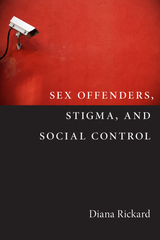 Sex Offenders, Stigma, and Social Control
Rickard, Diana
Rutgers University Press, 2016 The 1990s witnessed a flurry of legislative initiatives—most notably, “Megan’s Law”—designed to control a population of sex offenders (child abusers) widely reviled as sick, evil, and incurable. In Sex Offenders, Stigma, and Social Control, Diana Rickard provides the reader with an in-depth view of six such men, exploring how they manage to cope with their highly stigmatized role as social outcasts. The six men discussed in the book are typical convicted sex offenders—neither serial pedophiles nor individuals convicted of the type of brutal act that looms large in public perceptions about sex crimes. Sex Offenders, Stigma, and Social Control explores how these individuals, who have been cast as social pariahs, construct their sense of self. How does being labeled in this way and controlled by measures such as Megan’s Law affect one’s identity and sense of social being? Unlike traditional criminological and psychological studies of this population, this book frames their experiences in concepts of both deviance and identity, asking how men so highly stigmatized cope with the most extreme form of social marginality. Placing their stories within the context of the current culture of mass incarceration and zero-tolerance, Rickard provides a deeper understanding of the complex relationship between public policy and lived experience, as well as an understanding of the social challenges faced by this population, whose re-integration into society is far from simple or assured. Sex Offenders, Stigma, and Social Control makes a significant contribution to our understanding of sex offenders, offering a unique window into how individuals make meaning out of their experiences and present a viable—not monstrous—social self to themselves and others.
Sex on Stage: Gender and Sexuality in Post-War British Theatre
Andrew Wyllie
Intellect Books, 2009 In the years just after World War II, theater provided an important critique of British society’s engagement with gender and sexual politics. Sex on Stage examines how British playwrights, actors, and directors brought women’s sexuality and gay and lesbian issues to the cutting edge of drama after World War II. Through a close reading of playwrights such as John Osborne, Harold Pinter, and Terence Rattigan, alongside accounts of their sociopolitical context and public reception, Andrew Wyllie reveals that this more progressive age was also one of reactionary statements and industry-wide anxiety.
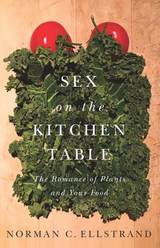 Sex on the Kitchen Table: The Romance of Plants and Your Food
Norman C. Ellstrand
University of Chicago Press, 2018 At the tips of our forks and on our dinner plates, a buffet of botanical dalliance awaits us. Sex and food are intimately intertwined, and this relationship is nowhere more evident than among the plants that sustain us. From lascivious legumes to horny hot peppers, most of humanity’s calories and other nutrition come from seeds and fruits—the products of sex—or from flowers, the organs that make plant sex possible. Sex has also played an arm’s-length role in delivering plant food to our stomachs, as human handmade evolution (plant breeding, or artificial selection) has turned wild species into domesticated staples.
In Sex on the Kitchen Table, Norman C. Ellstrand takes us on a vegetable-laced tour of this entire sexual adventure. Starting with the love apple (otherwise known as the tomato) as a platform for understanding the kaleidoscopic ways that plants can engage in sex, successive chapters explore the sex lives of a range of food crops, including bananas, avocados, and beets, finally ending with genetically engineered squash—a controversial, virus-resistant vegetable created by a process that involves the most ancient form of sex. Peppered throughout are original illustrations and delicious recipes, from sweet and savory tomato pudding to banana puffed pancakes, avocado toast (of course), and both transgenic and non-GMO tacos.
An eye-opening medley of serious science, culinary delights, and humor, Sex on the Kitchen Table offers new insight into fornicating flowers, salacious squash, and what we owe to them. So as we sit down to dine and ready for that first bite, let us say a special grace for our vegetal vittles: let’s thank sex for getting them to our kitchen table.
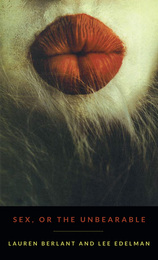 Sex, or the Unbearable
Lauren Berlant and Lee Edelman
Duke University Press, 2014 Sex, or the Unbearable is a dialogue between Lauren Berlant and Lee Edelman, two of our leading theorists of sexuality, politics, and culture. In juxtaposing sex and the unbearable they don't propose that sex is unbearable, only that it unleashes unbearable contradictions that we nonetheless struggle to bear. In Berlant and Edelman's exchange, those terms invoke disturbances produced in encounters with others, ourselves, and the world, disturbances that tap into threats induced by fears of loss or rupture as well as by our hopes for repair. Through virtuoso interpretations of works of cinema, photography, critical theory, and literature, including Lydia Davis's story "Break It Down" (reprinted in full here), Berlant and Edelman explore what it means to live with negativity, with those divisions that may be irreparable. Together, they consider how such negativity affects politics, theory, and intimately felt encounters. But where their critical approaches differ, neither hesitates to voice disagreement. Their very discussion—punctuated with moments of frustration, misconstruction, anxiety, aggression, recognition, exhilaration, and inspiration—enacts both the difficulty and the potential of encounter, the subject of this unusual exchange between two eminent critics and close friends.
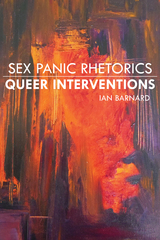 Sex Panic Rhetorics, Queer Interventions
Ian Barnard
University of Alabama Press, 2020 Winner of the 2021 Conference on College Composition and Communication Lavender Rhetorics Award for Excellence in Queer Scholarship
Analyzes the rhetoric of contemporary sex panics to expose how homophobia, heterosexism, and transphobia define public, political, and scholarly preoccupations with sexuality and gender
In Sex Panic Rhetorics, Queer Interventions, Ian Barnard makes the counter-intuitive argument that contemporary “sex panics” are undergirded by queerphobia, even when the panics in question don’t appear to have much to do with queerness. Barnard presents six case studies that treat a wide range of sex panic rhetorics around child molesters, sex trafficking, transgenderism, incest, queer kids, and pedagogy to demonstrate this argument. By using examples from academic scholarship, political discourse, and popular culture, including the Kevin Spacey scandal and the award-winning film Moonlight, Barnard shows how homophobia and transphobia continue to pervade contemporary Western culture.
Barnard is concerned not so much with looking at the overt homophobia and transphobia that are the more obvious objects of antihomophobic and antitransphobic critique. The author’s focus, rather, is on excavating the significant traces of these panics in a neoliberal culture that has supposedly demonstrated its civility by its embrace of diversity, renunciation of its homophobic past, and attentiveness to the transgender revolution that has swept popular media and political culture in the United States and elsewhere. During a time of increasing conservative backlashes against advancing LGBTQ rights and human rights discourses in general, this book shows why it is important to attend to the liberal covers for sex panics that are not too far removed from their rhetorically conservative cousins.
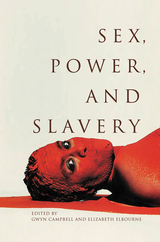 Sex, Power, and Slavery
Gwyn Campbell
Ohio University Press, 2014 Sexual exploitation was and is a critical feature of enslavement. Across many different societies, slaves were considered to own neither their bodies nor their children, even if many struggled to resist. At the same time, paradoxes abound: for example, in some societies to bear the children of a master was a potential route to manumission for some women. Sex, Power, and Slavery is the first history of slavery and bondage to take sexuality seriously. Twenty-six authors from diverse scholarly backgrounds look at the vexed, traumatic intersections of the histories of slavery and of sexuality. They argue that such intersections mattered profoundly and, indeed, that slavery cannot be understood without adequate attention to sexuality. Sex, Power, and Slavery brings into conversation historians of the slave trade, art historians, and scholars of childhood and contemporary sex trafficking. The book merges work on the Atlantic world and the Indian Ocean world and enables rich comparisons and parallels between these diverse areas. Contributors: David Brion Davis, Martin Klein, Richard Hellie, Abdul Sheriff, Griet Vankeerberghen, E. Ann McDougall, Matthew S. Hopper, Marie Rodet, George La Rue, Ulrike Schmieder, Tara Iniss, Mariana Candido, James Francis Warren, Johanna Ransmeier, Roseline Uyanga with Marie-Luise Ermisch, Francesca Ann Louise Mitchell, Shigeru Sato, Gabeba Baderoon, Charmaine Nelson, Ana Lucia Araujo, Brian Lewis, Ronaldo Vainfas, Salah Trabelsi, Joost Coté, Sandra Evers, and Subho Basu
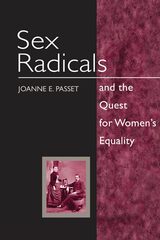 Sex Radicals and the Quest for Women's Equality
Joanne E. Passet
University of Illinois Press, 2003 Questioning the commonplace view of the late nineteenth century as a period of passionless women and so-called Victorian sexuality, this study examines the spread of sex radical thought and notions of free love through American society in the second half of the nineteenth century. During this period a grass-roots movement of women and men, uncomfortable with the social, economic, and political inequalities they saw as inherent to the institution of marriage, participated in frank discussions about the relationship between sexuality and women’s rights.
In charting the growth of the sex radical movement, Joanne E. Passet draws on a host of documents from the period -- letters, periodicals, lectures, and pamphlets -- to establish a strong link between the rise of print culture and the freedom of citizens, especially women, to build geographically dispersed communities of ideas. She also advances models of sexuality that challenge the restrictive mores of society at large and shows that the majority of correspondents who participated in the sex radical movement resided in the Midwest and the Great Plains states, where ideas of individual freedom and sovereignty resonated particularly strongly.
Passet vividly demonstrates how this sex radical movement laid the foundations upon which later generations of women’s rights crusaders and feminists would build, placing discussions of sex and sexuality squarely in the public arena.
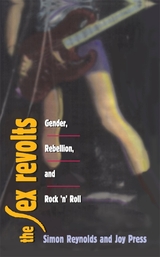 The Sex Revolts: Gender, Rebellion, and Rock ‘n’ Roll
Simon Reynolds and Joy Press
Harvard University Press Iggy Pop once said of women: “However close they come I’ll always pull the rug from under them. That’s where my music is made.” For so long, rock ’n’ roll has been fueled by this fear and loathing of the feminine. The first book to look at rock rebellion through the lens of gender, The Sex Revolts captures the paradox at rock’s dark heart—the music is often most thrilling when it is most misogynist and macho. And, looking at music made by female artists, it asks: must it always be this way?
Provocative and passionately argued, the book walks the edgy line between a rock fan’s excitement and a critic’s awareness of the music’s murky undercurrents. Here are the angry young men like the Stones and Sex Pistols, cutting free from home and mother; here are the warriors and crusaders, The Clash, Public Enemy, and U2 taking refuge in a brotherhood-in-arms; and here are the would-be supermen, with their man-machine fantasies and delusions of grandeur, from Led Zeppelin and Jim Morrison to Nick Cave and gangsta rap. The authors unravel the mystical, back-to-the-womb longings of the psychedelic tradition, from Pink Floyd, Jimi Hendrix, and Van Morrison to Brian Eno, My Bloody Valentine, and ambient techno. Alongside the story of male rock, The Sex Revolts traces the secret history of female rebellion in rock: the masquerade and mystique of Kate Bush, Siouxie, and Grace Jones, the demystifiers of femininity, like the Slits and Riot Grrl, tomboy rockers like L7 and P.J. Harvey, and confessional artists like Janis Joplin, Joni Mitchell, and Courtney Love.
A heady blend of music criticism, cultural studies, and gender theory by two of rock’s keenest observers, The Sex Revolts is set to become the key text in the women-in-rock debate.
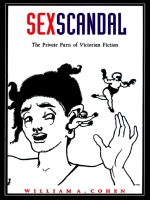 Sex Scandal: The Private Parts of Victorian Fiction
William A. Cohen
Duke University Press, 1996 Never has the Victorian novel appeared so perverse as it does in these pages—and never his its perversity seemed so fundamental to its accomplishment. Whether discussing George Eliot’s lesbian readers, Anthony Trollope’s whorish heroines, or Charles Dickens’s masturbating characters, William A. Cohen’s study explodes the decorum of mainstream nineteenth-century fiction. By viewing this fiction alongside the most alarming public scandals of the day, Cohen exposes both the scandalousness of this literature and its sexiness.
Scandal, then as now, makes public the secret indiscretions of prominent people, engrossing its audience in salacious details that violate the very code of propriety it aims to enforce. In narratives ranging from Great Expectations to the Boulton and Park sodomy scandal of 1870–71, from Eliot’s and Trollope’s novels about scandalous women to Oscar Wilde’s writing and his trials for homosexuality, Cohen shows how, in each instance, sexuality appears couched in coded terms. He identifies an assortment of cunning narrative techniques used to insinuate sex into Victorian writing, demonstrating that even as such narratives air the scandalous subject, they emphasize its unspeakable nature.
Written with an eye toward the sex scandals that still whet the appetites of consumers of news and novels, this work is suggestive about our own modes of imagining sexuality today and how we arrived at them. Sex Scandal will appeal to scholars and general readers interested in Victorian literature, the history of sexuality, gender studies, nineteenth-century Britain, and gay, lesbian, and queer studies.
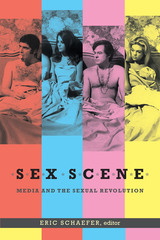 Sex Scene: Media and the Sexual Revolution
Eric Schaefer, ed.
Duke University Press, 2014 Sex Scene suggests that what we have come to understand as the sexual revolution of the late 1960s and early 1970s was actually a media revolution. In lively essays, the contributors examine a range of mass media—film and television, recorded sound, and publishing—that provide evidence of the circulation of sex in the public sphere, from the mainstream to the fringe. They discuss art films such as I am Curious (Yellow), mainstream movies including Midnight Cowboy, sexploitation films such as Mantis in Lace, the emergence of erotic film festivals and of gay pornography, the use of multimedia in sex education, and the sexual innuendo of The Love Boat. Scholars of cultural studies, history, and media studies, the contributors bring shared concerns to their diverse topics. They highlight the increasingly fluid divide between public and private, the rise of consumer and therapeutic cultures, and the relationship between identity politics and individual rights. The provocative surveys and case studies in this nuanced cultural history reframe the "sexual revolution" as the mass sexualization of our mediated world.
Contributors. Joseph Lam Duong, Jeffrey Escoffier, Kevin M. Flanagan, Elena Gorfinkel, Raymond J. Haberski Jr., Joan Hawkins, Kevin Heffernan, Eithne Johnson, Arthur Knight, Elana Levine, Christie Milliken, Eric Schaefer, Jeffrey Sconce, Jacob Smith, Leigh Ann Wheeler, Linda Williams
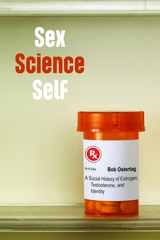 Sex Science Self: A Social History of Estrogen, Testosterone, and Identity
Bob Ostertag
University of Massachusetts Press, 2016 In Sex Science Self, Bob Ostertag cautions against accepting and defending any technology uncritically—even, maybe even especially, a technology that has become integrally related to identity. Specifically, he examines the development of estrogen and testosterone as pharmaceuticals.
Ostertag situates this history alongside the story of an increasingly visible and political lesbian, gay, bisexual, and transgender population. He persuasively argues that scholarship on the development of sex hormone chemicals does not take into account LGBT history and activism, nor has work in LGBT history fully considered the scientific research that has long attempted to declare a chemical essence of gender. In combining these histories, Ostertag reveals the complex motivations behind hormone research over generations and expresses concern about the growing profits from estrogen and testosterone, which now are marketed with savvy ad campaigns to increase their use across multiple demographics.
Ostertag does not argue against the use of pharmaceutical hormones. Instead he points out that at a time when they are increasingly available, it is more important than ever to understand the history and current use of these powerful chemicals so that everyone—within the LGBT community and beyond—can make informed choices.
In this short, thoughtful, and engaging book, Ostertag tells a fascinating story while opening up a wealth of new questions and debates about gender, sexuality, and medical treatments.
 Sex, Sexuality, and the Anthropologist
Edited by Fran Markowitz and Michael Ashkenazi
University of Illinois Press, 1999 Sex in the field—the dilemma of whether to cover up or display sexual identities and desires during the course of anthropological fieldwork—is one of the best-kept secrets in the discipline. Contending that the conventional pose of a genderless, asexual, ethnographic researcher is impossible to sustain, this volume brings sex and sexuality into the open as essential components of ethnographic study that must be overtly recognized and proactively addressed.
Sex, Sexuality, and the Anthropologist recounts the real-life experiences of anthropologists who are forced to acknowledge that their hosts in the field view them as gendered beings in a social context, not as asexual, objective observers. Far from controlling the research environment and defining the terms of interviewer-informant relationships, these researchers find they must engage in a process of negotiating their position—including their sexual position—within the communities they study.
Ranging from public baths in Austria to lesbian bars in Taiwan and from Mexico to Nigeria to Finland to Japan, Sex, Sexuality, and the Anthropologist raises critical questions about ethnographers' reflexivity, subjectivity, and detachment, confronting the challenge of a holistic approach to the anthropological enterprise.
 Sex, Shame, and Violence: A Revolutionary Practice of Public Storytelling in Poor Communities
Kathleen Cash
Vanderbilt University Press, 2016 Choice Outstanding Academic Title of 2017
For more than three decades, Kathleen Cash has lived and worked with impoverished people, learning about their lives. Listening to them talk about their feelings of shame, Cash heard how people suffered from being unable to change what was happening to them--HIV infection, sexual and domestic violence, violence toward children, and environmental degradation. She saw that many interventions lacked emotional and cultural integrity and thus did little to alleviate these hardships. So Cash went outside the conventional approaches to health promotion and social justice and devised a community narrative practice, a strategy for engaging people through storytelling. From numerous ethnographic interviews, she pieced together cultural stories in a way that resonated with community people and revealed the paradoxes in their suffering. Cash recruited local artists to illustrate the stories in a form resembling a graphic novel and distributed these booklets for community discussion. (This book includes excerpts from these illustrated stories.)
In Thailand, Bangladesh, Haiti, Uganda, and the United States, people learned to talk about forbidden subjects and say what they could never say before. They stood up to each other, reconciled, and made health-seeking decisions. By helping others, they repaired themselves. In cathartic conversations they acknowledged shame, which led to acts of courage and generosity.
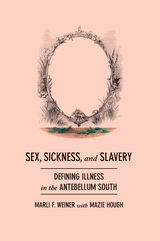 Sex, Sickness, and Slavery: Illness in the Antebellum South
Marli F. Weiner with Mazie Hough
University of Illinois Press, 2014 Marli F. Wiener skillfully integrates the history of medicine with social and intellectual history in this study of how race and sex complicated medical treatment in the antebellum South. Sex, Sickness, and Slavery argues that Southern physicians' scientific training and practice uniquely entitled them to formulate medical justification for the imbalanced racial hierarchies of the period. Challenged with both helping to preserve the slave system (by acknowledging and preserving clear distinctions of race and sex) and enhancing their own authority (with correct medical diagnoses and effective treatment), doctors sought to understand bodies that did not necessarily fit into neat dichotomies or agree with suggested treatments. Focusing on Southern states from Virginia to Alabama, Weiner examines medical and lay perspectives on the body through a range of sources, including medical journals, notes, diaries, daybooks, and letters. These personal and revealing sources show how physicians, medical students, and patients--both free whites and slaves--felt about vulnerability to disease and mental illnesses, how bodily differences between races and sexes were explained, and how emotions, common sense, working conditions, and climate were understood to have an effect on the body. Physicians' authority did not go uncontested, however. Weiner also describes the ways in which laypeople, both black and white, resisted medical authority, clearly refusing to cede explanatory power to doctors without measuring medical views against their own bodily experiences or personal beliefs. Expertly drawing the dynamic tensions during this period in which Southern culture and the demands of slavery often trumped science, Weiner explores how doctors struggled with contradictions as medicine became a key arena for debate over the meanings of male and female, sick and well, black and white, North and South.
 Sex, Skulls, and Citizens: Gender and Racial Science in Argentina (1860-1910)
Ashley Elizabeth Kerr
Vanderbilt University Press PROSE Awards Subject Category Finalist—Biological Anthropology, Ancient History, and Archaeology, 2021
Best Nineteenth-Century Book Award, Latin American Studies Association Nineteenth-Century Section, 2021 Analyzing a wide variety of late-nineteenth-century sources, Sex, Skulls, and Citizens argues that Argentine scientific projects of the era were not just racial encounters, but were also conditioned by sexual relationships in all their messy, physical reality. The writers studied here (an eclectic group of scientists, anthropologists, and novelists, including Estanislao Zeballos, Lucio and Eduarda Mansilla, Ramón Lista, and Florence Dixie) reflect on Indigenous sexual practices, analyze the advisability and effects of interracial sex, and use the language of desire to narrate encounters with Indigenous peoples as they try to scientifically pinpoint Argentina's racial identity and future potential. Kerr's reach extends into history of science, literary studies, and history of anthropology, illuminating a scholarly time and place in which the lines betwixt were much blurrier, if they existed at all.
Sex, Society, and the Making of Pornography: The Pornographic Object of Knowledge
Jeffrey Escoffier
Rutgers University Press, 2021 Hardcore pornographic films combine fantasy and real sex to create a unique genre of entertainment. Pornographic films are also historical documents that give us access to the sexual behavior and eroticism of different historical periods. This book shows how the making of pornographic films is a social process that draws on the fantasies, sexual scripts, and sexual identities of performers, writers, directors, and editors to produce sexually exciting videos and movies. Yet hardcore pornographic films have also created a body of knowledge that constitutes, in this digital age, an enormous archive of sexual fantasies that serve as both a form of sex education and self-help guides. Sex, Society, and the Making of Pornography focuses on sex and what can be learned about it from pornographic representations.
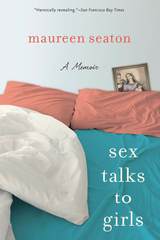 Sex Talks to Girls: A Memoir
Maureen Seaton
University of Wisconsin Press, 2008 Sex Talks to Girls chronicles the outward antics of a woman on an inward journey to self through the routes of religion, sex, sobriety, and kids. Recasting herself in this memoir as “Molly Meek,” Maureen Seaton interprets the emergence of Molly’s identity in luxurious and very funny prose. Molly alternately finds herself in the surprising company of winos, swingers, and drag kings; in love with Jesus H. Christ and a butch named Mars; in charge of two children; writing stories that shrink painfully to poems without her permission; and incapable of figuring out how she landed in any of these predicaments. She is, by turns, a little saint, a Stepford wife, a bi-mom, and a femme with super powers. Her transformation—from near-nun to full-fledged sexual being, accidentally becoming conscious in the process and delighting in the spree—is the story of a life set on play and a woman heroically committed to seeing it through. Winner, Lesbian Memoir/Biography, Lambda Literary Foundation Book Awards
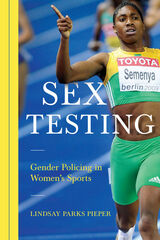 Sex Testing: Gender Policing in Women's Sports
Lindsay Pieper
University of Illinois Press, 2016 In 1968, the International Olympic Committee (IOC) implemented sex testing for female athletes at that year's Games. When it became clear that testing regimes failed to delineate a sex divide, the IOC began to test for gender--a shift that allowed the organization to control the very idea of womanhood. Ranging from Cold War tensions to gender anxiety to controversies around doping, Lindsay Parks Pieper explores sex testing in sport from the 1930s to the early 2000s. Pieper examines how the IOC in particular insisted on a misguided binary notion of gender that privileged Western norms. Testing evolved into a tool to identify--and eliminate--athletes the IOC deemed too strong, too fast, or too successful. Pieper shows how this system punished gifted women while hindering the development of women's athletics for decades. She also reveals how the flawed notions behind testing--ideas often sexist, racist, or ridiculous--degraded the very idea of female athleticism.
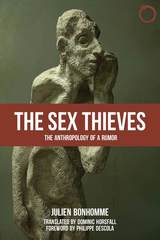 The Sex Thieves: The Anthropology of a Rumor
Julien Bonhomme
HAU, 2016 While working in Africa, anthropologist Julien Bonhomme encountered an astonishing phenomenon: people being accused of stealing or shrinking the genitals of strangers on the simple occasion of a handshake on the street. As he soon discovered, these accusations can have dramatic outcomes: the “sex thieves” are often targeted by large crowds and publicly lynched. Moreover, such rumors are an extremely widespread practice, having affected almost half of the African continent since the 1970s. In this book, Bonhomme examines the story of the “penis snatcher,” asking larger questions about how to account for such a phenomenon—unique in its spatial and temporal scale—without falling prey to the cliché of Africa as an exotic other.
Bonhomme argues that the public belief in sex thieves cannot be considered a superstition or form of mass hysteria. Rather, he brings to light multiple factors that explain the rumor’s success and shows how the cultural dynamic can operate on a vast scale. Analyzing the rumor on both transnational and local levels, he demonstrates how it arises from the ambiguities and dangers of anonymity, and thus that it reveals an occult flipside to everyday social interaction. Altogether, this book provides both richly ethnographic and theoretical understandings of urban sociality and the dynamics of human communication in contemporary Africa and beyond.
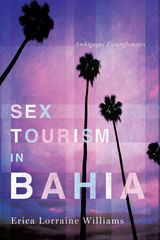 Sex Tourism in Bahia: Ambiguous Entanglements
Erica Lorraine Williams
University of Illinois Press, 2013 For nearly a decade, Brazil has surpassed Thailand as the world's premier sex tourism destination. As the first full-length ethnography of sex tourism in Brazil, this pioneering study treats sex tourism as a complex and multidimensional phenomenon that involves a range of activities and erotic connections, from sex work to romantic transnational relationships. Erica Lorraine Williams explores sex tourism in the Brazilian state of Bahia from the perspectives of foreign tourists, tourism industry workers, sex workers who engage in liaisons with foreigners, and Afro-Brazilian men and women who contend with foreigners' stereotypical assumptions about their licentiousness. She shows how the Bahian state strategically exploits the touristic desire for exotic culture by appropriating an eroticized blackness and commodifying the Afro-Brazilian culture in order to sell Bahia to foreign travelers.
 Sex Trafficking and Human Rights: The Status of Women and State Responses
Heather Smith-Cannoy, Patricia C. Rodda, and Charles Anthony Smith
Georgetown University Press, 2022 Case studies explore how women’s rights shape state responses to sex trafficking and show how politically empowering women can help prevent and combat human trafficking Human trafficking for the sex trade is a form of modern-day slavery that ensnares thousands of victims each year, disproportionately affecting women and girls. While the international community has developed an impressive edifice of human rights law, these laws are not equally recognized or enforced by all countries. Sex Trafficking and Human Rights demonstrates that state responsiveness to human trafficking is shaped by the political, social, cultural, and economic rights afforded to women in that state. While combatting human trafficking is a multiscalar problem with a host of conflating variables, this book shows that a common theme in the effectiveness of state response is the degree to which women and girls are perceived as, and actually are, full citizens. By analyzing human trafficking cases in India, Thailand, Russia, Nigeria, and Brazil, they shed light on the factors that make some women and girls more susceptible to traffickers than others. This important book is both a call to understanding and a call to action: if the international community and state governments are to responsibly and effectively combat human trafficking, they must center the equality of women in national policy.
Sex Trafficking, Scandal, and the Transformation of Journalism, 1885-1917
Gretchen Soderlund
University of Chicago Press, 2013 In Sex Trafficking, Scandal, and the Transformation of Journalism, Gretchen Soderlund offers a new way to understand sensationalism in both newspapers and reform movements. By tracing the history of high-profile print exposés on sex trafficking by journalists like William T. Stead and George Kibbe Turner, Soderlund demonstrates how controversies over gender, race, and sexuality were central to the shift from sensationalism to objectivity—and crucial to the development of journalism in the early twentieth century.
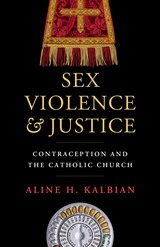 Sex, Violence, and Justice: Contraception and the Catholic Church
Aline H. Kalbian
Georgetown University Press, 2016 In 1968, Pope Paul VI published Humanae vitae, the encyclical that reaffirmed the Catholic Church’s continued opposition to the use of any form of artificial contraception. In Sex, Violence, and Justice: Contraception and the Catholic Church, Aline Kalbian outlines the Church’s position against artificial contraception as principally rooted in three biblical commandments. In addition, Kalbian shows how discourses about sexuality, both in the Church and in culture, are often tied to discourses of violence, harm and social injustice. These ties reveal that sexual ethics is never just about sex; it is about the vulnerability of the human body and the challenges humans face in trying to maintain just and loving relationships. As Kalbian explores and contrasts the Catholic Church’s stance toward condoms and HIV/AIDS, emergency contraception in cases of rape, and contraception and population control, she underscores how contraception is not just a private decision, but a deeply social, cultural, and political one, with profound global implications. Kalbian concludes that even the most tradition-bound communities rely on justificatory schemes that are fluid and diverse. Taking this diversity seriously helps us to understand how religious traditions change and develop. Sex, Violence, and Justice will be of interest to students and scholars of Catholic moral theology, sexual ethics, religion and society, gender and religion, as well as to specialists and practitioners in public health.
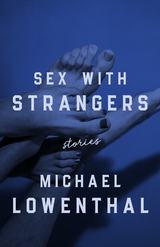 Sex with Strangers
Michael Lowenthal
University of Wisconsin Press, 2021 A fiercely honest exploration of the risks and rewards of contemporary relationships—and hookups—Sex with Strangers embraces the dizzying power of attraction across the spectrum of passion and infatuation. In this fearless collection, lust and loneliness drive a diverse cast of queer and straight characters into sometimes precarious entanglements.
Recognizing that any partner is unknowable on some level, Michael Lowenthal writes about how intimacy can make strangers of us all. A newly ordained priest struggles with guilt and longing when he runs into his ex-girlfriend. A woman weighs the cost of protecting her daughter from a man they both adore. A teenage busboy has a jolting brush with a famous musician. A young man tries to salvage a long-distance relationship while caring for his mentor, an erotic writer dying of AIDS.
In edgy, disquieting stories, Lowenthal traces the paths that attraction and erotic encounters take, baffling and rueful as often as electrifying. This fraught and funny volume forces us to grapple with our own subconscious desires and question how well we can ever really know ourselves.
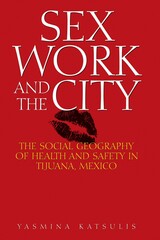 Sex Work and the City: The Social Geography of Health and Safety in Tijuana, Mexico
By Yasmina Katsulis
University of Texas Press, 2009 A gateway at the U.S.-Mexico border, Tijuana is a complex urban center with a sizeable population of sex workers. An in-depth case study of the trade, Sex Work and the City is the first major ethnographic publication on contemporary prostitution in this locale, providing a detailed analysis of how sex workers' experiences and practices are shaped by policing and regulation. Contextualizing her research within the realm of occupational risk, Yasmina Katsulis examines the experiences of a diverse range of sex workers in the region and explores the implications of prostitution, particularly regarding the spheres of class hierarchies, public health, and other broad social effects. Based on eighteen months of intensive fieldwork and nearly 400 interviews with sex workers, customers, city officials, police, local health providers, and advocates, Sex Work and the City describes the arenas of power and the potential for disenfranchisement created by municipal laws designed to regulate the trade. Providing a detailed analysis of this subculture's significance within Tijuana and its implications for debates over legalization of "vice" elsewhere in the world, Katsulis draws on powerful narratives as workers describe the risks of their world, ranging from HIV/AIDS and rape (by police or customers) to depression, work-related stress, drug and alcohol addiction, and social stigma. Insightful and compelling, Sex Work and the City captures the lives (and deaths) of a population whose industry has broad implications for contemporary society at large.
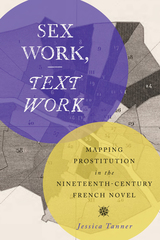 Sex Work, Text Work: Mapping Prostitution in the Nineteenth-Century French Novel
Jessica Tanner
Northwestern University Press, 2023 Though male French authors plotted prostitution to make their names—mimicking the surveillance of municipal authorities—the sex workers in their books manage to evade efforts to contain them
While prostitutes in nineteenth-century Paris were subject to municipal laws that policed their bodies and movements, writers of the era enlisted them to stake their own claims on both the city and the novel as literary territory. Sex Work, Text Work: Mapping Prostitution in the Nineteenth-Century French Novel explores how prostitutes depicted by Émile Zola, Joris-Karl Huysmans, Edmond de Goncourt, Adolphe Tabarant, and Charles-Louis Philippe “write back,” confounding civil and literary efforts to contain them in space and in narrative.
In city-regulated brothels, brasseries à femmes, Haussmannian boulevards, and the novel itself, working-class prostitutes served to reinforce the boundaries of social inclusion and exclusion. And yet, Jessica Tanner contends, even the novels that most explicitly aligned with the disciplinary logic of regulated prostitution make space for a distinctly literary form of resistance: these women elude or disrupt the mapping that would claim them as literary territory, revealing their authors’ failure to secure their narratives as property. Tanner pushes back against the critical tendency to attribute agency only to courtesans who became published authors and forwards a new framework for understanding the political work novels engage in as they circulate. Observing that debates about the regulation of prostitution surfaced in tandem with racialized anxieties about the boundaries of the French nation, Tanner ultimately expands that framework to the history of French colonialism and the politics of immigration in the current day. This book shows that while sex workers have been recruited to mark the borders of civic and moral life, prostitution can also make space for more inclusive forms of community, both in the novel and in the world beyond its bounds.
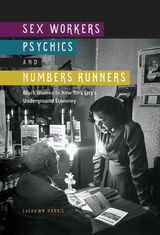 Sex Workers, Psychics, and Numbers Runners: Black Women in New York City's Underground Economy
LaShawn Harris
University of Illinois Press, 2016 During the early twentieth century, a diverse group of African American women carved out unique niches for themselves within New York City's expansive informal economy. LaShawn Harris illuminates the labor patterns and economic activity of three perennials within this kaleidoscope of underground industry: sex work, numbers running for gambling enterprises, and the supernatural consulting business. Mining police and prison records, newspaper accounts, and period literature, Harris teases out answers to essential questions about these women and their working lives. She also offers a surprising revelation, arguing that the burgeoning underground economy served as a catalyst in working-class black women ™s creation of the employment opportunities, occupational identities, and survival strategies that provided them with financial stability and a sense of labor autonomy and mobility. At the same time, urban black women, all striving for economic and social prospects and pleasures, experienced the conspicuous and hidden dangers associated with newfound labor opportunities.
Sexes: The Marriage Dialogues
Samuel Hazo
Northwestern University Press, 2014 The poems in Samuel Hazo’s Sexes: The Marriage Dialogues are concerned with how husbands and wives confront each other at life’s various intersections—sometimes casually, sometimes profoundly. It is at these points that the most interesting differences in gender reveal themselves. From the first poem (“Banterers”) to the last (“Ballad of the Old Lovers”) Hazo’s attuned ear picks up quotidian conversational exchanges, but the words are never window dressing. They hint at inevitable insights and misunderstandings born out of conjugal love. Each poem is a vignette of the moving and surprising moments that are married life.
 Sexing Empire: Bodies, Gender, and Desire in Colonial and Postcolonial Power Relations
Ben Cowan, Nicole M. Guidotto-Hernández, and Jason Ruiz, special issue editors
Duke University Press From steamships to steam rooms and sweat lodges to sweatshops, processes of pleasures and desire have shaped the regulation and classification of bodies in a wide variety of colonial settings. On beaches and online, and in boardrooms, temples, and taverns, sexual practices have always influenced imperial power relations. In the many places and relationships where colonialism still affects economics, sex and sexuality remain a driving—if sometimes hidden—force. The contributors to this provocative issue contemplate empire as a global process involving sexualized subjects and objects, with essays that consider the history of sex and (or in) empire across several disciplines. Their topics include a "bewitched" nun in colonial Peru, contemporary call-center workers in the Philippines, and General Douglas MacArthur’s mixed-race Filipina mistress, among many others. Ben Cowan is assistant professor of world history at George Mason University. Nicole M. Guidotti-Hernández is associate professor of American studies at the University of Texas at Austin and the author of Unspeakable Violence: Remapping U.S. and Mexican National Imaginaries, also published by Duke University Press. Jason Ruiz is assistant professor of American studies at the University of Notre Dame and the author of Americans in the Treasure House: Travel to Porfirian Mexico and the Cultural Politics of Empire. Contributors: Laura Briggs, Keith Camacho, Ben Cowan, Emmanuel David, Vernadette Vicuña Gonzalez, Nicole M. Guidotti-Hernández, Elizabeth Mesok, Rachel Sarah O’Toole, Katrina Phillips, Jason Ruiz
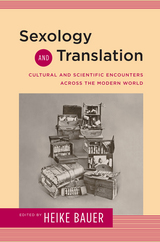 Sexology and Translation: Cultural and Scientific Encounters across the Modern World
Heike Bauer
Temple University Press, 2015 Sexology and Translation is the first study of the contemporaneous emergence of sexology in Europe, Asia, and the Middle East. Heike Bauer and her contributors—historians, literary and cultural critics, and translation scholars—address the intersections between sexuality and modernity in a range of contexts during the period from the 1880s to the 1930s. From feminist sexualities in modern Japan to Magnus Hirschfeld’s affective sexology, this book offers compelling new insights into how sexual ideas were formed in different contexts via a complex process of cultural negotiation. By focusing on issues of translation—the dynamic process by which ideas are produced and transmitted—the essays in Sexology and Translation provide an important corrective to the pervasive idea that sexuality is a “Western” construct that was transmitted around the world. This volume deepens understanding of how the intersections between national and transnational contexts, between science and culture, and between discourse and experience, shaped modern sexuality.
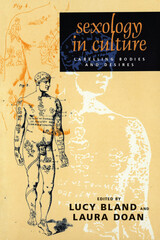 Sexology in Culture: Labelling Bodies and Desires
Edited by Lucy Bland and Laura Doan
University of Chicago Press, 1998 The key founders of sexology, the "science of desire," were Havelock Ellis, Richard von Krafft-Ebing, and Magnus Hirschfeld. This volume examines the impact of their writings on English-speaking culture from the 1880s to the early 1940s. How influential a field was sexology during this period, and how much power did sexologists wield? What was the impact of their work on popular and official attitudes to sex?
Lucy Bland and Laura Doan have brought together leading historians of sex, cultural and literary critics, and scholars in gay, lesbian, and queer studies, to reassess current debates on sexology in light of its history. They address issues such as the relation of "sexual science" to the law, government policy, journalism, eugenics programs, marriage and sex manuals, and literary representation. They also map out new readings of transsexuality and bisexuality, and the centrality of race within sexology.
Sexology in Culture and its companion Sexology Uncensored will interest all those concerned with understanding modern sexual discourse in its historical context.
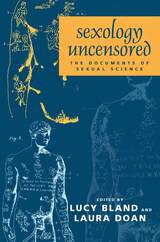 Sexology Uncensored: The Documents of Sexual Science
Edited by Lucy Bland and Laura Doan
University of Chicago Press, 1998 Sexology Uncensored brings together, for the first time, many of the key documents of the modern science of sexuality that emerged in the late nineteenth century. The early pioneers of the new field of sexology examined and classified sexual behaviors, identities, and relations. For years much of the material here has been "censored" in the sense that it is difficult to obtain, subject to restrictive circulation, or available only in medical archives. The extracts (which date from the 1880s to the 1940s) cover a variety of topics including gender and sexual difference; homosexuality; transsexuality and bisexuality; heterosexuality; marriage and sex manuals; reproductive control; eugenics; race; and various sexual proclivities.
Offering readers access to the primary materials on which contemporary sexology is founded, Sexology Uncensored is an invaluable record for all those interested in how we have come to think about sex and sexuality over the last hundred years.
Sexology in Culture and its companion Sexology Uncensored will interest all those concerned with understanding modern sexual discourse in its historical context.
Sexting Panic: Rethinking Criminalization, Privacy, and Consent
Amy Adele Hasinoff
University of Illinois Press, 2015 Sexting Panic illustrates how anxieties about technology and teen girls' sexuality distract from critical questions about how to adapt norms of privacy and consent for new media. Though mobile phones can be used to cause harm, Amy Adele Hasinoff notes that criminalization and abstinence policies meant to curb sexting often fail to account for the distinction between consensual sharing and the malicious distribution of a private image. Hasinoff challenges the idea that sexting inevitably victimizes young women. Instead, she encourages us to recognize young people's capacity for choice and recommends responses to sexting that are realistic and nuanced rather than based on misplaced fears about deviance, sexuality, and digital media.
SEXTON: SELECTED CRITICISM
Edited by Diana Hume George
University of Illinois Press, 1988 Anne Sexton (1928-74) was among the most daring of New England's confessional poets. Long after her death, the "confessional" label has prevented readers and critics from appreciating the full range of Sexton's poetic achievement. Sexton: Selected Criticism cracks open the critical bell jar surrounding Sexton to reveal a lively, ongoing conversation among scholars about the enduring popularity and significance of this Pulitzer Prize-winning American poet. Offering original and provocative ways to read her work, sixteen leading authorities on Sexton approach her writing from feminist, psychoanalytic, and biographical perspectives.
Sexual Bargaining: Power Politics in the American Marriage
John Scanzoni
University of Chicago Press, 1982 Is the institution of marriage in America breaking down? Is marriage as we have known it largely irrelevant? Are the forms of marriage changing? Are the changes in women's roles in society related to the breakdown, irrelevance, and formal alteration of marriage?
In this updated edition of his fundamental study of modern marriage, John Scanzoni challenges the widespread assumption that marriage is a dying institution. By analyzing the "reward seeking" which generates conflicts between males and females, he shows that marriage indeed has a future but that its form will continue to change as sex-role equality emerges both within and outside of marriage.
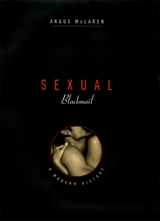 Sexual Blackmail: A Modern History
Angus McLaren
Harvard University Press, 2002 Sexual blackmail first reached public notice in the late eighteenth century when laws against sodomy were exploited by the unscrupulous to extort money from those they could entrap. Angus McLaren chronicles this parasitic crime, tracing its expansion in England and the United States through the Victorian era and into the first half of the twentieth century. The labeling of certain sexual acts as disreputable, if not actually criminal--abortion, infidelity, prostitution, and homosexuality--armed would-be blackmailers and led to a crescendo of court cases and public scandals in the 1920s and 1930s. As the importance of sexual respectability was inflated, so too was the spectacle of its loss.
Charting the rise and fall of sexual taboos and the shifting tides of shame, McLaren enables us to survey evolving sexual practices and discussions. He has mined the archives to tell his story through a host of fascinating characters and cases, from male bounders to designing women, from badger games to gold diggers, from victimless crimes to homosexual outing. He shows how these stories shocked, educated, entertained, and destroyed the lives of their victims. He also demonstrates how muckraking journalists, con men, and vengeful women determined the boundaries of sexual respectability and damned those considered deviant. Ultimately, the sexual revolution of the 1960s blurred the long-rigid lines of respectability, leading to a rapid decline of blackmail fears. This fascinating view of the impact of regulating sexuality from the late Victorian Age to our own time demonstrates the centrality of blackmail to sexual practices, deviance, and the law.
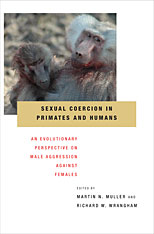 Sexual Coercion in Primates and Humans: An Evolutionary Perspective on Male Aggression against Females
Martin N. Muller
Harvard University Press, 2009 Conflict between males and females over reproduction is ubiquitous in nature due to fundamental differences between the sexes in reproductive rates and investment in offspring. In only a few species, however, do males strategically employ violence to control female sexuality. Why are so many of these primates? Why are females routinely abused in some species, but never in others? And can the study of such unpleasant behavior by our closest relatives help us to understand the evolution of men’s violence against women?
In the first systematic attempt to assess and understand primate male aggression as an expression of sexual conflict, the contributors to this volume consider coercion in direct and indirect forms: direct, in overcoming female resistance to mating; indirect, in decreasing the chance the female will mate with other males. The book presents extensive field research and analysis to evaluate the form of sexual coercion in a range of species—including all of the great apes and humans—and to clarify its role in shaping social relationships among males, among females, and between the sexes.
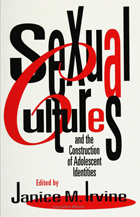 Sexual Cultures and the Construction of Adolescent Identities
edited by Janice M. Irvine
Temple University Press, 1994 This rich collection of essays presents a new vision of adolescent sexuality shaped by a variety of social factors: race and ethnicity, gender, sexual identity, physical ability, and cultural messages propagated in films, books, and within families. The contributors consider the full range of cultural influences that form a teenager's sexual identity and argue that education must include more than its current overriding message of denial hinged on warnings of HIV and AIDS infection and teenage pregnancy. Examining the sexual experiences, feelings, and development of Asians, Latinos, African Americans, gay man and lesbians, and disabled women, this book provides a new understanding of adolescent sexuality that goes beyond the biological approach all too often simplified as "surging hormones."
In the series Health, Society, and Policy, edited by Sheryl Ruzek and Irving Kenneth Zola.
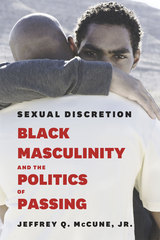 Sexual Discretion: Black Masculinity and the Politics of Passing
Jeffrey Q. McCune, Jr.
University of Chicago Press, 2014 African American men who have sex with men while maintaining a heterosexual lifestyle in public are attracting increasing interest from both the general media and scholars. Commonly referred to as “down-low” or “DL” men, many continue to have relationships with girlfriends and wives who remain unaware of their same-sex desires, and in much of the media, DL men have been portrayed as carriers of HIV who spread the virus to black women. Sexual Discretion explores the DL phenomenon, offering refreshingly innovative analysis of the significance of media, space, and ideals of black masculinity in understanding down low communities.
In Sexual Discretion, Jeffrey Q. McCune Jr. provides the first in-depth examination of how the social expectations of black masculinity intersect and complicate expressions of same-sex affection and desire. Within these underground DL communities, men aren’t as highly policed—and thus are able to maintain their public roles as “properly masculine.” McCune draws from sources that range from R&B singer R. Kelly’s epic hip-hopera series Trapped in the Closet to Oprah's high-profile exposé on DL subculture; and from E. Lynn Harris’s contemporary sexual passing novels to McCune’s own interviews and ethnography in nightclubs and online chat rooms. Sexual Discretion details the causes, pressures, and negotiations driving men who rarely disclose their intimate secrets.
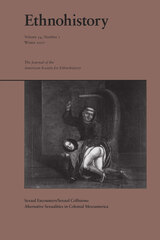 Sexual Encounters/Sexual Collisions: Alternative Sexualities in Colonial Mesoamerica, Volume 54
Pete Sigal and John F. Chuchiak IV, eds.
Duke University Press This special issue of Ethnohistory explores the relationships among sexuality, power, and desire in colonial Mesoamerica. Investigating conflicts over sexuality, the essays illustrate the importance of sexual behaviors and desires in negotiating identities and complex power relations in the Mesoamerican world. Taken together, they make a compelling argument that an understanding of the role of sexuality is as essential to the study of Latin America as is knowledge about political economy, social organization, ethnicity, and gender. One contributor considers a criminal case in seventeenth-century Mexico that demonstrates that the negotiation of homosexual identity was much more complex than the model of domination and submission often believed to structure Latin American male homosexual relationships. Another contributor examines how priests in Mayan communities attempted to use the confessional and confessional manuals to promote their own notions of sexual desire and ownership of indigenous women, only to have their efforts turned against them, with Mayan women using the texts to assert strategic dominance over the priests. Yet another essay, focusing on the treatment of a hermaphrodite in late colonial Guatemala, examines how the hermaphrodite’s traits undermined or called into question Enlightenment-era ideas about sex and gender. Contributors. John F. Chuchiak IV, Martha Few, Kimberly Gauderman, Laura A. Lewis, Caterina Pizzigoni, Pete Sigal, Zeb Tortorici, Neil L. Whitehead
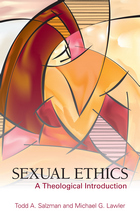 Sexual Ethics: A Theological Introduction
Todd A. Salzman and Michael G. Lawler
Georgetown University Press, 2012 Two principles capture the essence of the Catholic tradition on sexual ethics: that each and every marriage act must remain open to the transmission of life, and that any human genital act must occur within the framework of marriage. In the Catholic tradition, moral sexual activity is institutionalized within the confines of marriage and procreation, and sexual morality is marital morality. But theologians Todd Salzman and Michael Lawler contend that there is a disconnect between many of the Church’s absolute sexual norms and other theological and intellectual developments explicitly recognized and endorsed in the Catholic tradition, especially since the Second Vatican Council. These developments include the shift from a primary static worldview to a historically conscious worldview, one that recognizes reality as dynamic, evolving, changing, and particular. By employing such a historically conscious worldview, alternative claims about the moral legitimacy of controversial topics such as contraception, artificial reproduction, and homosexual marriage can faithfully emerge within a Catholic context. Convinced of the central role that love, desire, and fertility play in a human life, and also in the life of Christian discipleship, the authors propose an understanding of sexuality that leads to the enhancement of human sexual relationships and flourishing. This comprehensive introduction to Catholic sexual ethics—complete with thought-provoking study questions at the end of each chapter—will be sure to stimulate dialogue about sexual morality between Catholic laity, theologians, and the hierarchy. Anyone seeking a credible and informed Catholic sexual ethic will welcome this potentially revolutionary book.
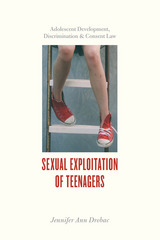 Sexual Exploitation of Teenagers: Adolescent Development, Discrimination, and Consent Law
Jennifer Ann Drobac
University of Chicago Press, 2016 When we consider the concept of sexual abuse and harassment, our minds tend to jump either towards adults caught in unhealthy relationships or criminals who take advantage of children. But the millions of maturing teenagers who also deal with sexual harassment can fall between the cracks.
When it comes to sexual relationships, adolescents pose a particular problem. Few teenagers possess all of the emotional and intellectual tools needed to navigate these threats, including the all too real advances made by supervisors, teachers, and mentors. In Sexual Exploitation of Teenagers, Jennifer Drobac explores the shockingly common problem of maturing adolescents who are harassed and exploited by adults in their lives. Reviewing the neuroscience and psychosocial evidence of adolescent development, she explains why teens are so vulnerable to adult harassers. Even today, in an age of increasing public awareness, criminal and civil law regarding the sexual abuse of minors remains tragically inept and irregular from state to state. Drobac uses six recent cases of teens suffering sexual harassment to illuminate the flaws and contradictions of this system, skillfully showing how our current laws fail to protect youths, and offering an array of imaginative legal reforms that could achieve increased justice for adolescent victims of sexual coercion.
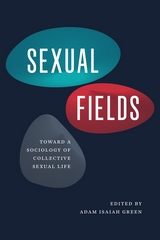 Sexual Fields: Toward a Sociology of Collective Sexual Life
Edited by Adam Isaiah Green
University of Chicago Press, 2013 In the late modern period, an unprecedented expansion of specialized erotic worlds has transformed the domain of intimate life. Organized by appetites and dispositions related to race, ethnicity, class, gender, and age, these erotic worlds are arenas of sexual exploration but, also, sites of stratification and dominion wherein actors vie for partners, social significance, and esteem. These are what Adam Isaiah Green calls sexual fields, which represent a semblance of social life for which he offers a groundbreaking new framework.
To build on the sexual fields framework, Green has gathered a distinguished group of scholars who together make a strong case for sexual field theory as the first systematic theoretical innovation since queer theory in the sociology of sexuality. Expanding on the work of Bourdieu, Green and contributors develop this distinctively sociological approach for analyzing collective sexual life, where much of the sexual life of our society resides today. Coupling field theory with the ethnographic and theoretical expertise of some of the most important scholars of sexual life at work today, Sexual Fields offers a game-changing approach that will revolutionize how sociologists analyze and make sense of contemporary sexual life for years to come.
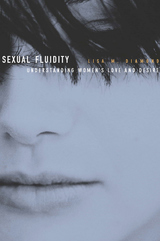 Sexual Fluidity: Understanding Women’s Love and Desire
Lisa M. Diamond
Harvard University Press, 2008 Is love “blind” when it comes to gender? For women, it just might be. This unsettling and original book offers a radical new understanding of the context-dependent nature of female sexuality. Lisa M. Diamond argues that for some women, love and desire are not rigidly heterosexual or homosexual but fluid, changing as women move through the stages of life, various social groups, and, most important, different love relationships.This perspective clashes with traditional views of sexual orientation as a stable and fixed trait. But that view is based on research conducted almost entirely on men. Diamond is the first to study a large group of women over time. She has tracked one hundred women for more than ten years as they have emerged from adolescence into adulthood. She summarizes their experiences and reviews research ranging from the psychology of love to the biology of sex differences. Sexual Fluidity offers moving first-person accounts of women falling in and out of love with men or women at different times in their lives. For some, gender becomes irrelevant: “I fall in love with the person, not the gender,” say some respondents.Sexual Fluidity offers a new understanding of women’s sexuality—and of the central importance of love.
 Sexual Generations: Star Trek: The Next Generation and Gender
Robin Roberts
University of Illinois Press, 1999 Boldly going where no one has gone before, Robin Roberts forges intriguing links between feminist politics and theory and the second Star Trek series, Star Trek: The Next Generation. This lively discussion shows how science fiction's ability to make the familiar strange allows Star Trek to expose and comment on entrenched attitudes toward gender roles and feminist issues. By having aliens or sexually neutral beings enact female dominance or passivity, experience pregnancy or maternity, or suffer rape or abortion, Star Trek provides viewers with a new perspective on these experiences and an antidote to explicit and implicit cultural biases. Roberts maintains that the relevance of Star Trek: The Next Generation to feminist issues accounts as no other factor can for the program's huge following of female fans.
The incisive and innovative readings in Sexual Generations provide food for thought about how the final frontier can clarify pressing questions of our own space and time.
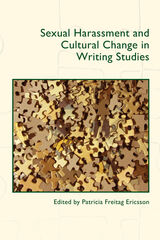 Sexual Harassment and Cultural Change in Writing Studies
Patricia Freitag Ericsson
University Press of Colorado, 2020 This collective project provides vital groundwork for understanding sexual harassment as well as encouraging the difficult conversations that are steps to awareness, action, and prevention. The project mandates a heightened consciousness of sexual harassment in American culture and underscores the profound commitment to cultural change necessary to eradicate this toxic social issue. Focusing on writing studies but applicable to other areas of higher education, the authors provide history, definitional backgrounds, best-practice approaches to prevention, scenarios for anti-sexual harassment training, and an extensive bibliography. The contributors have created a dynamic resource for a wide variety of audiences, including those who are leading programs, training new faculty and graduate students, preparing peer tutors, designing workshops, and teaching both undergraduate and graduate classes. This book can be used to start conversations, construct training, and improve policy—all of these in the contexts of local situations and constraints.
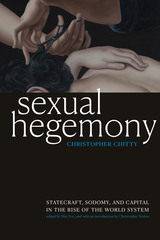 Sexual Hegemony: Statecraft, Sodomy, and Capital in the Rise of the World System
Christopher Chitty
Duke University Press, 2020 In Sexual Hegemony Christopher Chitty traces the five-hundred year history of capitalist sexual relations by excavating the class dynamics of the bourgeoisie's attempts to regulate homosexuality. Tracking the politicization of male homosexuality in Renaissance Florence, Amsterdam, Paris, and London between the seventeenth and nineteenth centuries, as well as twentieth-century New York City, Chitty shows how sexuality became a crucial dimension of the accumulation of capital and a technique of bourgeois rule. Whether policing male sodomy during the Medici rule in Florence or accusing the French aristocracy of monstrous sexuality in the wake of the French Revolution, the bourgeoisie weaponized both sexual constraint and sexual freedom in order to produce and control a reliable and regimented labor class and subordinate it to civil society and the state. Only by grasping sexuality as a field of social contention and the site of class conflict, Chitty contends, can we embark on a politics that destroys sexuality as a tool and an effect of power and open a front against the forces that keep us unfree.
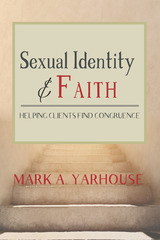 Sexual Identity and Faith: Helping Clients Find Congruence
Mark A. Yarhouse
Templeton Press, 2019 Christians who struggle with a conflict between their sexual and religious identities have few therapeutic options available to them. ‘Sexual orientation change efforts’ (SOCE) have rightly fallen out of favor and are no longer practiced by most clinicians. At the same time, the common approach of gay affirmative therapy (GAT) can at times present challenges and may not be a good fit when clients hold to conventional religious beliefs and values. An alternative to these methods is Sexual Identity Therapy (SIT)—an approach that aims to provide individuals with a safe therapeutic space to explore the tension between their sexuality and their faith. Working within the SIT framework, clients are able to resolve their inner conflict to their personal satisfaction and to freely choose a coherent identity that enables them to move forward in life. SIT has several stages, each designed to enable the client to make meaning out of his or her same-sex sexuality. At no point in the process is the client encouraged to choose one sexual identity over another. The ultimate goal of SIT is congruence. Congruence is achieved when a person freely adopts an identity and lives it out in ways that are in keeping with his or her beliefs and values. The SIT model is brought to life throughout the book with the help of case studies drawn from the author’s 20 years of experience. Written for both Christian and non-religious clinicians, Sexual Identity and Faith is an informed, respectful, and nuanced guide to help people navigate the difficult conflict between who they are sexually and what they believe religiously.
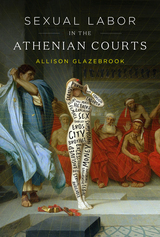 Sexual Labor in the Athenian Courts
Allison Glazebrook
University of Texas Press, 2021 Oratory is a valuable source for reconstructing the practices, legalities, and attitudes surrounding sexual labor in classical Athens. It provides evidence of male and female sex laborers, sex slaves, brothels, sex traffickers, the cost of sex, contracts for sexual labor, and manumission practices for sex slaves. Yet the witty, wealthy, and independent hetaira, well-known from other genres, does not feature. Its detailed narratives and character portrayals provide a unique discourse on sexual labor and reveal the complex relationship between such labor and Athenian society. Through a holistic examination of five key speeches, Sexual Labor in the Athenian Courts considers how portrayals of sex laborers intersected with gender, the body, sexuality, the family, urban spaces, and the polis in the context of the Athenian courts. Drawing on gender theory and exploring questions of space, place, and mobility, Allison Glazebrook shows how sex laborers represented a diverse set of anxieties concerning social legitimacy and how the public discourse about them is in fact a discourse on Athenian society, values, and institutions.
The Sexual Labyrinth of Nikolai Gogol
Simon Karlinsky
University of Chicago Press, 1992 Through careful textual readings of Gogol's most famous works, Karlinsky argues that Gogol's homosexual orientation—which Gogol himself could not accept or forgive in himself—may provide the missing key to the riddle of Gogol's personality.
"A brilliant new biography that will long be prized for its illuminating psychological insights into Gogol's actions, its informative readings of his fiction and drama, and its own stylistic grace and vivacity."—Edmund White, Washington Post Book World
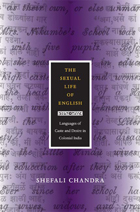 The Sexual Life of English: Languages of Caste and Desire in Colonial India
Shefali Chandra
Duke University Press, 2012 In The Sexual Life of English, Shefali Chandra examines how English became an Indian language. She rejects the idea that English was fully formed before its life in India or that it was imposed from without. Rather, by drawing attention to sexuality and power, Chandra argues that the English language was produced through conflicts over caste, religion, and class. Sentiments and experiences of desire, respectability, conjugality, status, consumption, and fashion came together to create the Indian history of English. The language was shaped by the sexual experiences of Indians and by native attempts to discipline the normative sexual subject. Focusing on the years between 1850 and 1930, Chandra scrutinizes the English-education project as Indians gained the power to direct it themselves. She delves into the history of schools, the composition of the student bodies, and disagreements about curricula; the way that English-educated subjects wrote about English; and debates in English and Marathi popular culture. Chandra shows how concerns over linguistic change were popularly voiced in a sexual idiom, how English and the vernacular were separated through the vocabulary of sexual difference, and how the demand for matrimony naturalized the social location of the English language.
 The Sexual Metaphor
Helen Haste
Harvard University Press, 1994 Give the little boy a gun; offer the little girl a doll—how many years of feminism would it take to uncover the meaning behind such assumptions? After decades of attacks on intractable sexual stereotypes, the time is right to ask what makes them so compelling and resistant to change. In The Sexual Metaphor, Helen Haste does just that, exposing the deep cultural roots of our insistent distinctions between masculine and feminine.
To understand changing sex roles, Haste suggests that we recognize the role that gender plays in how we make sense of the world, particularly through the use of metaphor. As she demonstrates, the assault on traditional conceptions of gender is in fact a confrontation with the metaphor of dualism, or polarity, that underlies Western culture, informing our models of rationality and control. Here our anxieties about our own masculinity or femininity encounter a cultural tangle of opposites—public and private, order and chaos, thinking and feeling, active and passive, hard and soft, positive and negative. Drawing on research in the fields of sociology, anthropology, the history of science, paleontology, and philosophy, as well as her own field of psychology, Haste demonstrates the pervasiveness of the metaphor of dualism in large areas of our lives and our thinking, and of metaphor itself as a mode of thought expressing theories about the world in science and popular culture. Her work, accessible to social scientists and general readers alike, is a stimulating tour of the dark, divided territory that is the backdrop for our organization of everyday experience, society, and sexual identity.
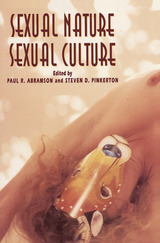 Sexual Nature/Sexual Culture
Edited by Paul R. Abramson and Steven D. Pinkerton
University of Chicago Press, 1995 In this multidisciplinary study of human sexuality, an international team of scholars looks at the influences of nature and nurture, biology and culture, and sex and gender in the sexual experiences of humans and other primates.
Using as its center the idea that sexual pleasure is the primary motivational force behind human sexuality and that reproduction is simply a byproduct of the pleasurability of sex, this book examines sexuality at the individual, societal, and cultural levels. Beginning with a look at the evolution of sexuality in humans and other primates, the essays in the first section examine the sexual ingenuity of primates, the dominant theories of sexual behavior, the differences in male and female sexual interest and behavior, and the role of physical attractiveness in mate selection. The focus then shifts to biological approaches to sexuality, especially the genetic and hormonal origins of sexual orientation, gender, and pleasure.
The essays go on to look at the role of pleasure in different cultures. Included are essays on love among the tribespeople of the Brazilian rain forest and the regulation of adolescent sexuality in India. Finally, several contributors look at the methodological issues in the study of human sexuality, paying particular attention to the problems with research that relies on people's memories of their sexual experiences.
The contributors are Angela Pattatucci, Dean Hamer, David Greenberg, Frans de Waal, Mary McDonald Pavelka, Kim Wallen, Donald Symons, Heino Meyer-Bahlburg, Jean D. Wilson, Donald Tuzin, Lawrence Cohen, Thomas Gregor, Lenore Manderson, Robert C. Bailey, Alice Schlegel, Edward H. Kaplan, Richard Berk, Paul R. Abramson, Paul Okami, and Stephen D. Pinkerton.
Spanning the chasm of the nature versus nurture debate, Sexual Nature/Sexual Culture is a look at human sexuality as a complex interaction of genetic potentials and cultural influences. This book will be of interest to a wide range of readers—from scholars and students in psychology, anthropology, sociology, and history to clinicians, researchers, and others seeking to understand the many dimensions of sexuality.
"If we ever expect to solve the sexually based problems that modern societies face, we must encourage investigations of human sexual behavior. Moreover, those investigations should employ a broad range of disciplines—looking at sex from all angles, which is precisely what Sexual Nature, Sexual Culture does."—Mike May, American Scientist
"...This timely and relevant book reminds us that we cannot rely on simple solutions to complex problems. It represents a transdiciplinary approach integrating knowledge from diverse fields and provides the reader with a challenging and rewarding experience. Especially for those who are involved in teaching human sexuality to medical students and other health care professionals, this book is highly recommended."—Gerald Wiviortt, M.D., Journal of Nervous and Mental Disease
"In short, this volume contains much to stimulate, inform, and amuse, in varying proportions. What more can one ask?"—Pierre L. van den Berghe, Journal of the History of Sexuality
"...the book succeeds in bring together some of the sharpest thinkers in the field of human sexuality, and goes a long way toward clarifying the diverse perspectives that currently exist."—David M. Buss and Todd K. Shackelford, Quarterly Review of Biology
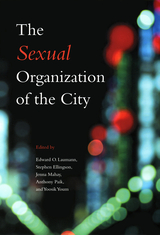 The Sexual Organization of the City
Edited by Edward O. Laumann, Stephen Ellingson, Jenna Mahay, Anthony Paik, and Y
University of Chicago Press, 2004 We think of the city as a place where anything goes. Take the sensational fantasies and lurid antics of single women on Sex in the City or young men on Queer as Folk, and you might imagine the city as some kind of sexual playground—a place where you can have any kind of sex you want, with whomever you like, anytime or anywhere you choose.
But in The Sexual Organization of the City, Edward Laumann and company argue that this idea is a myth. Drawing on extensive surveys and interviews with Chicago adults, they show that the city is—to the contrary—a place where sexual choices and options are constrained. From Wicker Park and Boys Town to the South Side and Pilsen, they observe that sexual behavior and partnering are significantly limited by such factors as which neighborhood you live in, your ethnicity, what your sexual preference might be, or the circle of friends to which you belong. In other words, the social and institutional networks that city dwellers occupy potentially limit their sexual options by making different types of sexual activities, relationships, or meeting places less accessible.
To explain this idea of sex in the city, the editors of this work develop a theory of sexual marketplaces—the places where people look for sexual partners. They then use this theory to consider a variety of questions about sexuality: Why do sexual partnerships rarely cross racial and ethnic lines, even in neighborhoods where relatively few same-ethnicity partners are available? Why do gay men and lesbians have few public meeting spots in some neighborhoods, but a wide variety in others? Why are African Americans less likely to marry than whites? Does having a lot of friends make you less likely to get a sexually transmitted disease? And why do public health campaigns promoting safe sex seem to change the behaviors of some, but not others?
Considering vital questions such as these, and shedding new light on the city of Chicago, this work will profoundly recast our ideas about human sexual behavior.
 Sexual Orientation and the Law
Harvard Law Review
Harvard University Press, 1990 Attitudes toward homosexuality range from condemnation to pity to indifference to respect. This range of viewpoints also appears in the legal community, reflected in legislation, legal decisionmaking, and legal scholarship. Sexual Orientation and the Law examines the legal problems faced by gay men and lesbians: the interaction between gays and the criminal justice system; discrimination in public and private employment; first amendment issues posed by gay students and teachers in public schools and universities; legal problems faced in same-sex relationships; child custody and visitation rights, as well as the ability to become foster and adoptive parents; and other contexts, including immigration, insurance, incorporation of gay rights organizations, and local legislation to prevent sexual orientation discrimination.
The Introduction establishes a theoretical framework for approaching gay and lesbian legal issues, and an Afterword updates the comprehensive coverage of all legal developments through the summer of 1989. This review and analysis of the current state of the law is an important part of the discussion and debate that will make antigay discrimination recognized as a legitimate issue and gay concerns part of the mainstream of legal discourse.
 The Sexual Person: Toward a Renewed Catholic Anthropology
Todd A. Salzman and Michael G. Lawler
Georgetown University Press, 2008 Two principles capture the essence of the official Catholic position on the morality of sexuality: first, that any human genital act must occur within the framework of heterosexual marriage; second, each and every marriage act must remain open to the transmission of life. In this comprehensive overview of Catholicism and sexuality, theologians Todd A. Salzman and Michael G. Lawler examine and challenge these principles. Remaining firmly within the Catholic tradition, they contend that the church is being inconsistent in its teaching by adopting a dynamic, historically conscious anthropology and worldview on social ethics and the interpretation of scripture while adopting a static, classicist anthropology and worldview on sexual ethics. While some documents from Vatican II, like Gaudium et spes ("the marital act promotes self-giving by which spouses enrich each other"), gave hope for a renewed understanding of sexuality, the church has not carried out the full implications of this approach. In short, say Salzman and Lawler: emphasize relationships, not acts, and recognize Christianity's historically and culturally conditioned understanding of human sexuality. The Sexual Person draws historically, methodologically, and anthropologically from the best of Catholic tradition and provides a context for current theological debates between traditionalists and revisionists regarding marriage, cohabitation, homosexuality, reproductive technologies, and what it means to be human. This daring and potentially revolutionary book will be sure to provoke constructive dialogue among theologians, and between theologians and the Magisterium.
Sexual Politics and Popular Culture
Diane Raymond
University of Wisconsin Press, 1990 Almost wherever we look, depictions of sexuality, both subtle and not-so-subtle, are omnipresent. Whatever the medium, popular culture representations tell us something about ourselves and about the ideologies of which they are symptomatic. These essays examine the strategies of power implicit in popular representations of sexuality. The authors—scholars in fields such as sociology, philosophy, biology, political science, history, and English literature— eschew rigid disciplinary boundaries.
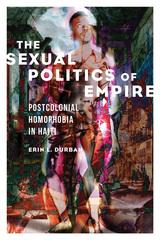 The Sexual Politics of Empire: Postcolonial Homophobia in Haiti
Erin L. Durban
University of Illinois Press, 2023 Winner in the LAMMY Awards – Lambda Literary Awards, LGBTQ+ Studies category Evangelical Christians and members of the global LGBTQI human rights movement have vied for influence in Haiti since the 2010 earthquake. Each side accuses the other of serving foreign interests. Yet each proposes future foreign interventions on behalf of their respective causes despite the country’s traumatic past with European colonialism and American imperialism. As Erin L. Durban shows, two discourses dominate discussions of intervention. One maintains imperialist notions of a backward Haiti so riddled with cultural deficiencies that foreign supervision is necessary to overcome Haitians’ resistance to progress. The other sees Haiti as a modern but failed state that exists only through its capacity for violence, including homophobia. In the context of these competing claims, Durban explores the creative ways that same-sex desiring and gender creative Haitians contend with anti-LGBTQI violence and ongoing foreign intervention. Compelling and thought-provoking, The Sexual Politics of Empire examines LGBTQI life in contemporary Haiti against the backdrop of American imperialism and intervention.
The Sexual Politics of Jean-Jacques Rousseau
Joel Schwartz
University of Chicago Press, 1984 Joel Schwartz presents the first systematic treatment of Rousseau's understanding of the political importance of women, sexuality, and the family. Using both Rousseau's lesser-known literary works and such major writings as Emile, Julie, and The Second Discourse, he offers an original and provocative presentation of Rousseau's argument. To read Rousseau, Schwartz believes, is to enter into a profound discourse about the meaning of sexual equality and the opportunities, pitfalls, costs, and benefits that sexual relationships bestow and impose on us all. His own thoughtful reading of Rousseau opens up fresh perspectives on political philosophy and the history of sexual, masculine, and feminine psychology.
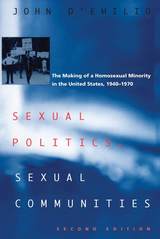 Sexual Politics, Sexual Communities: Second Edition
John D'Emilio
University of Chicago Press, 1998 With thorough documentation of the oppression of homosexuals and biographical sketches of the lesbian and gay heroes who helped the contemporary gay culture to emerge, Sexual Politics, Sexual Communities supplies the definitive analysis of the homophile movement in the U.S. from 1940 to 1970. John D'Emilio's new preface and afterword examine the conditions that shaped the book and the growth of gay and lesbian historical literature.
"How many students of American political culture know that during the McCarthy era more people lost their jobs for being alleged homosexuals than for being Communists? . . . These facts are part of the heretofore obscure history of homosexuality in America—a history that John D'Emilio thoroughly documents in this important book."—George DeStefano, Nation
"John D'Emilio provides homosexual political struggles with something that every movement requires—a sympathetic history rendered in a dispassionate voice."—New York Times Book Review
"A milestone in the history of the American gay movement."—Rudy Kikel, Boston Globe
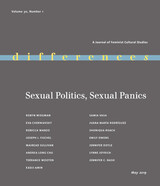 Sexual Politics, Sexual Panics
Robyn Wiegman, special issue editor
Duke University Press This special issue of differences provides spirited commentaries on the critical and political stakes of contemporary sexual politics in the United States. In a series of short keyword essays in the first half of the issue, contributors interrogate the implications and assumptions behind significant terms such as #metoo, consent, testimony, solidarity, pedophile, and trigger warning. The second half of the issue features in-depth essays that critique how universities have become spaces for pedagogy around affirmative consent; connect Larry Nassar's serial sexual assaults to feminist writing about the systemic nature of sexual violence; argue for the possibilities for black women’s sexual citizenship that exist within overlooked or dismissed domains; and analyze the continued relevance of feminist legal thinker Catharine MacKinnon. Together, the contributors demonstrate that now is the time to interrogate the politics of sex in the political present.
Contributors. Kadji Amin, Eva Cherniavsky, Andrea Long Chu, Jennifer Doyle, Joseph J. Fischel, Lynne Joyrich, Jennifer C. Nash, Emily Owens, Shoniqua Roach, Juana María Rodríguez, Mairead Sullivan, Samia Vasa, Rebecca Wanzo, Robyn Wiegman, Terrance Wooten
Sexual Politics, Volume 15
Elizabeth Weed and Ellen Rooney, eds.
Duke University Press Drawing on sociology, political theory, feminism, history, and human rights law, the essays in this special issue of differences investigate the complex international sexual politics of France, Italy, Turkey, and Sudan and reveal the extent to which sexuality and its itinerant discourses are complexly embedded in the very meanings and operations of political institutions throughout the world. Contributors. Rogaia Mustafa Abusharaf, Jacqueline Bhabha, Wendy Brown, Dicle Kogacioglu, Joan Wallach Scott, Linda M. G. Zerilli
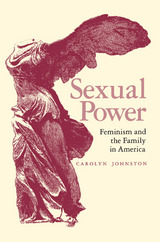 Sexual Power: Feminism and the Family in America
Carolyn Ross Johnston
University of Alabama Press, 1992 Offers an opportunity to view the history of feminism and the family from a fresh perspective
Since the early 1970s, scholars have argued, defined, and refined a wide range of interpretations of American women’s lives. Despite the richness of the recent literature, few interpretations sufficiently credit women’s family and sexual experiences for the emergence of feminism and the construction of pro-family agendas. Thus, Johnston’s approach offers an opportunity to view the history of feminism and the family from a fresh perspective.
Much of the literature on feminism has focused on women’s oppression and victimization, rather than on the power that women historically have exerted. Johnston’s interpretation of American feminism differs from previous works because she argues that the gradual growth of feminist consciousness lies not simply in oppression or feelings of victimization, but paradoxically in a growing sense of the empowerment of women as wives and mothers. She traces how reproduction, sexuality, domesticity, and motherhood have been socially constructed, and examines how feminists and anti-feminists have fought on the terrain of “family” issues.
Johnston explores critical questions concerning American women’s sexual lives. How have women’s empowering experiences in the family shaped feminist consciousness and action? How have feminists confronted family issues? How have women exerted sexual power? How was it contained within the limits of patriarchal society at times, while at other times it fueled the fires of feminist rebellion? How have gender and class issues affected domestic politics and feminism?
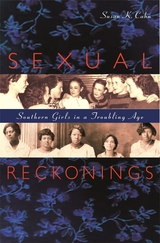 Sexual Reckonings: Southern Girls in a Troubling Age
Susan K. Cahn
Harvard University Press, 2012 Sexual Reckonings is the fascinating tale of adolescent girls coming of age in the South during the most explosive decades for the region. Focusing on the period from 1920 to 1960, Susan Cahn reveals how both the life of the South and the meaning of adolescence underwent enormous political, economic, and social shifts. Those years witnessed the birth of a modern awareness of adolescence and female sexuality that clashed mightily with the white supremacist and patriarchal legacies of the old South. As youth staked its claim, the bodies and beliefs of southern girls became the battlefield for a transformed South, which was, like them, experiencing growing pains.
Cahn reveals how young women, both white and black, were seen as the South's greatest hope and its greatest threat. Viewed as critical actors in every regional crisis, from the economic recession and urban migrations of the 1920s to the racial conflicts precipitated by school desegregation in the 1950s, female teenagers became the conspicuous subjects of social policy and regional imagination. All the while, these adolescents pursued their own desires and discovered their own meanings, creating cracks in the twin pillars of the Jim Crow South--"racial purity" and white male dominance--that would soon be toppled by the student-led civil rights movement.
Sexual Reckonings is an amazingly intimate look at a time of deep personal exploration and profound cultural change for southern girls and for the society they inhabited, a powerful account of the clash between a society's fears and the daily lives and aspirations of its most prized, and unpredictable, population.
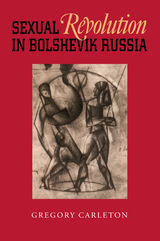 Sexual Revolution in Bolshevik Russia
Gregory Carleton
University of Pittsburgh Press, 2004
Gregory Carleton offers a comprehensive literary and cultural history of sex and society in the Soviet Union during the 1920s. The Bolshevik Revolution promised a total transformation of Russian society, down to its most intimate details. But in the years immediately following 1917, it was by no means clear how this would come about. Sex and sexuality became a crucial battleground for debates about the Soviet future, and literature emerged as a primary domain through which sex could be imagined and discussed.
Despite optimistic claims that bolshevism would overcome bourgeois depravity, the writings of the 1920s in all genres were awash in sexual adventure, promiscuity, various chauvinisms, date and gang rape, unwanted pregnancy, and sexually transmitted diseases, as well as sex-related alcohol abuse, depression, and suicide. In discussions about sex, party officials contradicted themselves, sociologists grappled with difficult social problems, and writers experimented in fictional form with modern identities and relationships.
Drawing on an uncommonly varied body of sources, including novels, journals, diaries, sociological research, public health brochures, surveys, and party documents-many examined here for the first time in English-Carleton reveals the dramatic, bizarre, and intriguing ways the sexual revolution was discussed and represented. Amidst this chaos, he discerns a historical process of codification and reaction, leading ultimately to the quelling of debate in the 1930s through the harsh dictates of Stalinism.
Sexual Revolution in Bolshevik Russia challenges Western writers who portray revolutionary Russia as either prudish or hedonistic by reconstructing a fuller picture of what circulated in Bolshevik culture and why. Carleton brings a complex human dimension to the subject, demonstrating that this controversy should not be viewed as a sideshow curiosity, but rather as a central aspect of the dramatic debates on early Soviet literature and culture.
 Sexual Science and the Law
Richard Green
Harvard University Press, 1992 A rape victim charges that pornography caused her attacker to become a sex offender. A lesbian mother fights for custody of her child. A transsexual pilot is fired by a commercial airline after undergoing sex change and sues for sex discrimination. A homosexual is denied employment because of sexual orientation. A woman argues that her criminal behavior should be excused because she suffers from premenstrual syndrome. The law has much to say about sexual behavior, but what it says is rarely influenced by the findings of social science research over recent decades. This book focuses for the first time on the dynamic interplay between sexual science and legal decisionmaking.
Reflecting the author's wide experience as a respected sex researcher, expert witness, and lawyer, Sexual Science and the Law provides valuable insights into some of the most controversial social and sexual topics of our time. Drawing on an exhaustive knowledge of the relevant research and citing extensively from case law and court transcripts, Richard Green demonstrates how the work of sexual science could bring about a transformation in jurisprudence, informing the courts in their deliberations on issues such as sexual privacy, homosexuality, prostitution, abortion, pornography, and sexual abuse.
In each case he considers, Green shows how the law has been shaped by social science or impoverished by reliance on conjecture and received wisdom. He examines the role of sexual science in legal controversy, its analysis of human motivation and behavior, and its use by the courts in determining the relative weight to be given the desires of the individual, the standards of society, and the power of the state in limiting sexual autonomy. Unprecedented in its portrayal of sexuality in a legal context, this scholarly but readable book will interest and educate professional and layperson alike—those lawyers, judges, sex educators, therapists, patients, and citizens who find themselves standing nonplussed at the meeting place of morality and behavior.
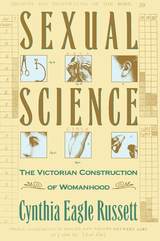 Sexual Science: The Victorian Constuction of Womanhood
Cynthia Russett
Harvard University Press, 1991 One scarcely knows whether to laugh or cry. The spectacle presented, in Cynthia Russett's splendid book, of nineteenth-century white male scientists and thinkers earnestly trying to prove women inferior to men--thereby providing, along with "savages" and "idiots," an evolutionary buffer between men and animals--is by turns appalling, amusing, and saddening. Surveying the work of real scientists as well as the products of more dubious minds, Russett has produced a learned yet immensely enjoyable chapter in the annals of human folly.
At the turn of the century science was successfully challenging the social authority of religion; scientists wielded a power no other group commanded. Unfortunately, as Russett demonstrates, in Victorian sexual science, empiricism tangled with prior belief, and scientists' delineation of the mental and physical differences between men and women was directed to show how and why women were inferior to men. These men were not necessarily misogynists. This was an unsettling time, when the social order was threatened by wars, fierce economic competition, racial and industrial conflict, and the failure of society to ameliorate poverty, vice, crime, illnesses. Just when men needed the psychic lift an adoring dependent woman could give, she was demanding the vote, higher education, and the opportunity to become a wage earner!
No other work has treated this provocative topic so completely, nor have the various scientific theories used to marshal evidence of women's inferiority been so thoroughly delineated and debunked. Erudite enough for scholars in the history of science, intellectual history, and the history of women, this book with its stylish presentation will also attract a large nonspecialist audience.
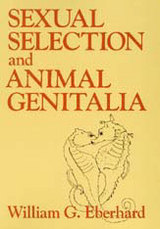 Sexual Selection and Animal Genitalia
William G. Eberhard
Harvard University Press, 1985 As Darwin first pointed out, two distinct evolutionary processes have contributed to the diversity of form and function in plants and animals: natural selection and sexual selection. In this book William Eberhard presents a new theory that explains male genitalic evolution as a result of sexual selection. From flatworms to fish, from moths to rodents, animal genitalia display an extraordinary variety of baroque morphologies. Not only are the forms varied, they have diverged rapidly in the course of evolution.
Why such strange forms and such rapid divergence? These questions have puzzled evolutionary biologists and animal taxonomists for over a century, and several hypotheses have been proposed. Eberhard shows that none of the explanations is adequate and proposes a new hypothesis. He views genitalia as courtship devices that function in the competition for mates by influencing the females' choices of fathers for their offspring. To the extent that male genitalic structures affect female choices, male genitalia are subject to the same type of runaway selection as that on structures, such as the peacock's tail, used in precopulatory courtship.
Eberhard's hypothesis can explain the fact that in a vast range of animals, from nematodes to mammals, male genitalia tend to be more complex than female genitalia, are often more elaborate than would be required for simply introducing sperm into the female's body, and have diverged rapidly and are thus highly species-specific in form. Although the emphasis is on theoretical explanations, many examples are presented of the vast diversity of animal genitalia: squids with arms whose tips break off and swim around inside the female after introducing an explosive, grenade-like sperm packet into her; flatworms that have rows of penes despite the presence of only a single female aperture; damselflies that give their mates contraceptive douches prior to inseminating them; and female seahorses with penes.
 The Sexual Self: The Construction of Sexual Scripts
Michael Kimmel
Vanderbilt University Press, 2007 In the late 1960s two sociologists, John Gagnon and William Simon, developed the concept of sexual scripts as part of a larger project of treating sexuality like any other social phenomenon. In the end, their vision of social construction turned Kinsey on his head, and their model became the dominant paradigm of social science inquiry into human sexuality, and spurred the development of an entire field of Sexuality Studies. Sexual activity, they argued, was like other social processes, yet one of increasing importance in the construction of the self. Michael Kimmel has gathered together essays from three generations of scholars influenced by this perspective on sexuality. These include many of the foremost social scientists writing and researching sexuality today. The book begins with Kimmel's reflections on the unusual careers of Gagnon and Simon, examines the construction of both sexual identity and sexual behaviors in a variety of settings, and ends with the two of them speaking in their own provocative voices about their perspective in interviews conducted originally for a German journal in 1998.
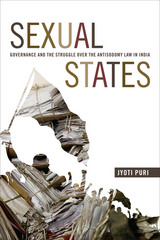 Sexual States: Governance and the Struggle over the Antisodomy Law in India
Jyoti Puri
Duke University Press, 2016 In Sexual States Jyoti Puri tracks the efforts to decriminalize homosexuality in India to show how the regulation of sexuality is fundamentally tied to the creation and enduring existence of the state. Since 2001 activists have attempted to rewrite Section 377 of the Indian Penal Code, which in addition to outlawing homosexual behavior is often used to prosecute a range of activities and groups that are considered perverse. Having interviewed activists and NGO workers throughout five metropolitan centers, investigated crime statistics and case law, visited various state institutions, and met with the police, Puri found that Section 377 is but one element of how homosexuality is regulated in India. This statute works alongside the large and complex system of laws, practices, policies, and discourses intended to mitigate sexuality's threat to the social order while upholding the state as inevitable, legitimate, and indispensable. By highlighting the various means through which the regulation of sexuality constitutes India's heterogeneous and fragmented "sexual state," Puri provides a conceptual framework to understand the links between sexuality and the state more broadly.
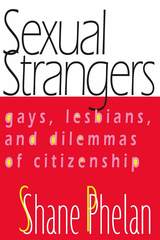 Sexual Strangers: Gays, Lesbians, and Dilemmas of Citizenship
Shane Phelan
Temple University Press, 2001 Is the United States a heterosexual regime? If it is, how may we understand the political position of those who cannot or will not align themselves with heterosexuality? With these provocative questions, Shane Phelan raises the issue of whether lesbians, gays, bisexuals, and transgendered people can be seen as citizens at all. Can citizenship be made queer? Or does citizenship require the exclusion of those who are regarded as queer to preserve the "equality" that it promises?
In Sexual Strangers, Shane Phelan argues that, in the United States, queers are strangers -- not exactly the enemy, since they are not excluded from all rights of citizenship, but not quite members. Rather, they are ambiguous figures who trouble the border between "us" and "them," a border just as central to liberal regimes as to other states. Life on this border structures both the exclusion of sexual minorities and their ambivalence about becoming part of the "mainstream."
Sexual Strangers addresses questions of long-standing importance to minority group politics: the meaning and terms of inclusion, respect, and resistance. Phelan looks at citizenship as including not only equal protection and equal rights to such institutions as marriage and military service, but also political and cultural visibility, as inclusion in the national imaginary. She discusses the continuing stigmatization of bisexuals and transgendered people within lesbian and gay communities as a result of the attempt to flee from strangeness, a flight that inevitably produces new strangers. Her goal is to convince students of politics, both academic and activist, to embrace the rewards of strangeness as a means of achieving inclusive citizenship, rather than a citizenship that defines itself by what it will not accept.
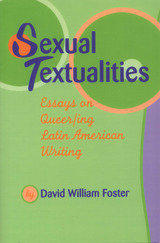 Sexual Textualities: Essays on Queer/ing Latin American Writing
By David William Foster
University of Texas Press, 1997 Since the 1991 publication of his groundbreaking book Gay and Lesbian Themes in Latin American Writing, David William Foster has proposed a series of theoretical and critical principles for the analysis of Latin American culture from the perspectives of the queer. This book continues that project with a queer reading of literary and cultural aspects of Latin American texts. Moving beyond its predecessor, which provided an initial inventory of Latin American gay and lesbian writing, Sexual Textualities analyzes questions of gender representation in Latin American cultural productions to establish the interrelationships, tensions, and irresolvable conflicts between heterosexism and homoeroticism. The topics that Foster addresses include Eva Peron as a cultural/sexual icon, feminine pornography, Luis Humberto Hermosillo's classic gay film Doña Herlinda y su hijo, homoerotic writing and Chicano authors, Matias Montes Huidobro's Exilio and the representation of gay identity, representation of the body in Alejandra Pizarnik's poetry, and the crisis of masculinity in Argentine fiction from 1940 to 1960.
Sexual Violence against Jewish Women during the Holocaust
Edited by Sonja M. Hedgepeth and Rochelle G. Saidel
Brandeis University Press, 2010 Using testimonies, Nazi documents, memoirs, and artistic representations, this volume broadens and deepens comprehension of Jewish women’s experiences of rape and other forms of sexual violence during the Holocaust. The book goes beyond previous studies, and challenges claims that Jewish women were not sexually violated during the Holocaust. This anthology by an interdisciplinary and international group of scholars addresses topics such as rape, forced prostitution, assaults on childbearing, artistic representations of sexual violence, and psychological insights into survivor trauma. These subjects have been relegated to the edges or completely left out of Holocaust history, and this book aims to shift perceptions and promote new discourse.
 Sexual Violence and American Manhood
T. Walter Herbert
Harvard University Press, 2002 Taking up topics as diverse and timely as the work of FBI profilers, the pornography debates, feminist analyses of male supremacy as sexual abuse, the ritual meanings of fraternity gang rape, and the interplay of racial and sexual injustice, T. Walter Herbert illuminates the chronic masculine anxieties that seek compensation in fantasies of sexual coercion and in sexual offenses against women. His work offers an unusually clear view of this prevailing convention of insecure and destructive masculinity, which Herbert connects with contemporary analyses of male identity formation, sexuality, and violence and with cultural, political, and ideological developments reaching back to the nation's democratic beginnings.
Reading iconic nineteenth-century texts by Whitman, Hawthorne, and Stowe, and pursuing the articulation of their gender logic in Richard Wright's Native Son, Herbert traces a gender ideology of dominance and submission, its persistence in masculine subcultures like the military and big-time football, and its debilitating effects on imaginations and lives in our own day. In materials as diverse as Hannah Foster's post-Revolutionary War novel The Coquette and the Coen brothers' 1996 movie Fargo, this book taps into popular culture and high art alike to outline the logic of American manhood's violent streak--and its dire consequences for a culture with truly democratic and egalitarian ambitions.
Sexual Visions: Images Of Gender In Science And Medicine Between The Eighteenth And Twentieth Centuries
Ludmilla Jordanova
University of Wisconsin Press, 1993 In six interdisciplinary and wide-ranging essays, Ludmilla Jordanova analyzes scientific and medical representations of gender in advertising, paintings, film, literature, sculpture, wax anatomical models, and professional and popular writing about the biological and medical sciences during the eighteenth and nineteenth centuries. She demonstrates that gender as metaphor has had an exceptionally vigorous life in the history of natural knowledge.
 Sexuality across the Life Course
Edited by Alice S. Rossi
University of Chicago Press, 1994 How does sexual behavior change over one's life-span? How does sexual satisfaction affect the quality and stability of marriage? How has the AIDS epidemic affected sexual attitudes in America over the past three decades?
In this wide-reaching volume, distinguished sociologist Alice S. Rossi addresses these questions and others through fourteen diverse essays on sexual behavior, covering adolescence through old age and studying such groups as singles, married couples, and homosexuals. This extensive study also explores the effects of chronic disease and medication on sexual functioning, recent developments in psychotherapy for sexual problems, and sexual abuse of children, incest, and rape.
"The interdisciplinary nature of the project has resulted in a text that is accessible to anyone with a behavioral science background. Well written, well edited, and well received by this reviewer."—Joan C. Chrisler, Journal of Sex & Marital Therapy
"This is a book that needs to be on the bookshelf of any AIDS researcher."—AIDS Book Review Journal
Sexuality and Authority in the Catholic Church
Monica Migliorino Miller
University of Scranton Press, 1995 Monica Migliorino Miller articulates a theology that breaks open the essence of ecclesial authority. Authority, if it is authority at all, derives from and exists for authentic Christian worship, namely, the Holy Eucharist.
If authority is derived from Eucharistic worship, then authority is fundamentally the authority of a covenant. This book shows that this covenant is spoken according to a primordial sexual language rooted in creation itself.
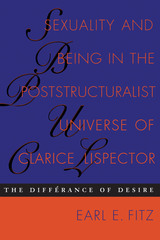 Sexuality and Being in the Poststructuralist Universe of Clarice Lispector: The Différance of Desire
By Earl E. Fitz
University of Texas Press, 2001 Driven by an unfulfilled desire for the unattainable, ultimately indefinable Other, the protagonists of the novels and stories of acclaimed Brazilian writer Clarice Lispector exemplify and humanize many of the issues central to poststructuralist thought, from the nature of language, truth, and meaning to the unstable relationships between language, being, and reality. In this book, Earl Fitz demonstrates that, in turn, poststructuralism offers important and revealing insights into all aspects of Lispector's writing, including her style, sense of structure, characters, themes, and socio-political conscience. Fitz draws on Lispector's entire oeuvre—novels, stories, crônicas, and children's literature—to argue that her writing consistently reflects the basic tenets of poststructuralist theory. He shows how Lispector's characters struggle over and humanize poststructuralist dilemmas and how their essential sense of being is deeply dependent on a shifting, and typically transgressive, sense of desire and sexuality.
Sexuality and Feminism in Shelley
Nathaniel Brown
Harvard University Press, 1979 More than a literary study, this book is an analysis of sexual attitudes and practices in the Romantic period, and a contribution to the history and theory of feminism. Shelley is shown to have anticipated in many ways the work of modern students of human sexual behavior. He was strikingly ahead of his time in his attitude toward women: his ideal of love postulated the equality of the sexes, and his theory of psychosexual identification, like mated to like, extended the feminist ideology of his mother-in-law, Mary Wollstonecraft. Moreover, in his own person and practice he came close to the androgynous ideal of the modern woman's movement.
In exploring the many aspects of his subject, Brown compares Shelley with his contemporaries, particularly Byron, and draws upon extensive research into the laws, ideas, and practices of the period.
Sexuality and Form: Caravaggio, Marlowe, and Bacon
Graham Hammill
University of Chicago Press, 2000 This ambitious, wide-ranging study of sexuality, aesthetics, and epistemology covers everything from the aesthetics of war to the works of Caravaggio, Michaelangelo, Christopher Marlowe, and Francis Bacon, synthesizing queer theory and psychoanalysis and demonstrating the role of the body and the flesh as both a problem and a promise within the narrative arts.
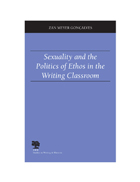 Sexuality and the Politics of Ethos in the Writing Classroom
Zan Meyer Goncalves
Southern Illinois University Press, 2005 Applying the complexities of literacy development and personal ethos to the teaching of composition, Zan Meyer Goncalves challenges writing teachers to consider ethos as a series of identity performances shaped by the often-inequitable social contexts of their classrooms and communities. Using the rhetorical experiences of students who identify as lesbian, gay, bisexual, and/or transgender, she proposes a new way of thinking about ethos that addresses the challenges of social justice, identity, and transfer issues in the classroom. Goncalves offers an innovative approach to teaching identity performance theory bound by social contexts. She applies this new approach to theories of specificity and intersectionality, illustrating how teachers can help students redefine the relationship between their social identities and their writing. She also addresses bringing social activism and identity politics into the classroom, helping writers make transfers across rhetorical contexts and linking students' interests to public conversations. Theoretical and practical, Sexuality and the Politics of Ethos in the Writing Classroom provides teachers of first-year and advanced composition studies with useful, detailed assignments based in specific identity performance. Goncalves offers techniques to subvert oppressive language practices, while encouraging students to recognize themselves as writers, citizens, and active participants in their own educations and communities.
 Sexuality and the Rise of China: The Post-1990s Gay Generation in Hong Kong, Taiwan, and Mainland China
Travis S. K. Kong
Duke University Press, 2023 In Sexuality and the Rise of China Travis S. K. Kong examines the changing meanings of same-sex identities, communities, and cultures for young Chinese gay men in contemporary Hong Kong, Taiwan, and mainland China. Drawing on ninety life stories, Kong’s transnational queer sociological approach shows the complex interplay between personal biography and the dramatically changing social institutions in these three societies. Kong conceptualizes coming out as relational politics and the queer/tongzhi community and commons as an affective, imaginative means of connecting, governed by homonormative masculinity. He shows how monogamy is a form of cruel optimism and envisions state and sexuality intertwining in different versions of homonationalism in each location. Tracing the alternately diverging and converging paths of being young, "Chinese," gay, and male, Kong reveals how both Western and emerging inter- and intra- Asian queer cultures shape queer/tongzhi experiences. Most significantly, at this historical juncture characterized by the rise of China, Kong criticizes the globalization of sexuality by emphasizing inter-Asia modeling, referencing, and solidarities and debunks the essentializing myth of Chineseness, thereby decolonizing Western sexual knowledge and demonstrating the differential meanings of Chineseness/queerness across the Sinophone world.
Sexuality, Disability, and Aging: Queer Temporalities of the Phallus
Jane Gallop
Duke University Press, 2019 Drawing on her own experiences with late-onset disability and its impact on her sex life, along with her expertise as a cultural critic, Jane Gallop explores how disability and aging work to undermine one's sense of self. She challenges common conceptions that equate the decline of bodily potential and ability with a permanent and irretrievable loss, arguing that such a loss can be both temporary and positively transformative. With Sexuality, Disability, and Aging, Gallop explores and celebrates how sexuality transforms and becomes more queer in the lives of the no longer young and the no longer able while at the same time demonstrating how disability can generate new forms of sexual fantasy and erotic possibility.
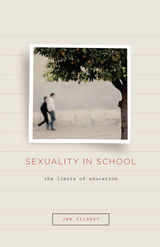 Sexuality in School: The Limits of Education
Jen Gilbert
University of Minnesota Press, 2014 From concerns over the bullying of LGBTQ youth and battles over sex education to the regulation of sexual activity and the affirmation of queer youth identity, sexuality saturates the school day. Rather than understand these conflicts as an interruption to the work of education, Jen Gilbert explores how sexuality comes to bear on and to enliven teaching and learning. Gilbert investigates the breakdowns, clashes, and controversies that flare up when sexuality enters spaces of schooling. Education must contain the volatility of sexuality, Gilbert argues, and yet, when education seeks to limit the reach of sexuality, it risks shutting learning down. Gilbert penetrates this paradox by turning to fiction, film, legal case studies, and personal experiences. What, she asks, can we learn about school from a study of sexuality? By examining the strange workings of sexuality in schools, Gilbert draws attention to the explosive but also compelling force of erotic life in teaching and learning. Ultimately, this book illustrates how the most intimate of our experiences can come to shape how we see and act in the world.
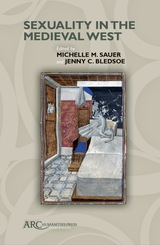 Sexuality in the Medieval West
Michelle M. Sauer
Arc Humanities Press, 2025 This invaluable reference work addresses sex, gender, and sexuality in medieval Europe and North Africa, providing an important update to collections of the 1990s. With lucid definitions, theoretical engagement, and wide geographic coverage, it is the new indispensable guide to the subject. The editors and authors establish institutional foundations and explore expressions of sex and sexuality across medieval cultures, analyzing examples from legal, religious, artistic, literary, medical, and other sources. The collection begins with a section devoted to definitions and vocabulary before progressing to cultural topics and concluding with geographically-specific traditions and practices related to sexuality. Essays authored by specialists in relevant fields include both primary and secondary sources, contain examinations of the three major religions, and address broader cultural and historical ramifications of these topics.
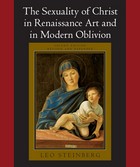 The Sexuality of Christ in Renaissance Art and in Modern Oblivion
Leo Steinberg
University of Chicago Press, 1996 Originally published in 1983, Leo Steinberg's classic work has changed the viewing habits of a generation. After centuries of repression and censorship, the sexual component in thousands of revered icons of Christ is restored to visibility. Steinberg's evidence resides in the imagery of the overtly sexed Christ, in Infancy and again after death. Steinberg argues that the artists regarded the deliberate exposure of Christ's genitalia as an affirmation of kinship with the human condition. Christ's lifelong virginity, understood as potency under check, and the first offer of blood in the circumcision, both required acknowledgment of the genital organ. More than exercises in realism, these unabashed images underscore the crucial theological import of the Incarnation.
This revised and greatly expanded edition not only adduces new visual evidence, but deepens the theological argument and engages the controversy aroused by the book's first publication.
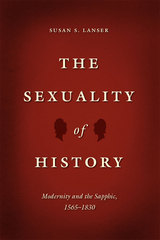 The Sexuality of History: Modernity and the Sapphic, 1565-1830
Susan S. Lanser
University of Chicago Press, 2014 The period of reform, revolution, and reaction that characterized seventeenth- and eighteenth-century Europe also witnessed an intensified interest in lesbians. In scientific treatises and orientalist travelogues, in French court gossip and Dutch court records, in passionate verse, in the rising novel, and in cross-dressed flirtations on the English and Spanish stage, poets, playwrights, philosophers, and physicians were placing sapphic relations before the public eye.
In The Sexuality of History, Susan S. Lanser shows how intimacies between women became harbingers of the modern, bringing the sapphic into the mainstream of some of the most significant events in Western Europe. Ideas about female same-sex relations became a focal point for intellectual and cultural contests between authority and liberty, power and difference, desire and duty, mobility and change, order and governance. Lanser explores the ways in which a historically specific interest in lesbians intersected with, and stimulated, systemic concerns that would seem to have little to do with sexuality. Departing from the prevailing trend of queer reading whereby scholars ferret out hidden content in “closeted” texts, Lanser situates overtly erotic representations within wider spheres of interest. The Sexuality of History shows that just as we can understand sexuality by studying the past, so too can we understand the past by studying sexuality.
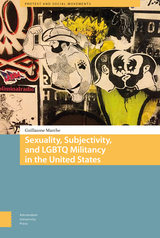 Sexuality, Subjectivity, and LGBTQ Militancy in the United States
Guillaume Marche
Amsterdam University Press, 2019 As LGBTQ movements in Western Europe, North America, and other regions of the world are becoming increasingly successful at awarding LGBTQ people rights, especially institutional recognition for same-sex couples and their families, what becomes of the deeper social transformation that these movements initially aimed to achieve? The United States is in many ways a paradigmatic model for LGBTQ movements in other countries. Sexuality, Subjectivity, and LGBTQ Militancy in the United States focuses on the transformations of the US LGBTQ movement since the 1980s, highlighting the relationship between its institutionalization and the disappearance of sexuality from its most visible claims, so that its growing visibility and legitimation since the 1990s have paradoxically led to a decrease in grassroots militancy. The book examines the issue from the bottom up, identifying the links between the varying importance of sexuality as a movement theme and actors’ mobilization, and enhances the import of subjectivity in militancy. It draws attention to cultural, sometimes infrapolitical, forms of militancy that perpetuate the role of sexuality in LGBTQ militancy.
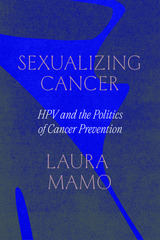 Sexualizing Cancer: HPV and the Politics of Cancer Prevention
Laura Mamo
University of Chicago Press, 2023 The virus that changed how we think about cancer and its culprits—and the vaccine that changed how we talk about sex and its risks.
Starting in 2005, people in the US and Europe were inundated with media coverage announcing the link between cervical cancer and the sexually transmitted virus HPV. Within a year, product ads promoted a vaccine targeting cancer’s viral cause, and girls and women became early consumers of this new cancer vaccine. An understanding of HPV’s broadening association with other cancers led to the identification of new at-risk populations—namely boys and men—and ignited a plethora of gender and sexual issues related to cancer prevention.
Sexualizing Cancer is the first book dedicated to the emergence and proliferation of the HPV vaccine along with the medical capacity to screen for HPV—crucial landmarks in the cancer prevention arsenal based on a novel connection between sex and chronic disease. Interweaving accounts from the realms of biomedical science, public health, and social justice, Laura Mamo chronicles cervical cancer’s journey out of exam rooms and into public discourse. She shows how the late twentieth-century scientific breakthrough that identified the human papilloma virus as having a causative role in the onset of human cancer galvanized sexual politics, struggles for inclusion, new at-risk populations, and, ultimately, a new regime of cancer prevention. Mamo reveals how gender and other equity arguments from within scientific, medical, and advocate communities shaped vaccine guidelines, clinical trial funding, research practices, and clinical programs, with consequences that reverberate today. This is a must-read history of medical expansion—from a “woman’s disease” to a set of cancers that affect all genders—and of lingering sexualization, with specific gendered, racialized, and other contours along the way.
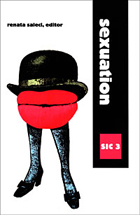 Sexuation: SIC 3
Renata Salecl, ed.
Duke University Press, 2000 Contemporary discourse seems to provide a choice in the way sexual identities and sexual difference are described and analyzed. On the one hand, much current thinking suggests that sexual identity is fluid—socially constructed and/or performatively enacted. This discourse is often invoked in the act of overcoming an earlier patriarchal era of fixed and naturalized identities. On the other hand, some modern discourses of sexual identity seem to offer a New Age Jungian re-sexualization of the universe—"Men are from Mars, and women are from Venus"—according to which there is an underlying, deeply anchored archetypal identity that provides a kind of safe haven in the contemporary confusion of roles and identities. In this volume, contributors discuss a third way of thinking about sexual identity and sexual difference—a direction opened by Jacques Lacan. For Lacan, what we all recognize as sexual difference is first and foremost representative of a certain fundamental deadlock inherent in the symbolic order, that is, in language and in the entire realm of culture conceived as a symbol system structured on the model of language. For him, the logical matrix of this deadlock is provided by his own formulas of sexuation. The essays collected here elaborate on different aspects of this deadlock of sexual difference. While some examine the role of semblances in the relation between the sexes or consider sexual identity not as anatomy but still involving an impasse of the real, others discuss the difference between sexuation and identification, the role of symbolic prohibition in the process of the subject’s sexual formation, or the changed role of the father in contemporary society and the impact of this change on sexual difference. Other essays address such topics as the role of beating in sexual fantasies and jouissance in feminine jealousy. Contributors. Alain Badiou, Elizabeth Bronfen, Darian Leader, Jacques Alain Miller, Genevieve Morel, Renata Salecl, Eric L. Santner, Colette Soler, Paul Verhaeghe, Slavoj Žižek, Alenka Zupancic
Sexy Dressing Etc.
Duncan Kennedy
Harvard University Press, 1993 Duncan Kennedy argues that an American radicalism is both possible and desirable. One base for radical politics is the big institutional workplace; another is popular culture—whence his emphasis on phenomena like sexy dressing. Kennedy’s aim is to wed the rebelliousness, irony, and irrationalism of cultural modernism and postmodernism to the earnestness of political correctness.
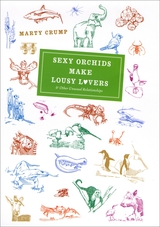 Sexy Orchids Make Lousy Lovers: & Other Unusual Relationships
Marty Crump
University of Chicago Press, 2009 Vampire bats that regurgitate blood for roosting buddies. Mosquitoes that filch honeydew droplets from ants. Reptiles that enforce chastity on their lovers with copulatory plugs. Capuchin monkeys that use millipede secretions as mosquito repellent. The natural world is full of unusual relationships, and negotiation between life-forms striving to survive is evolution at its most diverse, entertaining, and awe-inspiring. Picking up where her highly popular Headless Males Make Great Lovers left off, tropical field biologist Marty Crump takes us on another voyage of discovery into the world of unusual natural histories, this time focusing on extraordinary interactions involving animals, plants, fungi, and bacteria. Sexy Orchids Make Lousy Lovers& Other Unusual Relationships illuminates the ceaseless give-and-take between species. Occasionally, both interacting parties benefit, like when hornbills and dwarf mongooses hunt together for food. Other times, like when mites ride in hummingbirds’ nostrils to reach their next meal of nectar, one individual benefits and the other is neither helped nor harmed. But sometimes one individual benefits at the expense of the other; you need only recall your last sinus infection to understand how that works. Throughout, Crump brings her trademark spunk and zest to these stories of intimate exchange. She introduces readers to penguins that babysit, pseudoscorpions that ride and mate under the wings of giant harlequin beetles, and parasitic fungi that bend insects to their will. A lively companion to Crump’s earlier work, Sexy Orchids Make Lousy Lovers& Other Unusual Relationships captures the bizarre and befuddling aspects of the behavior of animals, plants, and microbes. After this entertaining romp through the world of natural relationships, you’ll never look at an orchid the same way again.
SF: The Other Side of Realism
Thomas D. Clareson
University of Wisconsin Press, 1971 A collection of twenty-five essays from eight countries, illustrating the many approaches to science fiction.
SF6 Switchgear
H.M. Ryan
The Institution of Engineering and Technology, 1989 This book provides an extensive review of recent developments in SF6 Switchgear and covers fundamental properties of SF6 interrupter types, characteristics and associated operating mechanisms, arc modelling and computer aided methods for interrupter design and evaluation. The impact of SF6 Technology upon (i) Transmission Switchgear (ii) Distribution and Utility Switchgear and (iii) Regulations, Testing and Instrumentation is dealt with comprehensively.
Shababz!: A Graphic Journey Through Islamic Feminism
Lana Sirri
Amsterdam University Press, 2025 Join the four protagonists on an exciting journey as they dive into the most current discussions about Islam and feminism, typically reserved for academia and specialized feminists. Zahra proudly wears the hijab and challenges the widespread assumption that Islam and feminism are mutually exclusive. Hamza, on the other hand, faces various toxic stereotypes about masculinity and the roles he is expected to perform. Mariama, as a Black Muslim woman, grapples with how her world is shaped by colonialism and discrimination. And Amari finds their own path through the seemingly rigid categories of sexuality and gender. This interactive graphic novel invites readers to engage with important conversations on Islam, gender and sexuality, and shows how young people can make a difference in society.
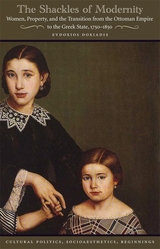 The Shackles of Modernity: Women, Property, and the Transition from the Ottoman Empire to the Greek State, 1750–1850
Evdoxios Doxiadis
Harvard University Press, 2011 This book explores the relationship between women and property in the Greek lands and their broader social position in the century that culminated with the establishment of the national Greek state (1750–1850). Evdoxios Doxiadis focuses on the status and rights of Greek women in the later Ottoman period, the decade-long Greek War of Independence, and the first decades of the Greek state, seeking to reveal the impact that the pursuit of modernization by the early Greek governments had on women. Through the systematic examination of numerous legal documents in notarial archives from four distinct regions (Naxos, Mykonos, Athens, and Leonidio), the position of women in Greek societies of the period is illuminated in all its complexity and regional diversity. Special emphasis is placed on women’s ability in some areas to defend their property rights and be active economic agents.
Although the Greek revolutionaries and the Greek state did not curtail the rights of women with respect to property, the very institutions that were fundamental in the creation of the Greek state transformed the established relationship between women and property. Doxiadis shows that modernization proved to be an oppressive force for Greek women—though in a much more clandestine fashion than perhaps expected in other European states.
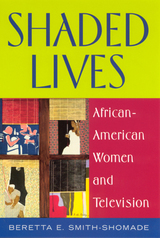 Shaded Lives: African American Women and Television
Beretta E Smith-Shomade
Rutgers University Press, 2002 Since its invention, television has been one of the biggest influences on American culture. Through this medium, multiple visions and disparate voices have attempted to stake a place in viewer consumption. Yet even as this programming supposedly reflects characteristics of the general American populace, television-generated images are manipulated and contradictory, predicated by the various economic, political, and cultural forces placed upon it. In Shaded Lives, Beretta Smith-Shomade sets out to dissect images of the African American woman in television from the 1980s. She calls their depiction "binaristic," or split. African American women, although an essential part of television programming today, are still presented as distorted and deviant. By closely examining the television texts of African-American women in comedy, music video, television news and talk shows (Oprah Winfrey is highlighted), Smith-Shomade shows how these voices are represented, what forces may be at work in influencing these images, and what alternate ways of viewing might be available. Smith-Shomade offers critical examples of where the sexist and racist legacy of this country collide with the cultural strength of Black women in visual and real-lived culture. As the nation's climate of heightened racial divisiveness continues to relegate the representation of Black women to depravity and display, her study is not only useful, it is critical.
 Shade-Grown Slavery: The Lives of Slaves on Coffee Plantations in Cuba
William C. Van Norman
Vanderbilt University Press, 2013 Within the world of Cuban slave-holding plantations, all enslaved people had to negotiate a life defined by forces beyond their control, and indeed beyond the control of their masters. Slaves on coffee farms survived in ways that allowed them to marry, have children, and maintain and redefine cultural practices that they passed on to their children. Slaves were an important factor in creating a nascent Afro-Cuban culture and identity. In this broad, interdisciplinary study, William Van Norman describes how each type of plantation and the amount of manual labor it required directly influenced the nature of slave life in that community. Slaves on coffee plantations lived in a unique context in comparison to that of their fellow slaves on sugar plantations, one that gave them greater flexibility in cultural and artistic creativity. To gain a deeper understanding of plantation slavery in Cuba, Van Norman explores what life and labor was like for coffee slaves and how it was different from what sugar slaves experienced. Shade-Grown Slavery reconstructs their world and in turn deconstructs the picture we now have of Cuba in the late eighteenth and early nineteenth centuries. Ultimately, Shade-Grown Slavery reveals the lives of enslaved Africans on Cuban coffee plantations and shows how they were able to maintain and transform their cultural traditions in spite of slavery.
Shadeland
Andrew Grace
Ohio State University Press, 2008 Shadeland is not only the name of the Illinois farm on which poet Andrew Grace was raised, it is also that elusive space where language attempts to recover all that has been lost. Deeply concerned with the state of today’s rural spaces, Grace’s poems describe a landscape and a lifestyle that are both eroding. Stylistically rangy, yet united by an ardent eye for intricate imagery, Shadeland features allusions and influences as classical as Homer, Virgil, and Hopkins while still exhibiting a poetic sensibility that is thoroughly contemporary. Employing a blend of baroque and innovative language, these 21st-century pastorals and anti-pastorals both celebrate and elegize the buckshot-peppered silos and unstill cornfields that are quietly vanishing from the countryside.
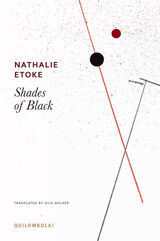 Shades of Black
Nathalie Etoke
Seagull Books, 2021 One might say that the womb of death—the Middle Passage, slavery, and colonization—gave birth to Black populations. Taking this observation as her point of departure, Nathalie Etoke examines Black existence today in her riveting new book, Shades of Black. In a white supremacist world, Black bodies hold a specific position, invested with a range of meaning that maintains them in a fixed role, with a script they did not write. The white world has invented and defined the Black person according to its own interests, endowing her with a bereaved humanity. The Black person is confronted with an essential paradox—exist as Black or as a human being? Does the Black person exist for herself or for the other? In the white world, is the Black race the embodiment of a sub-humanity?
Situated at the crossroads of three countries—Cameroon, France, and, now, the United States—Nathalie Etoke is uniquely positioned for this polyphonic reflection on race. She examines what happens when race obliterates historical, social, cultural, and political differences among populations of African descent from different parts of the world. Focusing on recent and ongoing topics in the United States, including the murder of George Floyd, police brutality, the complex symbolism of Barack Obama and Kamala Harris, Etoke explores the relations of violence, oppression, dispossession, and inequalities that have brought us here, face to face with these existential questions: Are you breathing? Are we breathing?
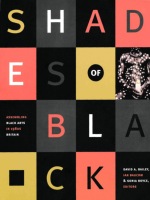 Shades of Black: Assembling Black Arts in 1980s Britain
David A. Bailey, Ian Baucom, and Sonia Boyce, eds.
Duke University Press, 2005 In the 1980s—at the height of Thatcherism and in the wake of civil unrest and rioting in a number of British cities—the Black Arts Movement burst onto the British art scene with breathtaking intensity, changing the nature and perception of British culture irreversibly. This richly illustrated volume presents a history of that movement. It brings together in a lively dialogue leading artists, curators, art historians, and critics, many of whom were actively involved in the Black Arts Movement. Combining cultural theory with anecdote and experience, the contributors debate how the work of the black British artists of the 1980s should be viewed historically. They consider the political, cultural, and artistic developments that sparked the movement even as they explore the extent to which such a diverse body of work can be said to constitute a distinct artistic movement—particularly given that “black” in Britain in the 1980s encompassed those of South Asian, North and sub-Saharan African, and Caribbean descent, referring as much to shared experiences of disenfranchisement as to shades of skin. In thirteen original essays, the contributors examine the movement in relation to artistic practice, public funding, and the transnational art market and consider its legacy for today’s artists and activists. The volume includes a unique catalog of images, an extensive list of suggested readings, and a descriptive timeline situating the movement vis-à-vis relevant artworks and films, exhibitions, cultural criticism, and political events from 1960 to 2000. A dynamic living archive of conversations, texts, and images, Shades of Black will be an essential resource. Contributors. Stanley Abe, Jawad Al-Nawab, Rasheed Araeen, David A. Bailey, Adelaide Bannerman, Ian Baucom, Dawoud Bey, Sonia Boyce, Allan deSouza, Jean Fisher, Stuart Hall, Lubaina Himid, Naseem Khan, susan pui san lok, Kobena Mercer, Yong Soon Min, Keith Piper, Zineb Sedira, Gilane Tawadros, Leon Wainwright, Judith Wilson
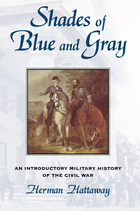 Shades of Blue and Gray: An Introductory Military History of the Civil War
Herman Hattaway
University of Missouri Press, 1997 An introductory military history of the American Civil War, Shades of Blue and Gray places the 1861-1865 conflict within the broad context of evolving warfare. Emphasizing technology and its significant impact, Hattaway includes valuable material on land and sea mines, minesweepers, hand grenades, automatic weapons, the Confederate submarine, and balloons. The evolution of professionalism in the American military serves as an important connective theme throughout. Hattaway extrapolates from recent works by revisionists William Skelton and Roy Roberts to illustrate convincingly that the development of military professionalism is not entirely a post-Civil War phenomenon. The author also incorporates into his work important new findings of recent scholars such as Albert Castel (on the Atlanta Campaign), Reid Mitchell (on soldiers' motivation), Mark Grimsley (on "hard war"), Brooks D. Simpson (on Ulysses S. Grant), and Lauren Cook Burgess (on women who served as soldiers, disguised as men). In addition, Hattaway comments on some of the best fiction and nonfiction available in his recommended reading lists, which will both enlighten and motivate readers. Informative and clearly written, enhanced by graceful prose and colorful anecdotes, Shades of Blue and Gray will appeal to all general readers.
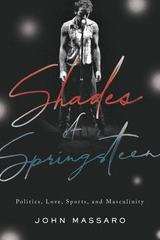 Shades of Springsteen: Politics, Love, Sports, and Masculinity
John Massaro
Rutgers University Press, 2021 One of the secrets to Bruce Springsteen’s enduring popularity over the past fifty years is the way fans feel a deep personal connection to his work. Yet even as the connection often stays grounded in details from his New Jersey upbringing, Springsteen’s music references a rich array of personalities from John Steinbeck to Amadou Diallo and beyond, inspiring fans to seek out and connect with a whole world’s worth of art, literature, and life stories.
In this unique blend of memoir and musical analysis, John Massaro reflects on his experiences as a lifelong fan of The Boss and one of the first professors to design a college course on Springsteen’s work. Focusing on five of the Jersey rocker’s main themes—love, masculinity, sports, politics, and the power of music—he shows how they are represented in Springsteen’s lyrics and shares stories from his own life that powerfully resonate with those lyrics. Meanwhile, paying tribute to Springsteen’s inclusive vision, he draws connections among figures as seemingly disparate as James Joyce, Ta-Nehisi Coates, Thomas Aquinas, Bobby Darin, and Lin-Manuel Miranda. Shades of Springsteen offers a deeply personal take on the musical and cultural legacies of an American icon.
Shades of Sulh: The Rhetorics of Arab-Islamic Reconciliation
Rasha Diab
University of Pittsburgh Press, 2016 Sulh is a centuries-old Arab-Islamic peacemaking process. In Shades of Sulh, Rasha Diab explores the possibilities of the rhetoric of sulh, as it is used to resolve intrapersonal, interpersonal, communal, national, and international conflicts, and provides cases that illustrate each of these domains. Diab demonstrates the adaptability and range of sulh as a ritual and practice that travels across spheres of activity (juridical, extra-juridical, political, diplomatic), through time (medieval, modern, contemporary), and over geopolitical borders (Cairo, Galilee, and Medina). Together, the cases prove the flexibility of sulh in the discourse of peacemaking—and that sulh has remarkable rhetorical longevity, versatility, and richness. Shades of Sulh sheds new light on rhetorics of reconciliation, human rights discourse, and Arab-Islamic rhetorics.
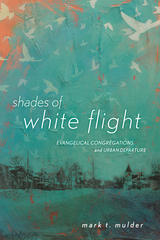 Shades of White Flight: Evangelical Congregations and Urban Departure
Mark T. Mulder
Rutgers University Press, 2015 Since World War II, historians have analyzed a phenomenon of “white flight” plaguing the urban areas of the northern United States. One of the most interesting cases of “white flight” occurred in the Chicago neighborhoods of Englewood and Roseland, where seven entire church congregations from one denomination, the Christian Reformed Church, left the city in the 1960s and 1970s and relocated their churches to nearby suburbs. In Shades of White Flight, sociologist Mark T. Mulder investigates the migration of these Chicago church members, revealing how these churches not only failed to inhibit white flight, but actually facilitated the congregations’ departure.
Using a wealth of both archival and interview data, Mulder sheds light on the forces that shaped these midwestern neighborhoods and shows that, surprisingly, evangelical religion fostered both segregation as well as the decline of urban stability. Indeed, the Roseland and Englewood stories show how religion—often used to foster community and social connectedness—can sometimes help to disintegrate neighborhoods. Mulder describes how the Dutch CRC formed an insular social circle that focused on the local church and Christian school—instead of the local park or square or market—as the center point of the community. Rather than embrace the larger community, the CRC subculture sheltered themselves and their families within these two places. Thus it became relatively easy—when black families moved into the neighborhood—to sell the church and school and relocate in the suburbs. This is especially true because, in these congregations, authority rested at the local church level and in fact they owned the buildings themselves.
Revealing how a dominant form of evangelical church polity—congregationalism—functioned within the larger phenomenon of white flight, Shades of White Flight lends new insights into the role of religion and how it can affect social change, not always for the better.
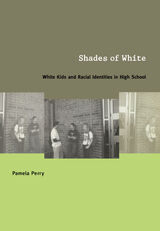 Shades of White: White Kids and Racial Identities in High School
Pamela Perry
Duke University Press, 2002 What does it mean to be young, American, and white at the dawn of the twenty-first century? By exploring this question and revealing the everyday social processes by which high schoolers define white identities, Pamela Perry offers much-needed insights into the social construction of race and whiteness among youth.
Through ethnographic research and in-depth interviews of students in two demographically distinct U.S. high schools—one suburban and predominantly white; the other urban, multiracial, and minority white—Perry shares students’ candor about race and self-identification. By examining the meanings students attached (or didn’t attach) to their social lives and everyday cultural practices, including their taste in music and clothes, she shows that the ways white students defined white identity were not only markedly different between the two schools but were considerably diverse and ambiguous within them as well. Challenging reductionist notions of whiteness and white racism, this study suggests how we might go “beyond whiteness” to new directions in antiracist activism and school reform.
Shades of White is emblematic of an emerging second wave of whiteness studies that focuses on the racial identity of whites. It will appeal to scholars and students of anthropology, sociology, and cultural studies, as well as to those involved with high school education and antiracist activities.
Shading Our Cities: A Resource Guide For Urban And Community Forests
Edited by Gary Moll and Sara Ebenreck; Foreword by Dale Robertson; American Forestry Association
Island Press, 1989 Shading Our Cities is a handbook to help neighborhood groups, local officials, and city planners develop urban forestry projects, not only to beautify their cities, but also to reduce energy demand, improve air quality, protect water supplies, and contribute to healthier living conditions.
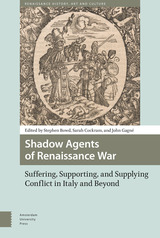 Shadow Agents of Renaissance War: Suffering, Supporting, and Supplying Conflict in Italy and Beyond
Stephen Bowd
Amsterdam University Press, 2023 Who were the shadow agents of Renaissance war? In this pioneering collection of essays scholars use new archival evidence and other sources, including literature, artworks, and other non-textual material, to uncover those men, women, children and other animals who sustained war by means of their preparatory, auxiliary, infrastructural, or supplementary labour. These shadow agents worked in the zone between visibility and invisibility, often moving between civilians and soldiers, and their labour was frequently forced. This volume engages with a range of important debates including: the relationship between war and state formation; the ‘military revolution’ or transformation of early modern military force; the nature of human and non-human agency; gender and war; civilian protection and expulsion; and espionage and diplomacy. The focus of the volume is on Italy, but it includes studies of France and England, and the editors place these themes in a broader European context with the aim of supporting and stimulating research in this field.
 Shadow and Sound: The Historical Thought of a Sumatran People
James Siegel
University of Chicago Press, 1979 Atjeh was a kingdom in northern Sumatra which had a long history of rebellion and unrest. As a Mulim Sultanate from the sixteenth to the nineteenth century, Atjeh engaged in internal political struggle. Since the nineteenth century, Atjeh has been under Dutch, Japanese, or Indonesian control - domination to which the Atjeh never passively yielded. In Shadow and Sound James Siegel arges that the Atjehnese view of history, as expressed in the language of their epic poetry, is based not on the fixing of historical fact, but on a flow of words that is actually immune to the past.
Siegel traces the Atjehnese treatment of history through two epics and a folktale. In his interpretation he goes beyond the idea tht texts such as these are semi-accurate historical documents to show tht tempo, rhythm, rhyme, and melody replace the significance of the content. Furthermore, he uncovers which Atjehnese frameworks - native genres ranging from dream interpretation to conventions of braggadocio
- illuminate their own sense of history.
Siegel first translates one of the important remaining epics on a historical topic, the Hikajat Potjoet Moehamat, and provides an analysis based on the narratve, prosodic structure and his observation of the recitation of epics. He then translates and analyzes two other pieces: a tale entitled Si Meuseukin's Wedding and another epic, the last popular one, Hikajat Prang Sabil. Finally he indicates how a similar treatment of history continues in present-day Atjeh. The analyses demonstrate that in the context of centuries of violence and disruption the Atjehnese have maintained an ability to speak of the past in such ways that it is turned into triumph, not by dwelling on heroic victories but by controlling language.
Siegel's way of looking at the relationship between history and literature will be valuable not only in anthropology but in literary history and comparative studies in literature and politics as well.
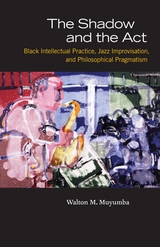 The Shadow and the Act: Black Intellectual Practice, Jazz Improvisation, and Philosophical Pragmatism
Walton M. Muyumba
University of Chicago Press, 2009 Though often thought of as rivals, Ralph Ellison, James Baldwin, and Amiri Baraka shared a range of interests, especially a passion for music. Jazz, in particular, was a decisive influence on their thinking, and, as The Shadow and the Act reveals, they drew on their insights into the creative process of improvisation to analyze race and politics in the civil rights era. In this inspired study, Walton M. Muyumba situates them as a jazz trio, demonstrating how Ellison, Baraka, and Baldwin’s individual works form a series of calls and responses with each other. Muyumba connects their writings on jazz to the philosophical tradition of pragmatism, particularly its support for more freedom for individuals and more democratic societies. He examines the way they responded to and elaborated on that lineage, showing how they significantly broadened it by addressing the African American experience, especially its aesthetics. Ultimately, Muyumba contends, the trio enacted pragmatist principles by effectively communicating the social and political benefits of African Americans fully entering society, thereby compelling America to move closer to its democratic ideals.
Shadow Ball: New and Selected Poems
Charles Harper Webb
University of Pittsburgh Press, 2009 An accessible new and selected collection of poems for poetry insiders and general readers. Powerful, passionate, humorous, and often complex, yet fun to read. They go down easy, but pack a whallop.
|
|
